It happened like this. I rushed through the office and asked, “Where did the photograph from 9402 Pacific Street go to?” As I shuffled through a stack of manilla file folders, my coffee stained case notes and recently delivered mail, I pleaded to no one in particular–“It was teetering right here on the tanker!” Not a soul, of the apparition or man kind, seemed to know or care where I was at in my gumshoe schemes. Despite the most laudable administrative arrangements, from time to time, all of my detective’s plans are dashed. It is an aspect of this architectural sleuthing business which no powers of caution or dexterity seem to be effective. My essential documents always turn up in a day or two but only after I’ve wrongly accused the furry friends, a ghost or Mr. Cassette and by then everyone’s in a fine tiff. Is it worth it to whisper that we all know Mr. Cross sneaks back here to tidy my hotchpotch filing system?
This new, tempting appeal came along in the mail during such a crisis. Mr. Cross, my secretary, had opened the letter and spread it out on my desk where my photograph should have been. It was a weakened moment when I lost all sense of my current P.I. docket.
“We are getting ready to put our home at 1402 S. 78th Street on the market and were told that it was one of the Henning (sic) designed Normandy, France style homes. But, we can find no evidence of this other than similarity in time of being built and design. Just wondering if you came across any information about the house in your work.”
Mr. 1402 Homeowner’s circumstance was certainly curious. Honestly sleuths, I’d never seen or heard of the home in question. A French Normandy house? Stone? Stucco? Half timbering? A tower? The mind reeled… If there was a French gravel pathway with its crushcrushcrush sound involved, I would put aside all exploration and commit to solving the mystery. I made quick work of 1402 South 78th Street’s past real estate photos. I noted an addition/s and other uncertain updates but it was overall a stirring seduction. A drive-by with a proper sniff-about was in order.
But let’s pause at the name drop, before we dig in–as those of you who have been around the block with me in these years know, I have a devotion to long departed Omaha architect, Reinholdt Frederick Hennig. I’ll be frank, I have an architectural crush on him bordering on true love. Hennig was often erroneously called Henning in archival print and possibly in real life as well. While R. F. Hennig is someone that I have uncontrollably gushed about, on occasion, I have highlighted the work of the late, great Frederick A. Henninger. Confusingly F. A. Henninger (F. A. Henninger & Son) was also an Omaha architect. Henninger was arguably the better known in some circles, most assuredly the more prolific. My friend, Randall Smith, had taught me that at his busiest, Henninger had earned the title “House-A-Day Henninger,” because of his remarkable, well publicized productivity. I only make mention of this Hennig-Henning-Henninger sticky wicket surname triptych because it had quite naturally presented itself as a point of dubiety within the originating correspondence of Mr. 1402 Homeowner. A common mistake to be sure, however shortly after, I would begin to read this name muddling as a research omen and this foretoken only served to darken the Normandy footpath lights. Thankfully, we like to stakeout in the obscurity.
The back-story, for those who have just recently joined our sleuthing mission, is that Architect Reinholdt Hennig had built three distinctive, Normandy style country homes in Omaha, based off his purported personal sketches from a true French farmhouse. These three properties were covered in my previous investigation: The Curious Case of the French Fairytale Cottage Part One. Please take up examination at your leisure. The fact that Mr. 1402 Homeowner asked if I knew of their home’s connection to this architectural series, suggested that there was a potential fourth Hennig French house or possibly more…

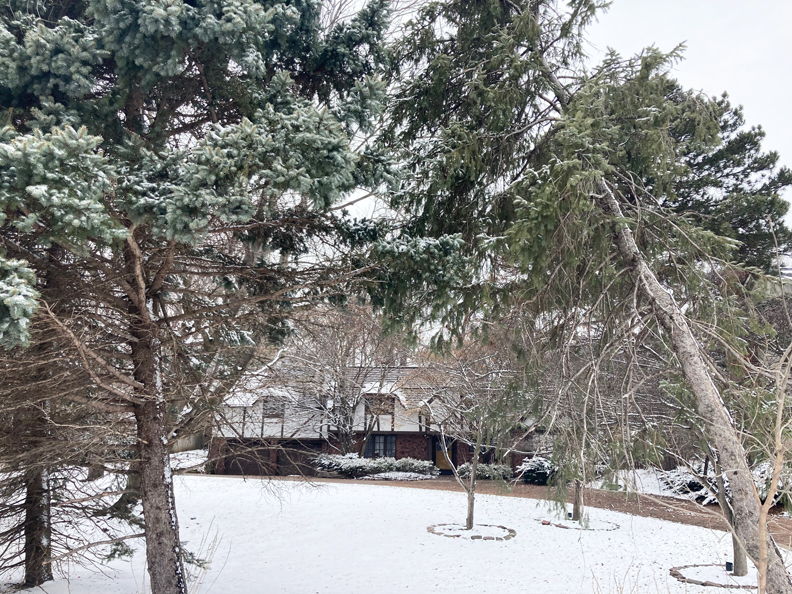
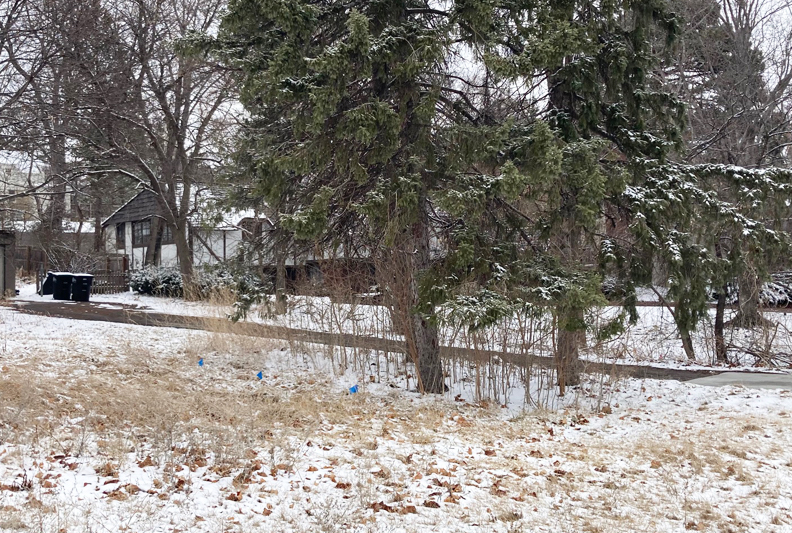
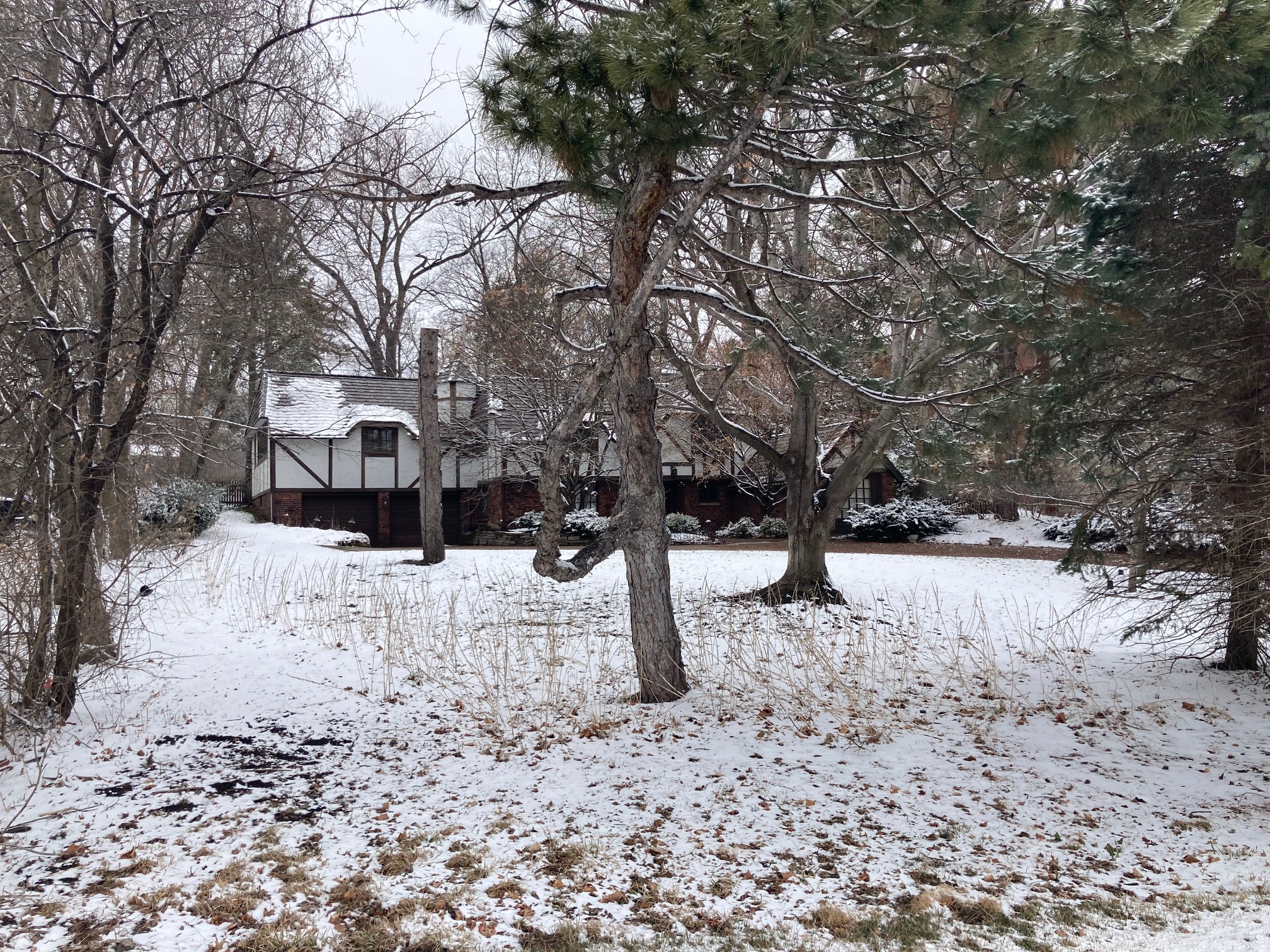
There was a surprising snow on that morning’s surveillance session and Erik Satie’s Gymnopedies played for the drive over made it all the more dramatic. 1402 South 78th Street was of the Hidden-In-Plain-Sight Species—the kind we love. Although 78th Street is one of my favorite pass-through streets, I surprisingly had not seen this character. I found her set back from view, recessed deep into the animated trees. I will confide, the approach and the way the home was built into the environment was all very Hennig.
My synopsis of first shadowing of 1402 South 78th Street scratched into my journal:
unexpected, graceful set back
sigh…no crushed rock way
a lovely approach—curved, brick drive—paved of antique(?) Purington Brick (a long time American company reigning from East Galesburg, Illinois). historic pavers wind up to the flat patio-like concrete drive around the garages
-nearly hidden by trees and shrubs
Early Suburban Omaha. Middle, Upper-Middle Class. Toned down Medievalism? Tudor
–first story patterned brick or stone. Clinker brick? No real storybook entry. Informal, decorative, second story half-timbering with stucco (?) No elaborate front-facing chimney but chimneys could be seen from other angles.
–charming series of front facing gables, country casements and cunning, gnome-like, eyebrow overhangs.
–a small, quirky tower added for architectural adornment later?
—strong design continuity on north portion of building, lesser vision on south (addition?)

Tudor Arms Apartments, 131 South 39th Street.
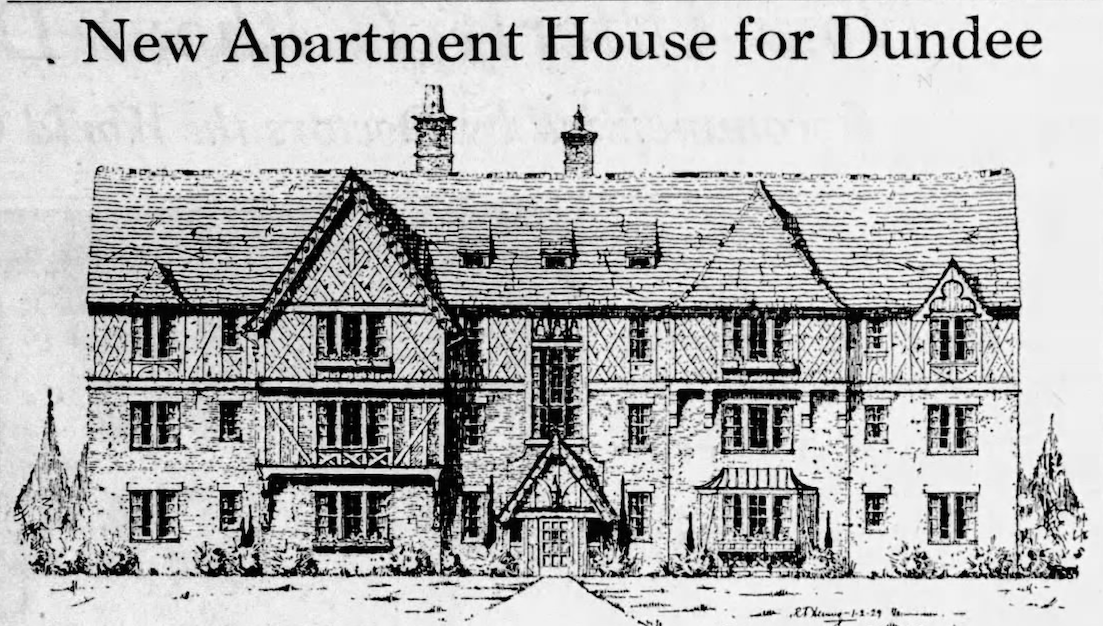
Buckingham Manor, 4817 Chicago Street.
Swept up in his 1920s vision of a Medieval dreamworld, as detected in his Midtown apartment buildings and swirling eclectic mix of period homes, I was never quite sure what I was observing with Hennig’s earlier output. (He would later focus on modernist design incorporating contemporary innovation that will be outlined forthcoming.) In my estimation Hennig’s 1920s and early 1930s buildings seemed to explore Disneyland’s mastery of Forced Perspective. Both building scale and his buildings’ elements were deceiving in the most pleasing of ways possibly because there was no comparison to other structures within close proximity. I harbor a belief that the absence of relative, neighboring buildings is how this was achieved–that, and Hennig’s fantastical ability to push his homes back and into the natural and manmade surround, isolated, truly creating his own distinct environment–designed to influence the viewer’s perception of scale. That is the Disneyland mystique. I will illustrate this point later with historic photos of his trio of French homes as well as a bizarre, current photograph of our 1402 South 78th and its neighbor. The more I familiarized myself with the three French Hennig cottages from that past investigation, the more I enjoyed the scale of the structures, the playfulness of his designs and his obvious emphasis on tactile, historic materials salvaged from England and France. I remembered some of the doorways of the 105th Avenue fairytale cottage were “short” with low ceilings in parts, earning it the name “The Hobbit House.” What sweeps me off my feet about the early Hennigs are the fanciful, intricate, European fantasy of each vision.
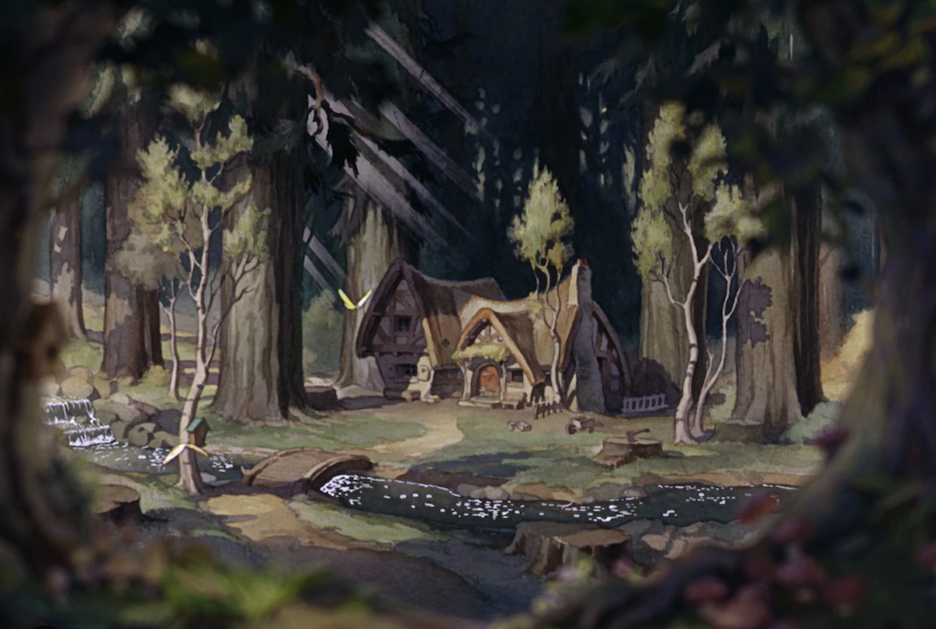
The Cottage of the Seven Dwarfs.
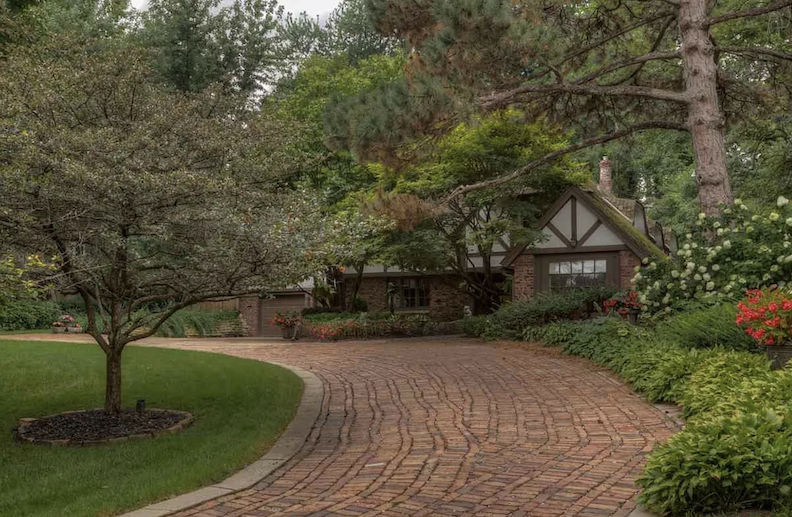
I had to admit, 1402 South 78th Street’s studied positioning on the property as well as its scale, unpretentious messaging, asymmetrical face, and French-English eclectic architectural hints were all in the nature of Reinhholdt Hennig.
It wasn’t lost on me that 1402 South 78th Street would soon be put up for sale. On that morning, all I wanted to do was walk inside, shut the door and inhale the scent of a quintessential library, worn, leather bound journals and hand-polished wood. Then I would pull the heavy, imaginary, moss-colored, velvet curtains closed, build a fire, lie on the floor and drink cup after cup of coffee while staring at the low-beamed ceiling…to experience the house memories of things I’d never known.
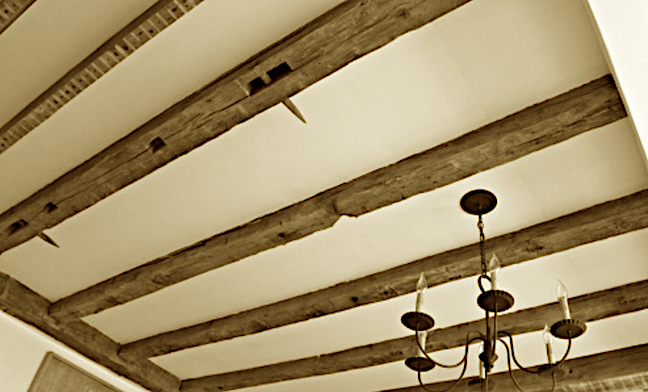
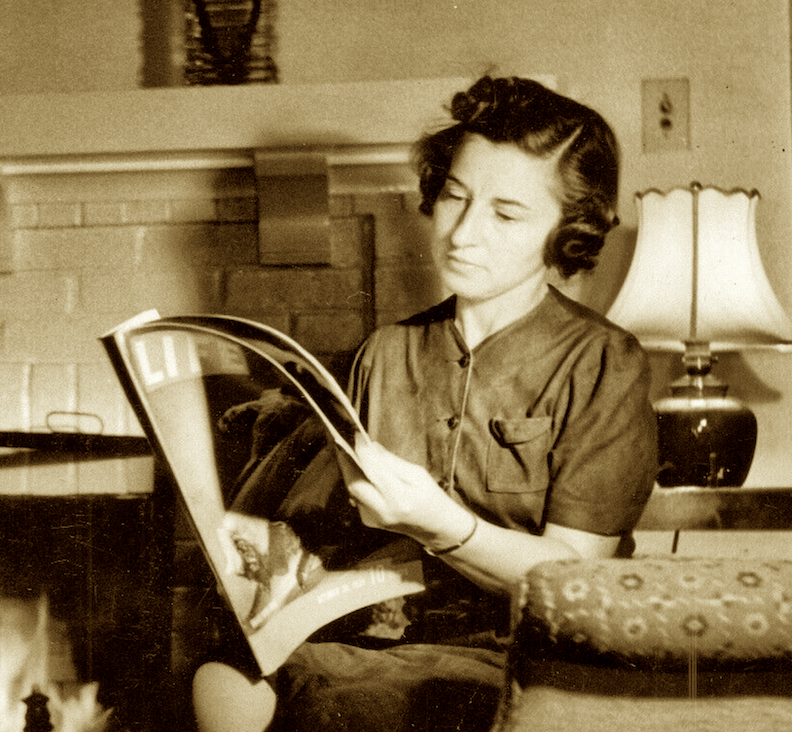
I would write Mr. Homeowner back and say that 1402 South 78th’s original portions certainly appeared architect-designed. The house did seemingly imbue the key elements that Hennig was employing at the time, but it could’ve been anyone, really. I mean, we P.I.s don’t want to give false hopes, right? We shared a back and forth with exchange of clues.
Based on the written up narrative the Homeowners had received when they bought the 1402 South 78th Street house, my probe became, was 1402 South 78th Street an authentic, yet uncelebrated, fourth, Normandy cottage of R. F. Hennig? In today’s investigation, we will aim, as a group, to formally honor the obscure and get to the bottom of this mystery. I am asking for your help, as you review my clues. You will want to take notes, as we will get knotty. Is 1402 South 78th Street a Hennig house? A true whodunnit mystery.
The house is officially on the market. Here is the link. https://www.redfin.com/NE/Omaha/1402-S-78th-St-68124/home/64045904
Attorney/broker Kirk Meisinger and his Meisinger Group have listed the home. Please contact him for your showing: (402-201-8311). I was not paid to conduct this investigation.

Gene wants you to know this will be one of our dense, long-form investigations. Get a drink, make a snack, grab a notepad and an ink pen.
Part One
Lay of the Land
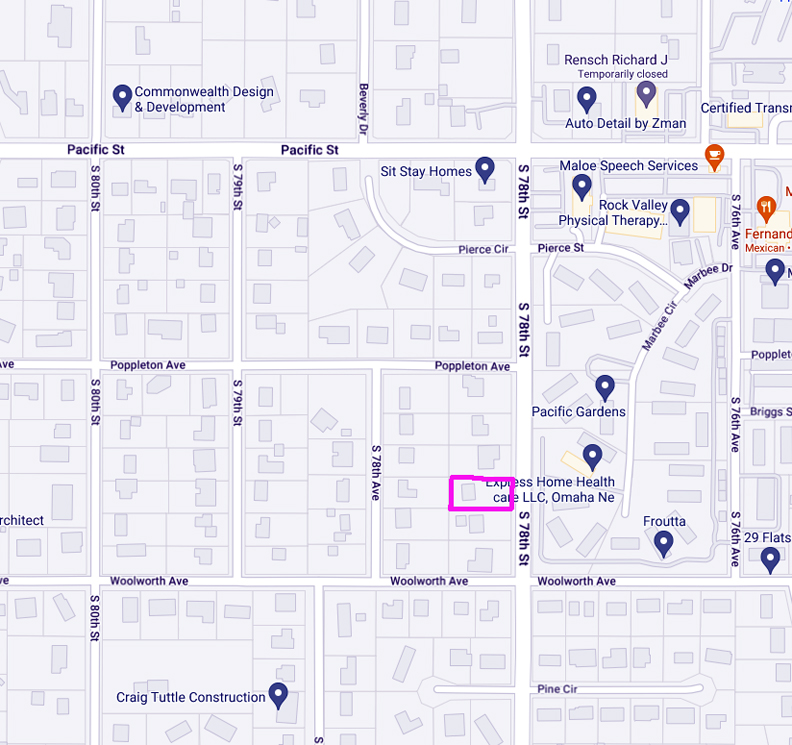
Google Map image. The top of the map is north. 1402 South 78th Street is outlined in hot pink. This property faces east with a lovely drive off of 78th Street. The structure sits to the rear of the lot, as seen by the building footprint and that of neighboring houses. The 1402 property lines are almost midway between Poppleton Avenue to the north and Woolworth Avenue to the south. I point this out because of an important clue, forthcoming.
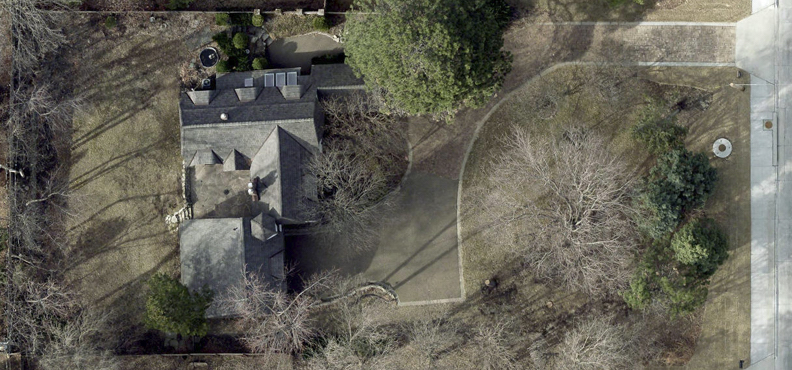
DOGIS aerial image of 1402 South 78th Street. Top of photo is north. South 78th Street is on the righthand (east) side of image. The large brick drive is observed. The west side of the property rises up to higher plateau and the rear elevation of the home was originally built into this hillside. Can you spot the addition/s from this view?
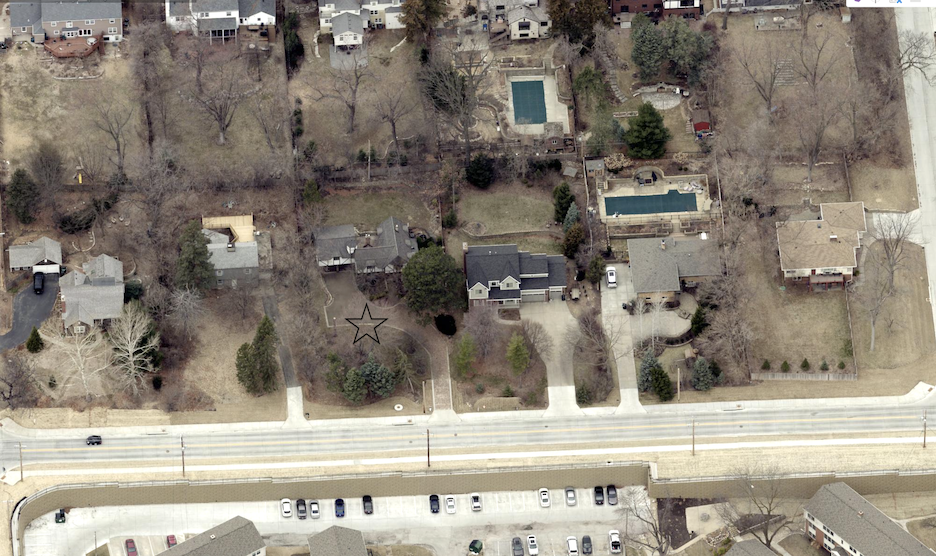
DOGIS aerial. Camera faces west. I added a black star to the 1402 South 78th Street property. This lends a nice perspective to the whole area. 78th Street runs (north-south) parallel to the bottom of the image. The Pacific Garden Apartments and their adjacent parking lot are seen on the opposing side of 78th. I’ve got a great investigation on the large home with the swimming pool (1323 South 78th Avenue) diagonally behind 1402 coming up.
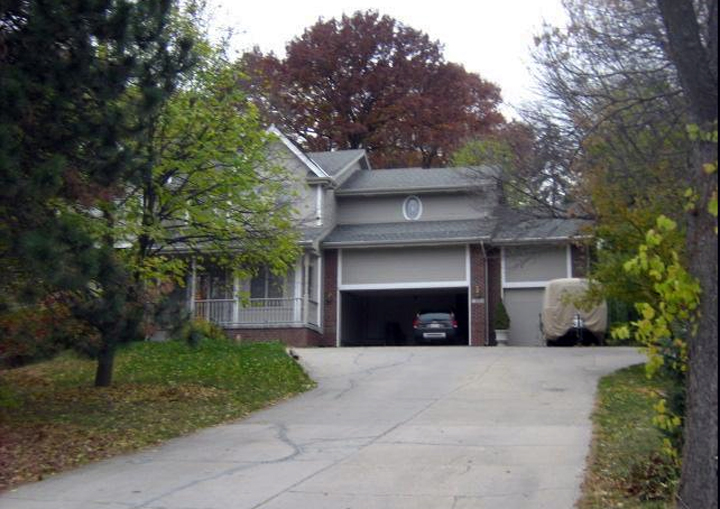
1320 South 78th Street is the home directly to the north of our obsession property. It is quite large and was built in 1993. This lot, due to its building’s young age, was one that I suspicioned as being a part of the original 1402 South 78th Street parcel.
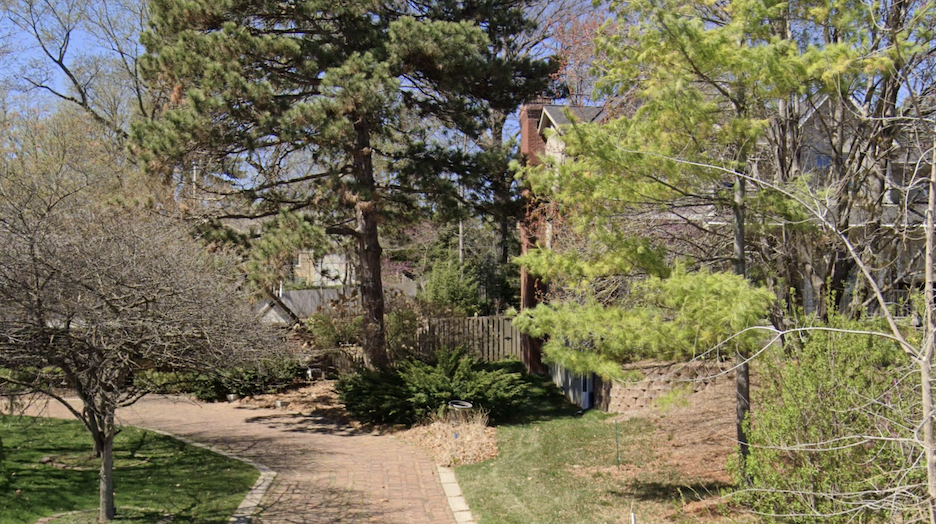
Here is the disconcerting photo of the two neighboring houses side by side (1402 on the left and 1320 on the right) that I had mentioned earlier when describing Hennig’s Disneyland like use of Forced Perspective. Although cloaked by trees and foliage, I hope you can make out the contemporary mass of 1320 South 78th as compared to 1402; not only are 1320’s proportions larger and more pronounced, in keeping with 1990’s home building trends, it is built toward the front of its lot. This emphasizes the Hobbit like appearance of 1402 South 78th Street, truly built into the back hill. It is an interesting architectural juxtaposition, while each house makes sense when viewed in isolation.
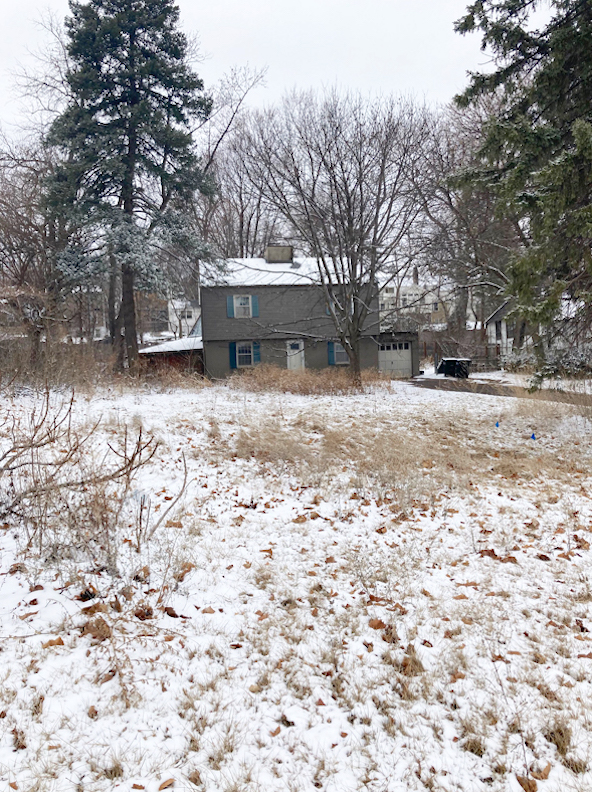
1406 South 78th Street, directly to the south, is an intriguing house that is supposed to pre-date our obsession. Like 1402 South 78th to the north, 1406 is set far back from the road. Purportedly built in 1936, this residence has been called a “Colonial” and a charming “Cape Cod” as well as being rumored to be “architect-designed.” The confusing thing about this cool property is that I didn’t see it in aerial images of the city until the 1940s. I would live here in a heartbeat.
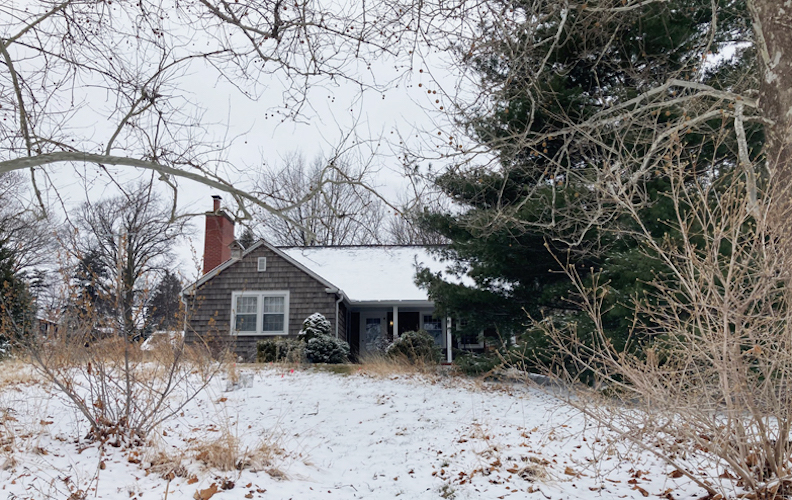
1414 South 78th is a shingle cape cod, on record with the city as having been constructed in 1941. As you might remember I am crazy for a good shake shingle and this one is pure. PURE perfection. In May of 1937 Daniel Cary (local developer) and wife sold this lot to Mr. Charles T. Clement. Did this house really not get built until 1941? I find this northwest corner of 78th and Woolworth divine and it is long my house crush on the block.
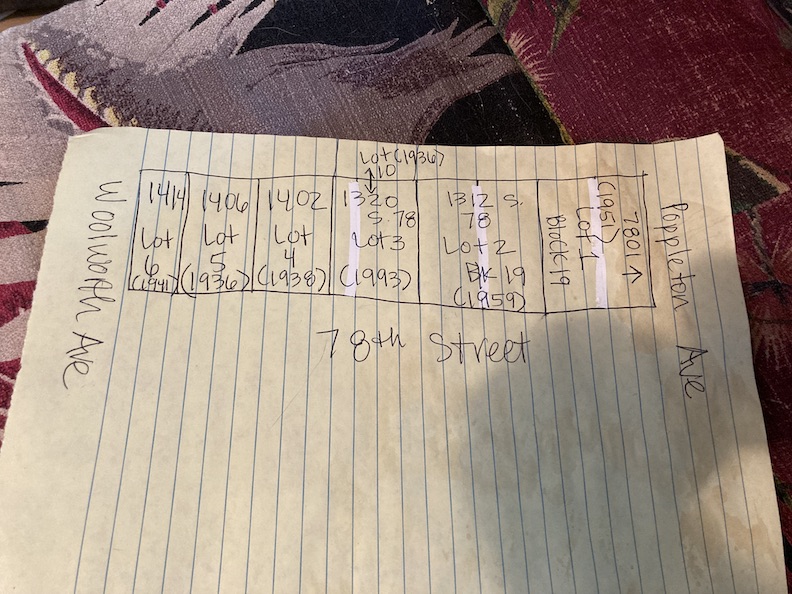
I always create a working parcel map so I don’t lose my mind as I work. Don’t mind the coffee stains.
A Solid Lead
1402 South 78th Street was built in 1938 according to the Assessor. Loveland Addition, Lot 4, Block 10.
I reached out to Scott Barnes of the Douglas County Assessor/Register of Deeds Office and unfortunately he didn’t have any additional data on record. I also contacted Shelley McCafferty, City Planner Historic Preservation Administrator and she did not have any historic photos of 1402 South 78th Street to contribute. Thanks to both of these My Omaha Obsession professional contacts for attempting to help this investigation.
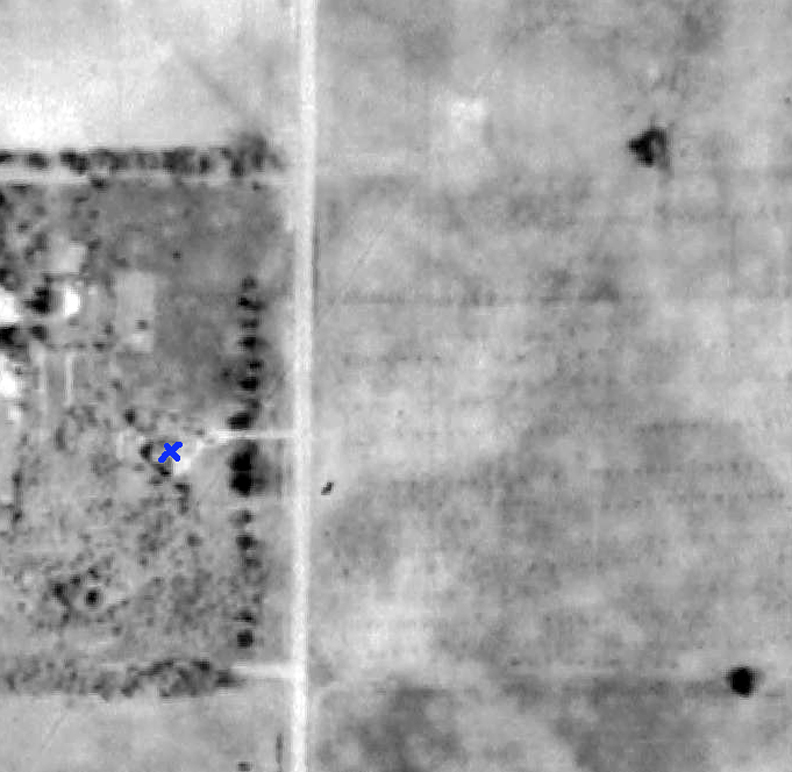
This 1938 aerial of the 1402 South 78th Street property (I put a blue X on the roof) showed that it was one of the only houses around this neck of the woods. The other viewed structures are to the west on 78th Avenue. 78th Street runs north-south through (about) the middle of the image. Poppleton Avenue to the north and Woolworth Avenue to the south of 1402 are the only roads and they both cut to the west. I originally thought Woolworth was perhaps a driveway. There are large trees planted parallel to 78th. Shrubs are dotted here and there. East of 78th is farmland and what a view it must have been.
Early on I would discover a very hazy World-Herald description printed in July of 1937 that was somewhat promising. The vague dispatch, in conjunction with the Register of Deeds’ 1938 build date seemed to create a congruent timeline. The article stated a home was being erected on the southwest corner of 78th and Poppleton, which was not exactly correct—however, dependent on how many other houses were in the area in the late 1930s, 1402 South 78th very well might have been nearest to that corner. The above aerial would seem prove it was the only one on the block at the time of the newspaper article. Also I had begun to learn that in its early years, the 1402 South 78th Street address had more land in its parcel, which I thought might have extended it northward. At this point I was of the belief that the Hennig connection was looking very good but I needed more proof.
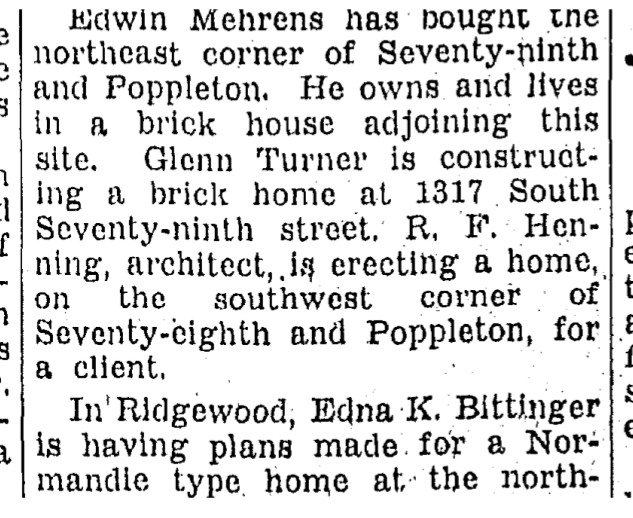
OWH archive July 1937. “R. F. Henning, architect, is erecting a home, on the southwest corner of Seventy-eight and Poppleton, for a client.” Although his name was spelled wrong, it seemed that this article was most likely proclaiming that our man Hennig built 1402 South 78th or something nearby.
Homeowner Hints
Armed with this solitary pointer and the hints at the sale of the land, I asked more specifically of Mr. 1402 Homeowner, what information they had, such as original photographs, documents, blueprints, or title abstract that led them to believe Architect Hennig had designed their home. (Don’t we old homeowners all have a kitchen drawer filled with a commingling of bizarre items such as archival documents, to-go menus of closed restaurants and old rubber band balls?) Hennig was known to draw up incredible sketches of his buildings and his blueprints/floor plans are usually very artistic with art deco font. Although the 1402 South 78th Street house was not as elaborate and weaved in more of the English Tudor style, I thought maybe Hennig had toned these elements down by the late 1930s. I shared I had found proof of Reinholdt F. Hennig (not Henning) building a house near theirs and that I had found the original sale of the land and who the original owner was, but still nothing solidly linked to Hennig.
Mr. 1402 Homeowner stated that upon purchase, there was no original documents with the home, which I found sad and strange but not inconceivable. Things do get lost or thrown away even in the best of historic homes. They did have some blueprints but I noted they did not look like Reinholdt Hennig’s fanciful work or tidy Art Deco penmanship at all.
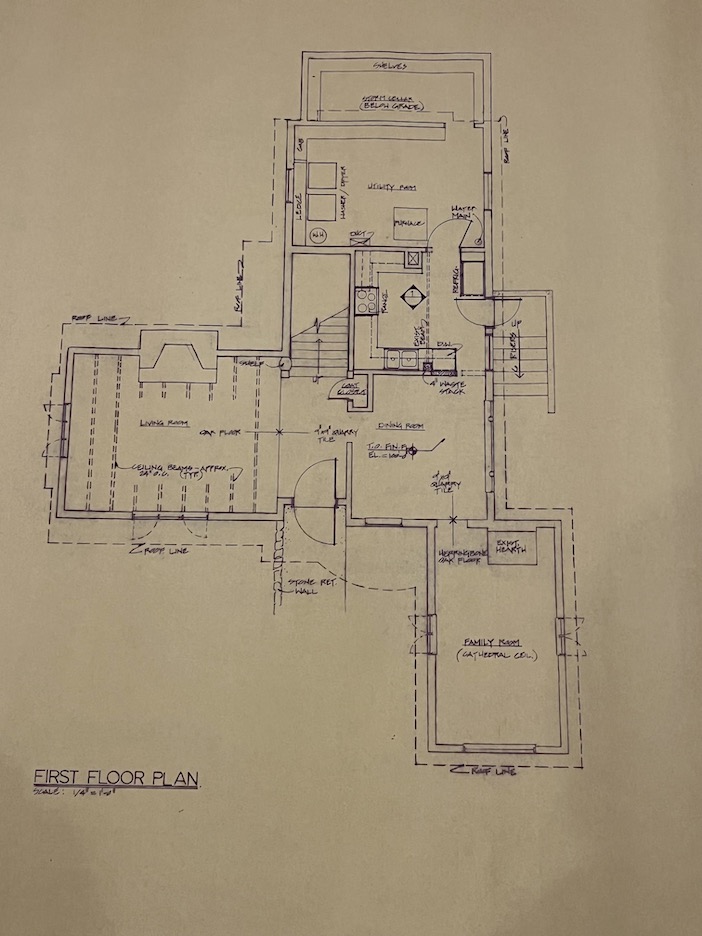
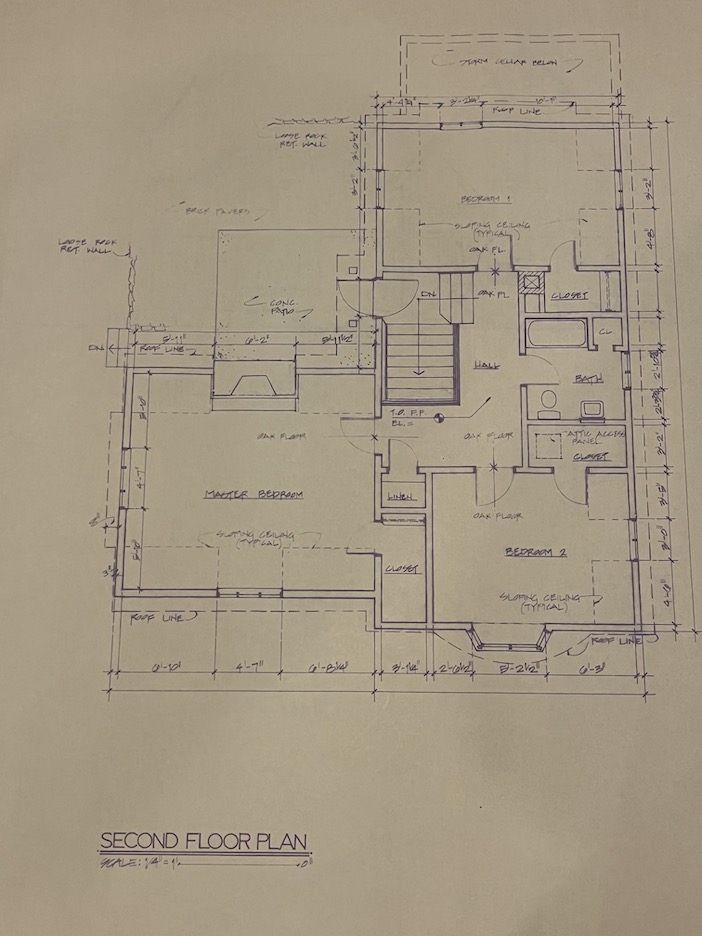
As it turned out, a past owner, Mr. M, had an architect develop plans for an addition to the home dated 1986; these plans included “drawings of what the house looked like prior to renovation” and were “labeled ‘original house.’” This is the first floor and second floor, purportedly drawn up by an architect named Offutt. Through my research it is possible that this addition is the work of Omaha born architect, John Longmaid Offutt. It appears Offutt worked in Omaha from the 1960s on; in the time period of the 1402 South 78thStreet addition, Architect John Offutt was working under the company name of John L. Designers from 1980 until his death in 1992.
Other clues from Mr. Homeowner: “The house has a small storm shelter basement below grade (actually extending from the main house below ground into the backyard) that appears to be original. You can see that on the 1st-floor of the original plan. It comes off the back of the house and is lower than the main floor. The original house has original wood-beamed ceilings in the living room and dining room. It was built into the hill so that there is a wide staircase and landing with an exit to the backyard (which is now a courtyard with the addition). All the walls are highly textured hand plaster. The main floor has wood and tile flooring. There is a wood floor in the living room, but I am guessing that it might be over an original hard surface. There is tile in other areas. Again, might be laid over an original hard surface. There is a fireplace in the living room and main bedroom. The fireplaces were converted to gas and there was an addition in the 1980s.”
I will include these 2017 exterior real estate photos that I gathered from CBS Home. I think these give a good idea of the home being built into the hill, as described by the homeowner. I did not take these gorgeous images and I would be happy to credit whomever snapped these, if you notify me.
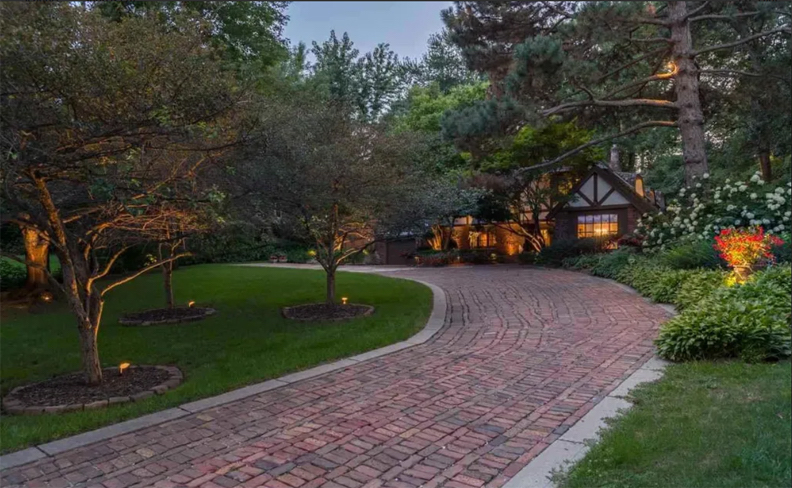
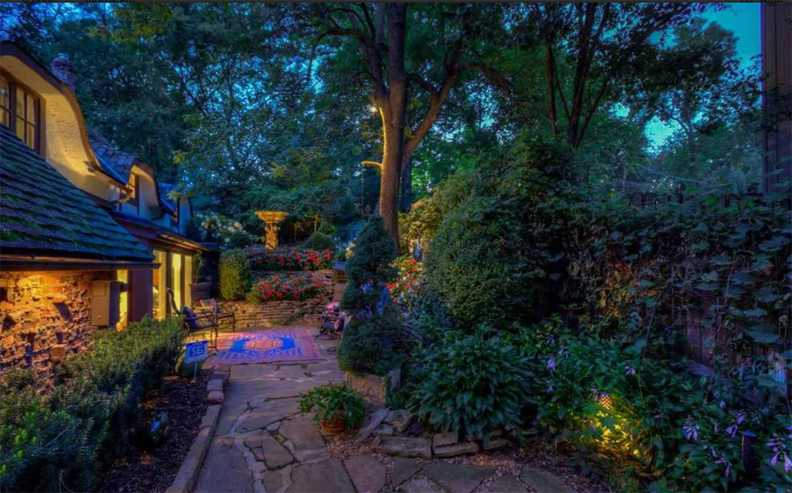
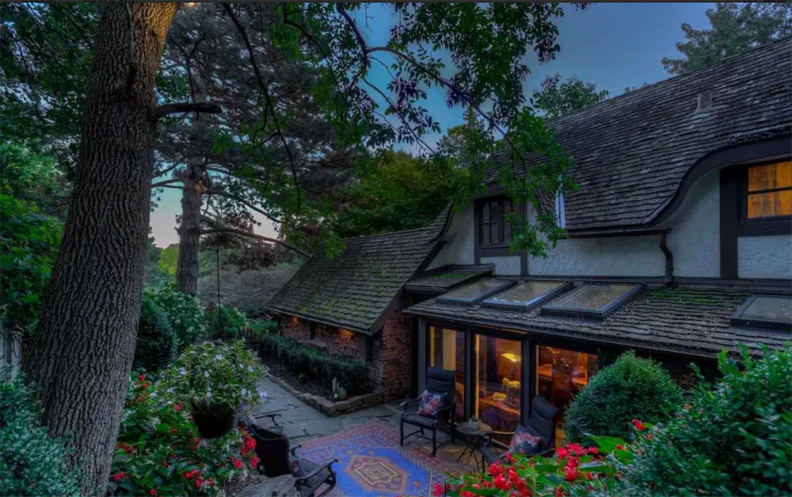

The addition to the south side of the home created the third wall of this charming courtyard. The fireplace is to-die for and appears to employ the weeping or sloppy mortar technique–in this case, the intentional choice of the architect. Popular between the 1930s and 1950s, this planned effect allowed mortar to “ooze” out of the masonry during construction. This looks, to my eyes, particularly attractive with a Tudor-Revival or any kind of European cottage style. It adds dimension, weight, quirk and a timeworn quality to building, especially when emulating old school, hand-laid craftsmanship.

The nubbly, varied texture and imperfect perfection of Clinker brick paired with stucco. Airs of Simple Old World. The eyebrow arched window roofing, Elizabethan diamond windows in the door and English-style lantern light as seen on the original segment of the home.
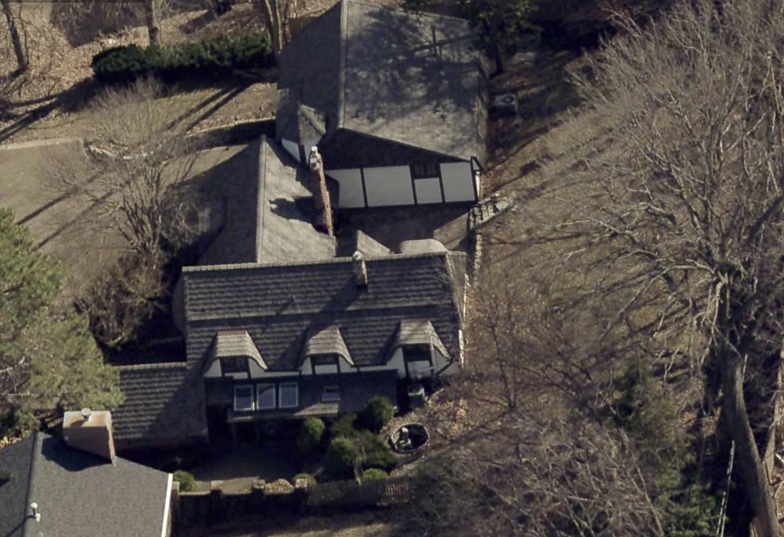
Camera faces south. Northern elevation is exposed. Lower left hand corner shows roof of 1320 South 78th Street. This aerial also does a nice job of illustrating the landscape with home nestled into the back hill.
Curiously the owners before Mr. and Mrs. 1402 Homeowner had included the following “Windfall” story as part of the marketing materials, which name-dropped “Henning,” no doubt meaning Hennig. Mr. 1402 Homeowner sent a mystery image of the handout from the realtor. This for me is where the real puzzlement of the property enters.
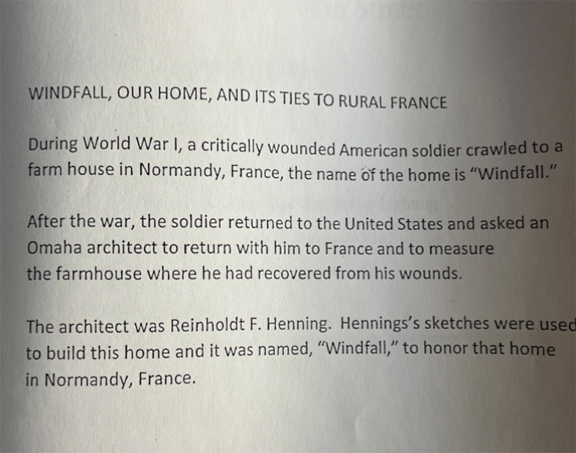
The “Windfall” story as written up by the previous realtor. Wouldn’t it have been called “Aubaine”?
The Question of Windfall
For those sleuths who have followed our Hennig obsession for a while, you may recognize this story, as did I, of the soldier crawling to a French farmhouse and then having an American architect design a likeness back in Omaha. I had shared this very adventure in my 2016 examination of a different Hennig property at 2417 S. 105th Avenue, the previously mentioned French Fairytale Cottage.
From that mission: “It was around this time that I got the Big Break in the case that I was dying for—news about the architect and some breathtaking history on the French country home. Truly an architectural detective’s dream. As the story goes, during World War I, a critically wounded American soldier crawled to a farmhouse in Normandy, France. The American soldier would eventually return to the US and asked an Omaha architect to return with him to France to measure the farmhouse where he had recovered from his wounds. This Omaha architect was none other than Reinholdt Frederick Hennig. Hennig’s wife, Ruth Madden Hennig, confirmed this intriguing story.”
The only thing missing was mention of the farmhouse being named Windfall. I asked Mr. 1402 Homeowner, if it was possible the previous owners or realtor had lifted this quote from my 2016 story and wove it into the 1402 South 78th Street home’s history for the sale in 2017? Or was there more information somewhere about Windfall?
I would backtrack into my old notes on The Curious Case of the French Fairytale Cottage investigation (the Rockbrook house at 105th Avenue) and had found the lore of the French farmhouse information was garnered originally from a 1988 OWH article entitled, Composer Newest Owner House Has Ties To Rural France. “In one version, that soldier later designed homes in Omaha based on the farmhouse. In another version, however, confirmed by the designer’s widow, the soldier returned to the United States and asked an Omaha architect to return with him to measure the farmhouse where he had recovered from his wounds. [ . . . ] In 1928, Hennig’s sketches were used to build the Rockbrook home and at least two others in Omaha. One is on J.E. George Boulevard, and the other is on South 67th Street near Elmwood Park. ‘Hennig designed 13 houses in Omaha,’ said John Webster, the owner of the Rockbrook home from 1971 to 1979. ‘Three of them were in this style.’ Today, the Rockbrook home, which has had 13 owners, remains most authentic to the original design. Others have been altered.”
What follows are the collection of Hennig’s enticing French Fairytale Cottages or the French Triplets, as I call them.

2417 South 105th Avenue as seen in 2016.

How she appeared in 1988, through the mist of a dream.
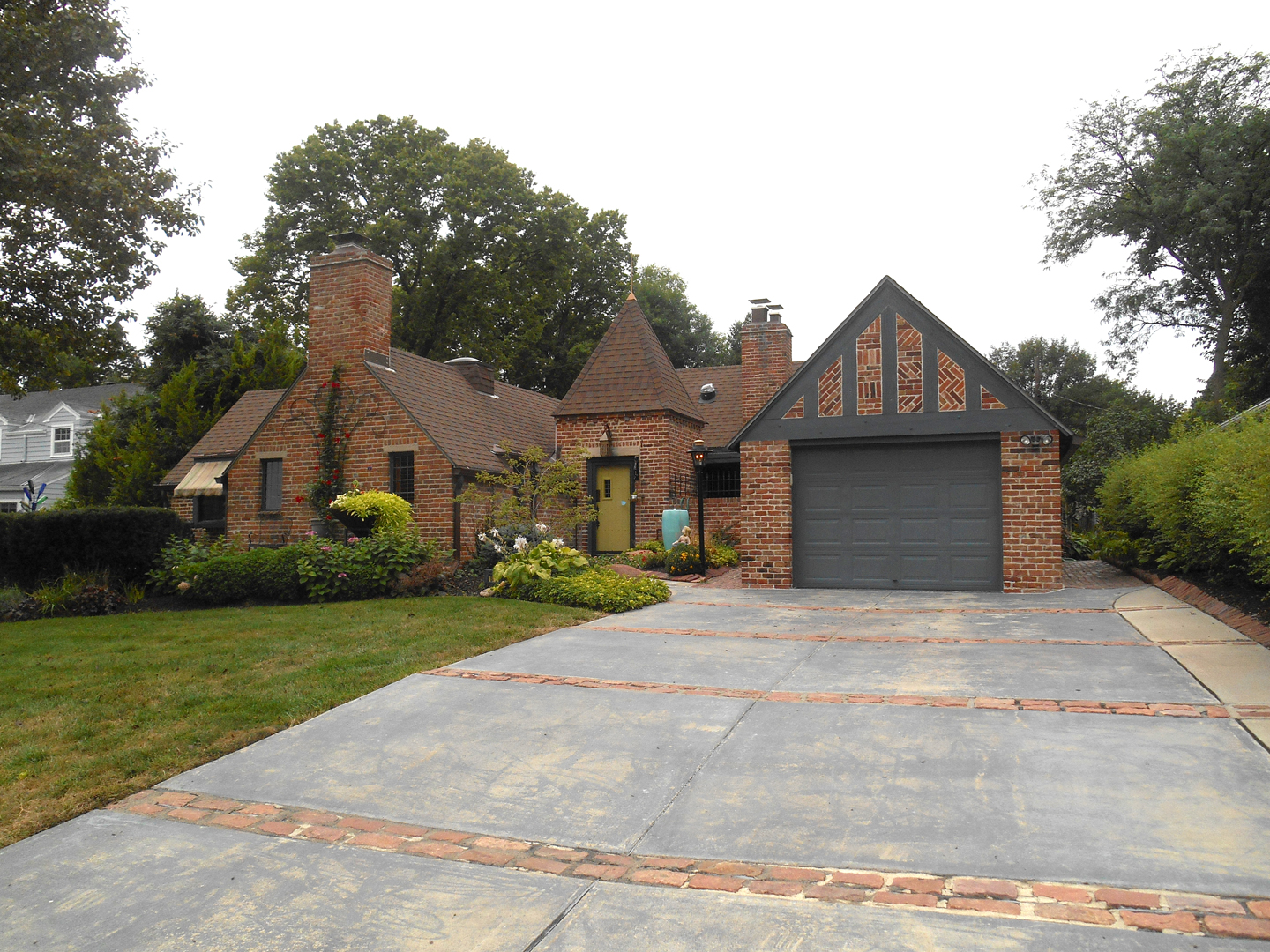
808 South 67th Street as seen in 2016.
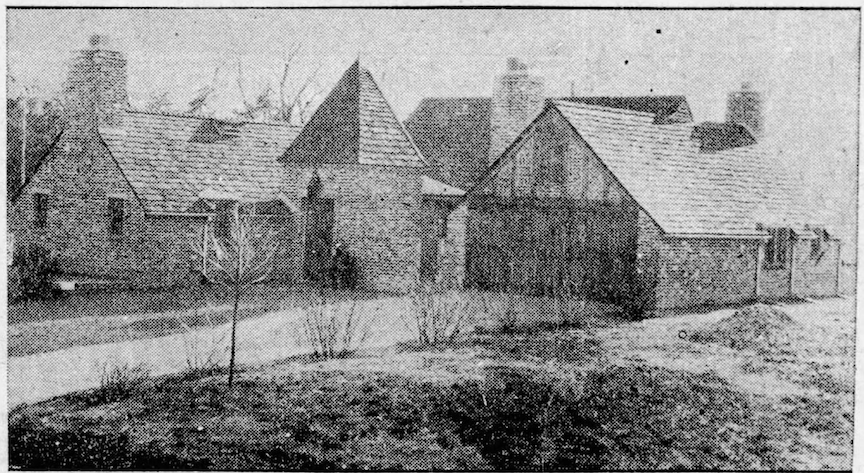
How darling 808 South 67th Street appeared in 1928. A gnome’s delight and Miss Cassette’s too!
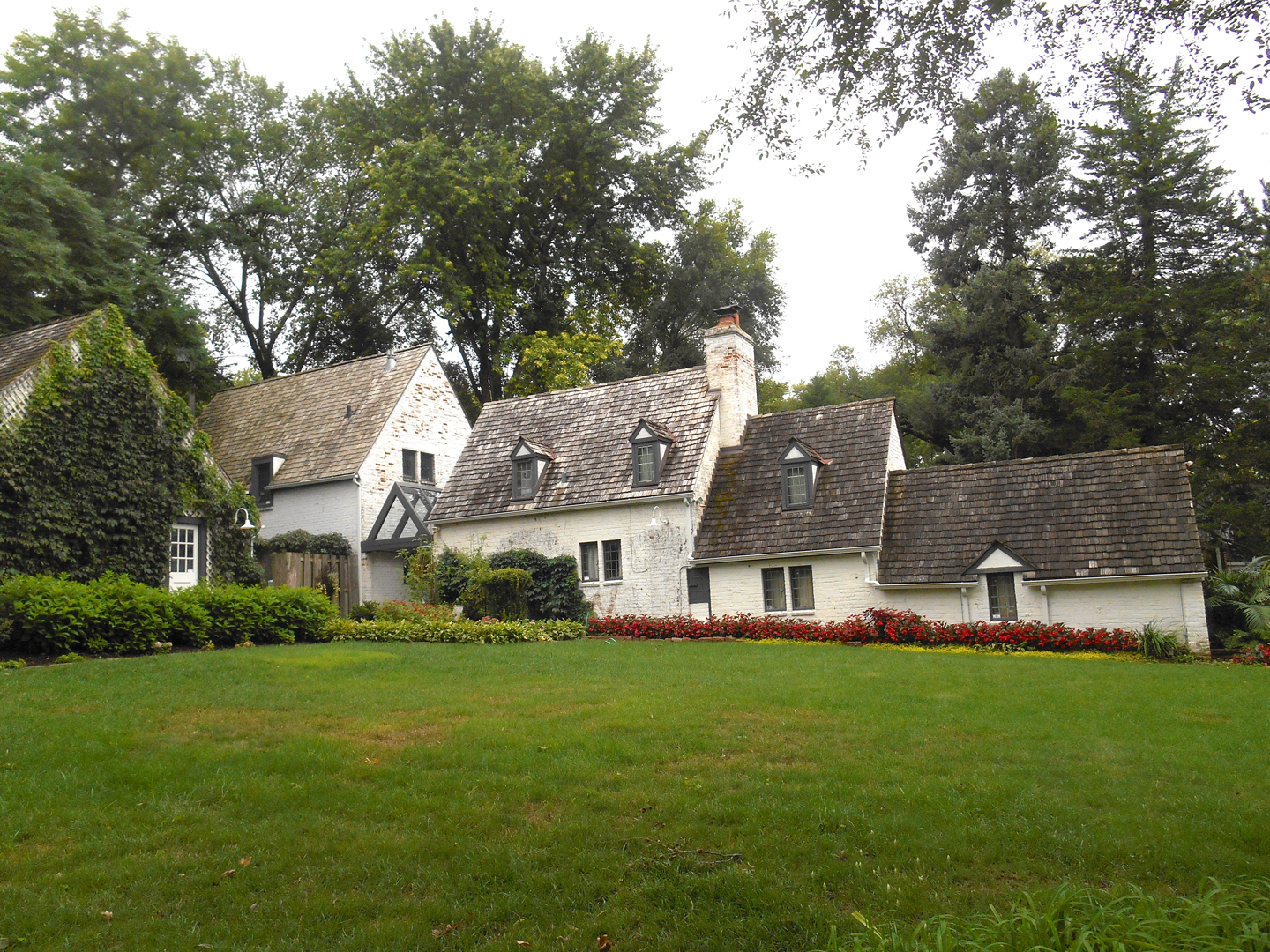
715 J. E. George Boulevard, with simpatico additions, as seen in 2016.
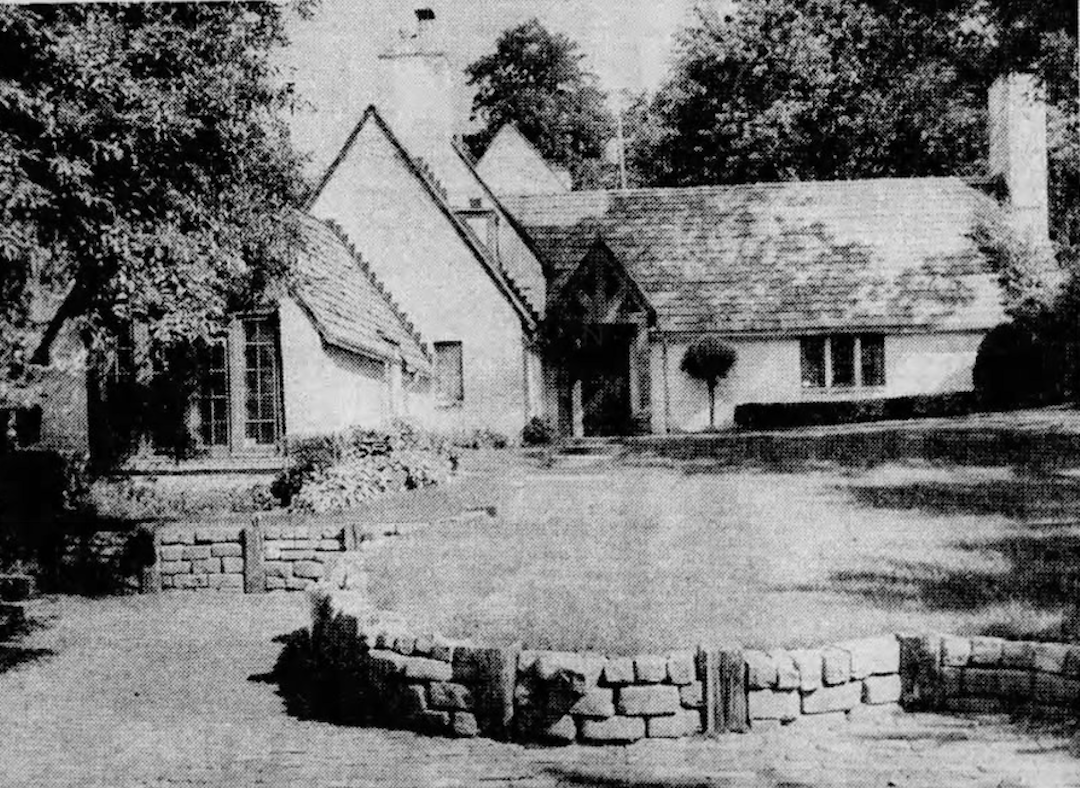
The Crème de la Crème that is 715 JE George Blvd in 1988.
The Hennig specifics laid out, at least in 1988 terms, were that there were three homes designed from the original French farmhouse specs with no mention of the name Windfall. We do know there were many other Hennig designed homes around town, which we will dig into in a bit. Was 1402 South 78thStreet a true Hennig home? It seemed probable. Was this 78th Street property the unknown quadruplet from the original French farmhouse sketches? I wanted it to be. Was someone puffing a romantic real estate connection that truly wasn’t there? It has been done before. It was hard to know for sure but it seemed an elaborate fabrication for such a small town as Omaha where stories and names could be checked. I knew there were people in town who held further hints.
For instance, not long after I took up this infuriating closed book, a review of my correspondence with readers and sleuths in the last seven years unearthed this clue from Omahan John Tanner back in 2016 when I wrote the original French Fairytale article. Mr. Tanner wrote: “There is a home about 1300 South 78th Street which I believe may be part of that same Architect’s work. This home has been remodeled and it included a small stable next door to the north which was smaller than any home in the area. A friend of mine, artist David Coyle, rented it in the late 60s early 70s and then somebody purchased it and added onto it. It’s completely changed.” Tanner’s fascinating missive hints at just the mystery we were wanting to solve. Not only had I not read this email back then, I immediately wrote to Mr. Tanner to compare note. Alas I have yet to hear back from him. Although his address on 78th Street was a bit off, I wanted to know more of his memory about the property and what he knew of the possible Hennig connection.
Loveland Discoveries
In 1922 Schuler & Cary real estate developers platted the Loveland addition. I have written often of this super duo.

This is a portion of a great plat map, presumably drawn up in 1922. To gather ourselves, let me draw your attention to Block 19, Lot 4 (site of 1402 South 78th Street); attend to 78th Street, Poppleton and Woolworth Avenues. Also of importance to this investigation are lots 3 and 10.
My big question right away was, if this whole subdivision was platted and marketed back in 1922, why was 1402 South 78th Street not built until 1938? From the looks of the 1938 aerial that I shared earlier, there were no other houses on the block either. At one point I told myself new homeowners would want to build on higher ground, within the privacy of the subdivision, not on a busy thoroughfare such as 78th Street. It was potentially commonplace for buyers to swoop up the most coveted, private lots, on higher elevation first.
In 1930 the most exciting thing going on in these parts was Caesar’s Country Club at 1402 South 75th Street. (Sometimes spelled Cesar’s; sometimes said to be at 1403 South 74th Street.) I have written of it elsewhere, but this was a popular place to carouse outside of the city limits. (Did you see it when it was for sale a few years ago?) I could find no Sanborn maps to verify this part of town, let alone Omaha City Directories. This truly was considered out in the country.
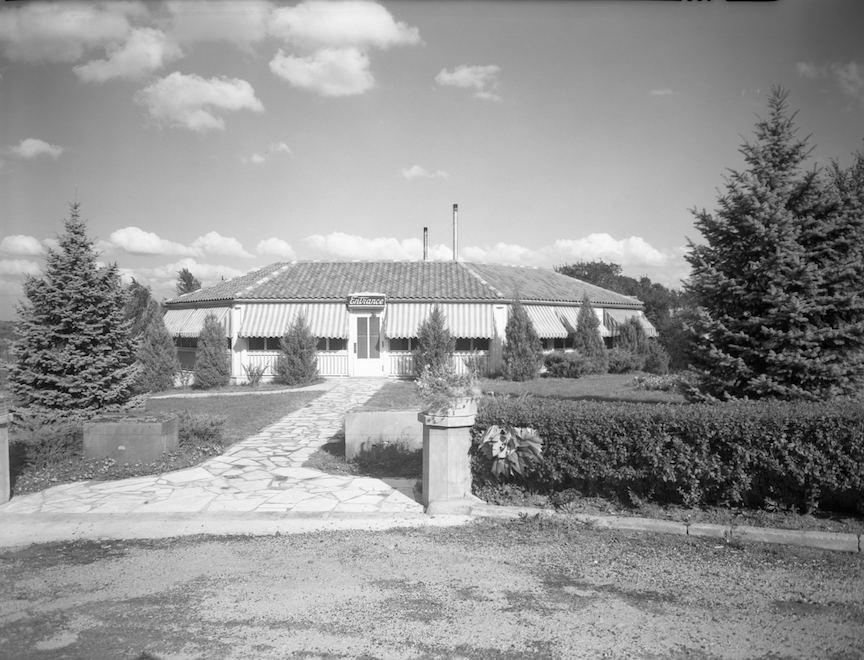
Cesar’s Country Club as visible with the main sidewalk leading up to the entrance at 74th and Pacific, 1403 S. 74th Street. Creator: Bostwick, Louis (1868-1943) and Frohardt, Homer (1885-1972). Publisher: The Durham Museum. Date: September of 1941.
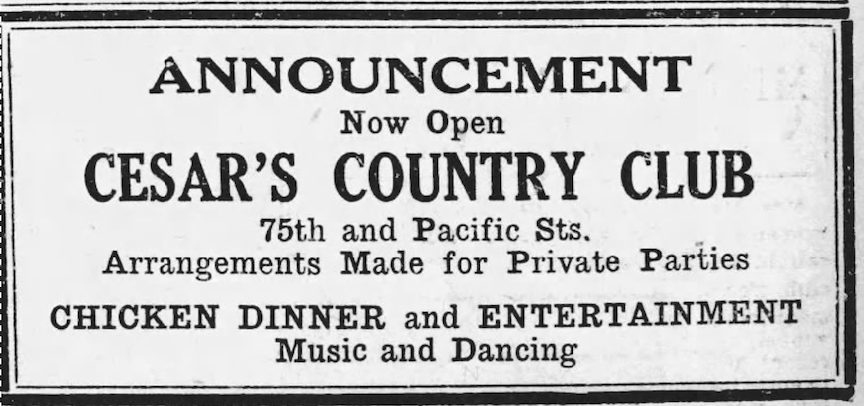
OWH. August of 1925. Cesar’s Country Club opens.
I had already come across the name of Mr. Raymond Leydecker as the initial owner of 1402 South 78th but somehow was needled by the fact that he didn’t build the home until 1938. I consulted with professional sleuth, Martha Grenzeback, Genealogy and Local History Librarian for Omaha Public Library, asking if she could dig back further. She confirmed: “There was no city directory published in 1930. In 1931 and 1932, the only addresses on S. 78th were S. 78th Avenue. 1310 and 1330 South 78th Avenue were owned and lived in by Thomas F. Parker and William T. Shoup, respectively. The Daily Record used to have a column called ‘Removals’ where they noted everyone who had moved from one address to another. On Aug. 13, 1932, it records the move of Raymond Leydecker from 5006 Western Ave to 1402 S. 78th.”
This was very exciting and I was able to track down the clue Detective Martha had written me about.
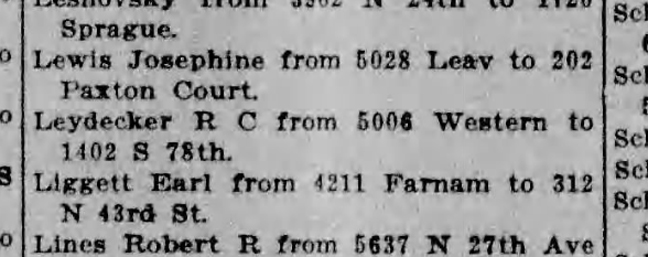
Daily Record. August 13, 1932. The Daily Record turned out to be rich with hints! Thanks, Martha.
The Early Property
If 1402 South 78th Street purportedly wasn’t built until 1938, was the date off or were the Leydeckers living in an earlier incarnation of a property? Omahan John Tanner hinted at another building on the 1402 lot, a “small stable next door to the north” supposedly “smaller than any home in the area” that his friend rented in the 1960s. I would find indication of this smaller house potentially predating our 1402 obsession again and again. Likewise Mr. 1402 Homeowner stated that in their investigation into their house, “We found old for-sale ads in the Omaha paper that said there was a guest house and an acre lot.” For those who like things kept tidy, all of these clues were suggesting that 1402 once included both Lot 4 and Lot 3 to the north.
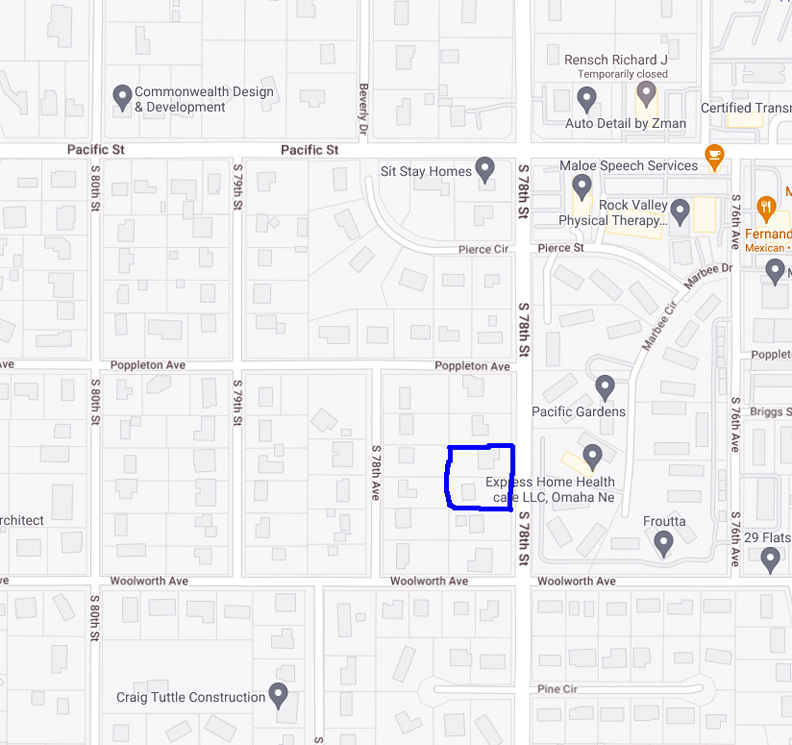
Lots 3 and 4 in Loveland outlined in navy blue. Image borrowed from Google Maps, 2023.
Here is where I went tracking.
Daily Record from November 7, 1931. William W. Hoagland took Christine E. Underwood to District Court for “forcl mech’s lien” on Lot Four. I made out this announcement was short for foreclosure mechanic’s lien. I had never come across this phrasing so I consulted with my construction buddy, Jimmy Kaufman. A Mechanic’s Lien Foreclosure can be enforced by a builder through a foreclosure lawsuit if the property owner fails to produce a payment. The “mechanics lien foreclosures are the last resort to getting what is owed.” This lien is effective for two years.
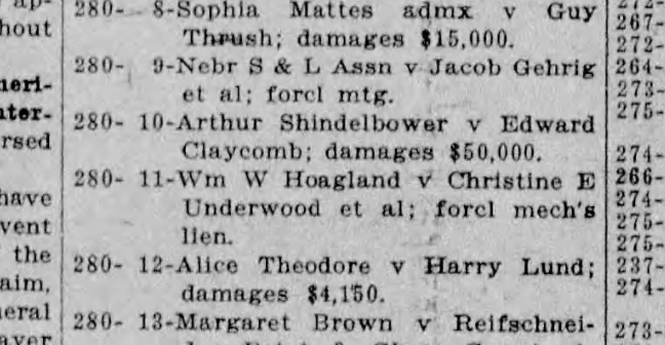
William Wyman Hoagland was a local lumberman. I mentioned him in the story The Secret of the House that Moved in my book and other investigations since then. W. W. was manager of his father’s empire, George A. Hoagland, Wholesale and Retail Lumber. George T. Hoagland and his son, George Appleton Hoagland were Omaha Famous for having founded the first lumber business in town. What this 1931 notification told me is that Hoagland Lumber was suing to get what was owed either for lumber or that they were engaged in building a house for Christine Underwood and family. I found that by the time William W. Hoagland had entered the lumber business of his father, Hoagland Lumber also operated an investment business and was in the business of builder. Interestingly in the middle of the suit, Helen H. Elliott stepped in and was granted “administrator of the Hoagland estate” in 1931. Helen Edith Hoagland Elliott, William’s daughter, became president of Hoagland Lumber after her father had committed suicide. William was 61 years of age at the time of his death.
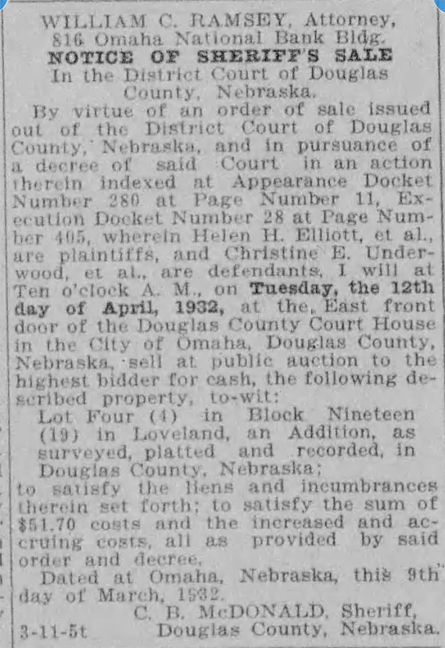
Daily Record March 12, 1932. Helen H. Elliott plaintiff and Christine E. Underwood defendant, went to court on April 12, 1932. Lot Four in Block Nineteen in Loveland went up for public auction to the highest bidder “to satisfy the liens and incumbrances therein set forth; to satisfy the sum of $51.70 costs(…)” So it was a sheriff sale on the deed. Was there a house or framing left incomplete on the lot?
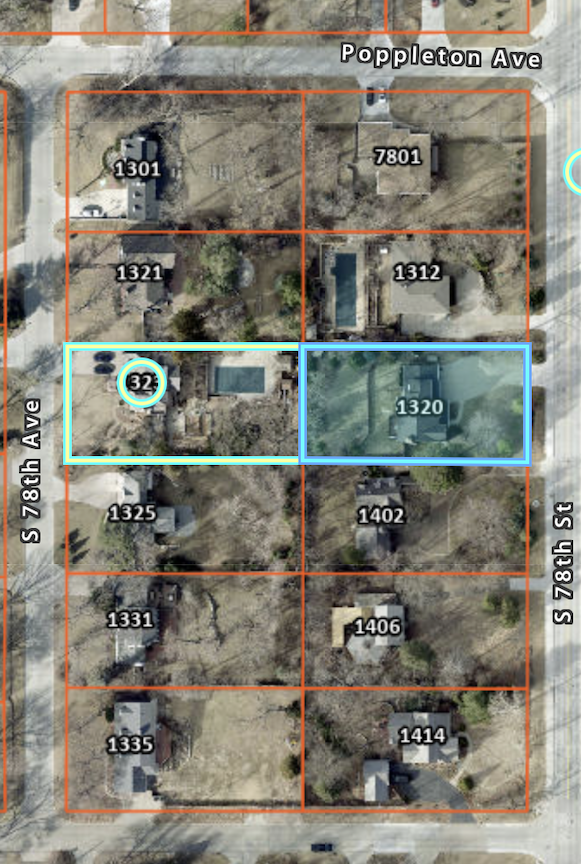
The Ringer family bought lots 3 and 10. Image borrowed from DOGIS.
Daily Record of January 1932 stated Daniel Cary and wife sold Lots 3 and 10, of block 19 of Loveland Addition to Nelle M. Ringer. Lot 3 is the property just north of our 1402 obsession; Lot 10 is directly behind Lot 3, at 1323 South 78th Avenue. (I have an investigation about Lot 10 coming up in the near future.) Dean Ringer was a University of Nebraska football player, where he attended law school. Later he became City Commissioner. Mr. Ringer was also Omaha postmaster through the 1920s and 30s. Nelle Ringer, his wife, died at the age of 92, a retired piano teacher. I include this Ringer file, as it sheds light on changes to come. Clearly, as the case of Hoagland vs the Underwoods worked through the court system, it became apparent that Lot 3 was not included in the Lot 4 1402 South 78th parcel at that time at this earlier juncture.
I kept moving and sifting. But after months, I could not let go of the Underwood surname. I obsessed way past the point of my good nature–who were the Underwoods and why would they bilk the Hoaglands? Only now in the 11th hour, have I found the truth or something that seemingly explained all.
Francis and Christine Underwood moved to Omaha by way of New York. Mr. Underwood worked for the railroad as an instructor, perhaps influencing their move to Omaha. They had a little boy, Francis Ogden Underwood, upon arrival. The family lived at 1220 South 55th Street around the time of their Loveland addition purchase on 78th Street. All of these clues were retrieved from the U. S. Census of 1930, as well as the Omaha city directory of 1931. Upon third digging cycle, I discovered Francis Earl Underwood, the husband, died on Sept 19, 1931 according to the Nebraska index to death. Then I found the article. He is buried back east in Cortland County, New York, with his kin. This took a sudden, sad turn for me—to find why Christine perhaps could not pay off the Hoaglands and why she no longer followed through with her home on 78th Street. Her husband was only 26 years of age when he died. (The article reported he was 27.) For that matter, we do not know for a fact that the Underwood home was not completed. Did the Underwoods have 1402 South 78th Street built?
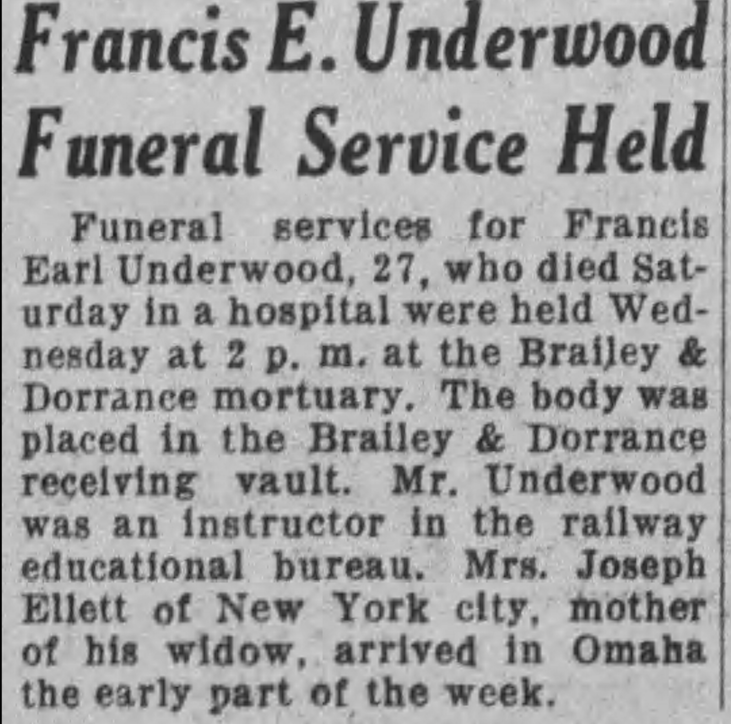
The Abridged Leydecker File
Raymond Charles Leydecker Sr. was born in Omaha in 1897. He married Laura C. Hill, a Nebraska native, when they were both 21. They had one child, son Raymond Charles Leydecker, Jr. At the time of the 1930 U. S. Census the Leydeckers resided at 4936 Chicago and had taken in Laura’s parents, William and Nina Hill. The Senior Leydecker worked in advertising, climbing the ladder as a salesman, then became manager and director at the Omaha Daily Tribune (1920s), Omaha Bee News (early 1930s) and the World-Herald (later 30s.) I would discover the Leydeckers residing in about four different addresses until the odd notification from August of 1932. These yearly moves suggested that the family were renters (not unlike Miss Cassette in her younger pursuit to live in every cool, historic apartment building in Omaha.) If we huddle and review our clues, the Leydecker family moved to the specific address of 1402 South 78th Street in August of 1932.
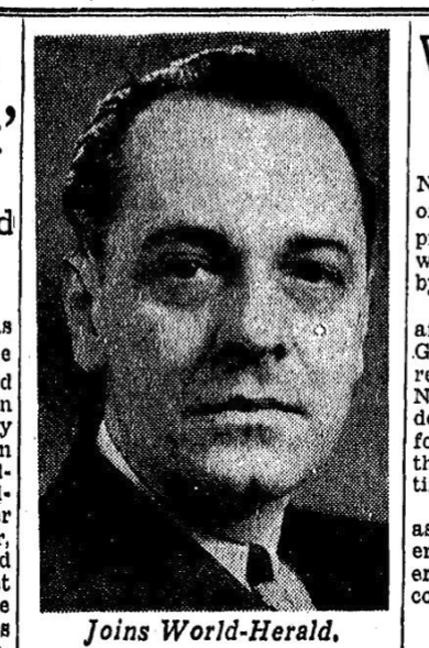
Ray Leydecker in 1937, upon his hiring at the Omaha World-Herald as their new ad man. It is possibly not for me to say, but you know how I get when I trailing someone. I think Ray Leydecker Sr. was an early noir dreamboat.
Further establishing themselves in Loveland, for her part, Mrs. Leydecker was, soon after arrival, elected president of the Loveland School Parent-Teacher Association in 1933. She remained very active in their years at 1402.
To put a finer point on the address and timeline, not long after the family moved in to the presumed already standing home, Mrs. Leydecker reported a lost/stolen diamond ring since August 5, 1932. “It was with another ring and two hundred dollars in a box in a closet, she said.”
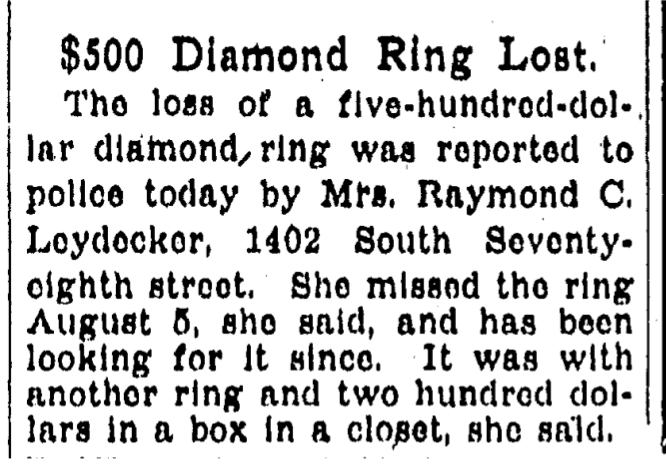
OWH. August 18, 1932.
If 1402 South 78th was Lot 4, the following vague hints suggest that the Leydeckers scooped up additional land from C. Mac Ennis and his wife.
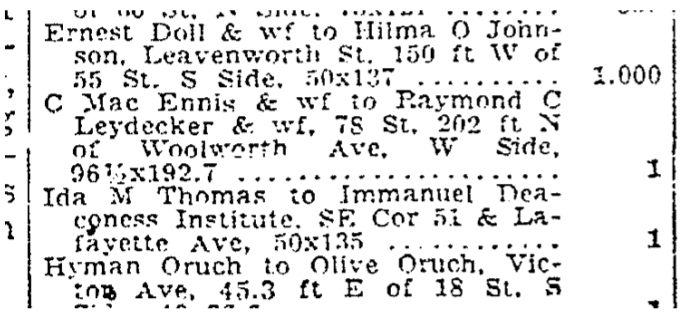
OWH archives. July 28, 1932: C. Mac Ennis and wife sold to Raymond C. Leydecker and wife. “202 ft N of Woolworth Ave, W side.” Was this adjunct to 1402 South 78th Street?

**Here’s where it got really interesting. The OWH archives of August of 1932 exposed that Raymond C. Leydecker and wife simultaneously sold to Charles M. Ennis and wife, the SW corner of 36th and March Street. Was this a swap— land for land?
The Charles Mac Ennis Theory
To deliciously complicate things, I found that Charles McLaughlin Ennis was also a designer-builder in the Omaha housing scene. C. “Mac” Ennis, as he was known, was an early contractor and purchaser in the Morton Meadows neighborhood. He “designed and built a bungalow of colonial influence.” I would dig back to 1926 and find he built the amazing 5307 Izard in Happy Hollow. This mesmerizing “brick laid in Flemish bond structure” garnered much attention as a “new French type home.” Mac and Eloise Ennis moved around quite a bit, it seemed, like the Hennigs. Both the Hennigs and Ennises appeared to complete a home, move into it for a while, until it sold.
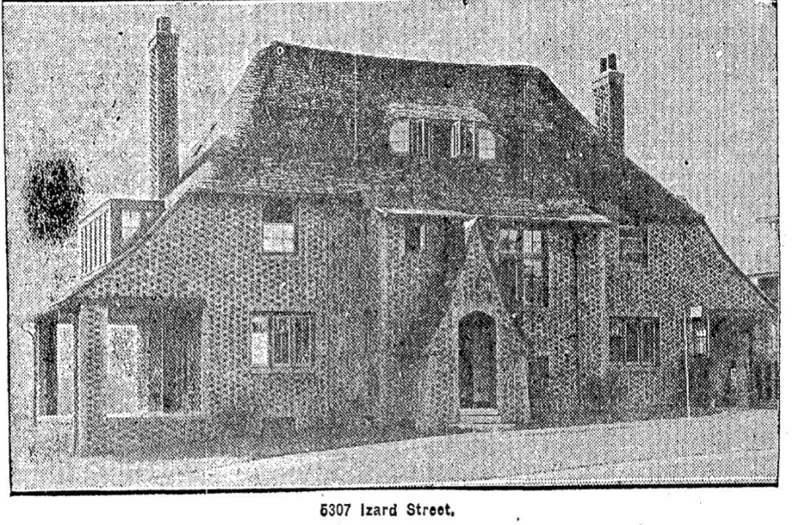
OWH archive. 1926. Newly completed home of designer-builder, Mac Ennis. I found Ennis had contracts all over town and although not an architect, Ennis was designing some wonderful, eclectic, European influenced homes.

OWH archive of August 30, 1931. The paper showed the new completed Mac Ennis home at 4537 Pine in Morton Meadows, described as an “artistic home”—same phrasing used for Hennig’s houses. 4537 Pine was also similar to the 1402 South 78th Street house.
We already have proof that the Ennis and Leydecker families were acquainted and had done business together. I began to wonder–did Mac Ennis build the 1402 South 78th Street house?

Lana says, “Forget Mac Ennis as the builder. My money’s on Hennig.”
Belle West, Enter Stage Right
In April of 1937, Belle West sells Lot 4 of Block 19 in the Loveland Addition to Raymond C. Leydecker. As the Leydeckers were already living there since 1932, according to the papers, I wondered if they had been renting a house all along from Miss Belle West. I believe that is the truth in this matter.
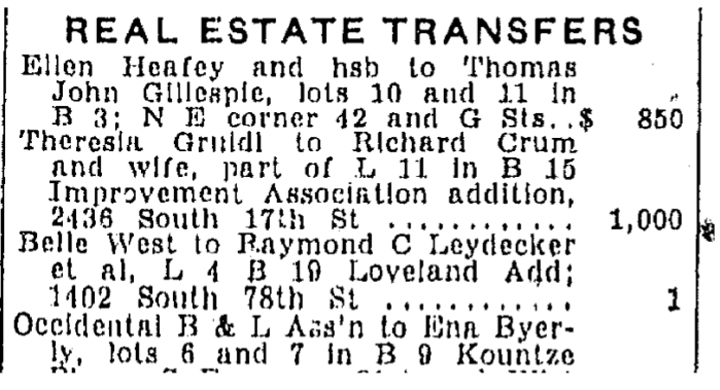
OWH. April 28, 1937. Typically when an address is listed with the legal address (ie Lot 4, Block 19), there is a home present.
Belle West is one of the many True Characters of Omaha that I have had the pleasure to come across. It was rare to find a young, single woman who owned property, let alone Loveland land, back in those days, so I was dazzled to find by 1918 Miss Belle was already recognized as a professional musician. She certainly had many talents that allowed her to make a living and make investments in her own name.
An Omaha native, Belle West was born in 1897 to Clement “Clem” Laird West and mother, Belle Day West. Clem West was employed as a custodian of the federal office building. Along with her lovely sisters, Eloise West McNichols, Madge West Black and Vivienne West Renze, Belle West made up the Omaha Famous foursome, the West Sisters String Quartet. Miss Belle and her three sisters performed as the West Sisters String Quartet in Omaha’s first commercial radio broadcast in 1922 on WAAW. Individually the West girls all played concerts and entertained at receptions both in Omaha and regionally for the International Lyceum bureau; they all belonged to the Omaha Symphony Orchestra.

OWH archives. 1926 photo of Belle West.
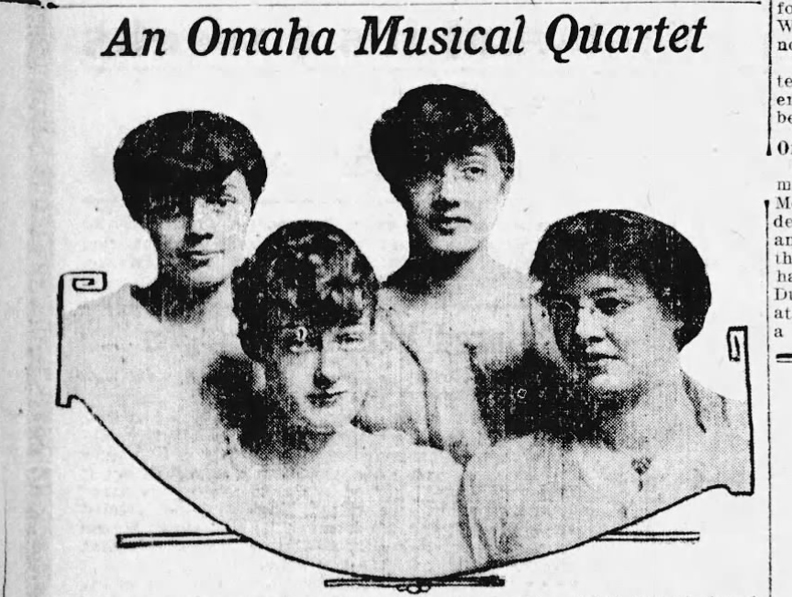
OWH archives. 1915 image of the West Sisters. Belle West is seen in the lower left hand side.
“A very unusual quartet of sisters are the Misses Eloise, Madge, Vivian, and Belle West, each of whom is a talented musician. They are a whole concert just in themselves. (…) Miss Eloise plays the organ, piano, violin and viola and sings. Madge plays violin, piano and viola and sings. Vivian plays the violin and piano. Belle plays cello and violin. Daughters of Mr. and Mrs. C. L. West.”
Clem West and wife Belle, along with all four girls, lived at 4170 Chicago. There is evidence the West family lived in the 4170 Chicago home by at least 1902. Why Grandfather James West’s funeral was held right in the front room. Of note, there was a steady line of pupils and music lovers alike who came and went from this home, as the girls gave lessons out of the home and often gave concerts open to the public. Belle and sister, Mrs. Vivienne Renze, lived in the family home until August of 1956. Their father and mother had died years earlier. The two sisters then moved into 4728 Wakeley.
I do not believe that Miss Belle West ever married. The other three West girls were eventually wed.
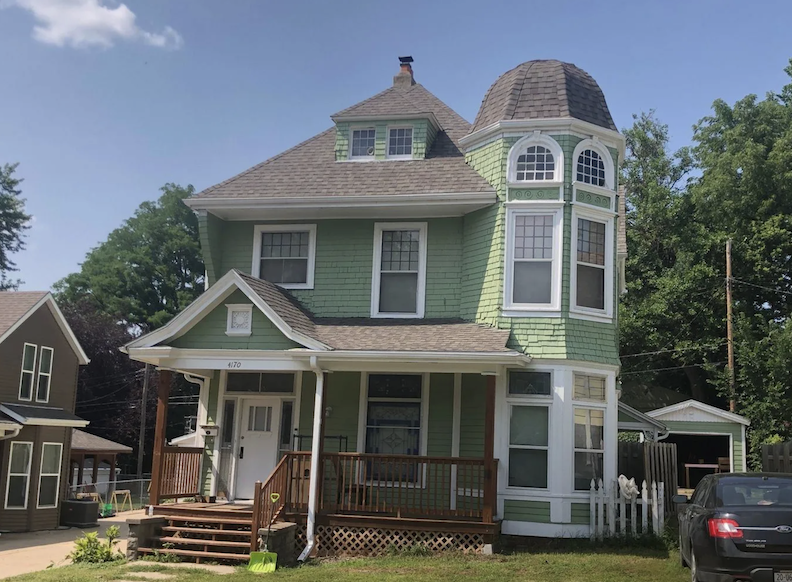
Oh this Dundee Darling… 4170 Chicago, site of the West family. I would never have left the family home either if this was the agreed upon settlement. Can you imagine the glorious music emanating from this shingled heaven on any given day? Incredible. Plan a drive-by today.
But she didn’t stop at music–Belle West would become known as an Omaha radio and newspaper personality. She began writing a regular shopper’s guide column for the Omaha Bee-News in the early 1920s. After selling her Loveland parcel to the Leydeckers, Belle would join the KOIL staff in 1937. By 1938 Belle used her fame to introduce a very popular 15-minute daily broadcast on KOIL called “Let’s Go Shopping with Polly” that ran for a remarkable 16 years. “Polly” educated housewives about new goods on the local market. She would leave radio in 1954 to be an account executive at Travel & Transport until her retirement in 1968. She died in 1988 at the age of 91, where she lived in the Masonic Manor. This Midtown Skyscraper is a frequent focus of My Omaha Obsession. Now called Elmwood Tower, 801 South 52nd Street was considered the original Omaha residential high-rise. Many of our investigations’ cast of characters have called this locale home. The triumphant Miss Belle is buried at Forest Lawn Cemetery.
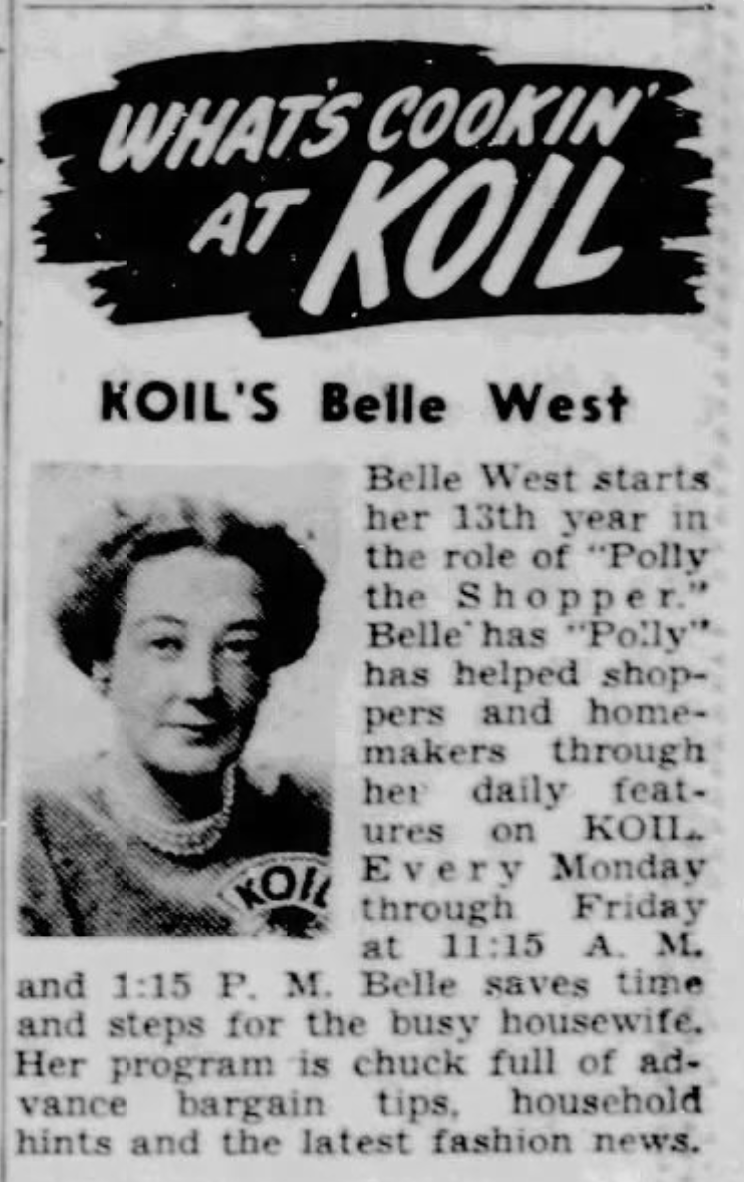
Here she is from 1950. “Polly the Shopper.”
It all made me ponder if Miss Belle bought 1402 South 78th as an investment, (which only made me curious how many other parcels she owned around town) or if she considered living there at one time?
The Leydecker Timeline
Let’s get reacquainted with our solid clues, shall we? Belle West sold 1402 South 78th Street to the Raymond Leydeckers in April of 1937. The family had lived at the address since 1932. One assumption might be that they were renting from her all along. Another assumption is that they were renting a house that later torn down.
In July of 1937 we learned that Architect Henning (sic) was erecting a new home on the southeast corner of 78th and Poppleton “for a client.” Name withheld. We are not 100% sure this was the 1402 South 78th Street home.
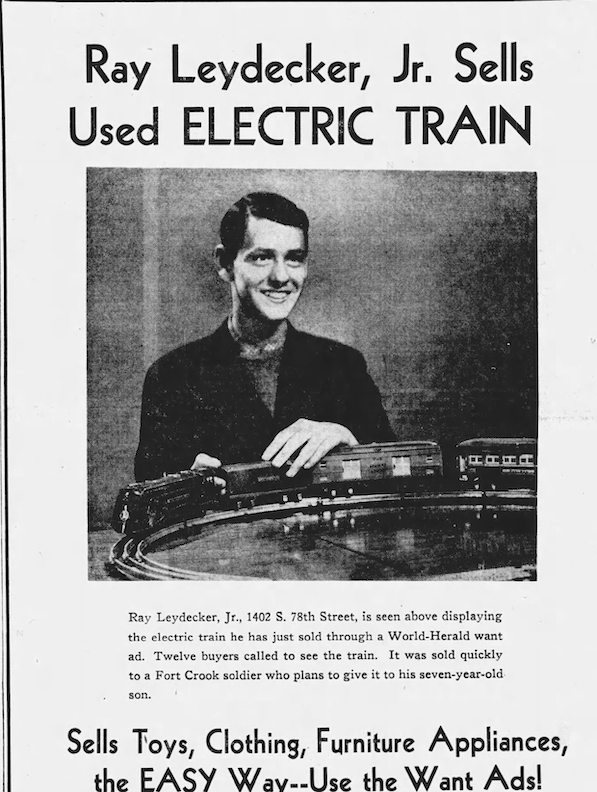
Junior Leydecker sells his train set in December of 1938. Obviously an advertisement for the World-Herald, set up by his ad man father.
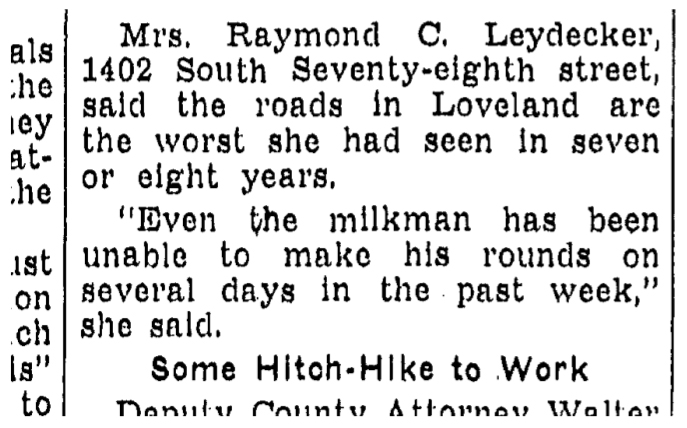
OWH archive. March 11, 1939. Mrs. Leydecker took issue with the roads in Loveland. Everyone collectively sighed, “Get in Line, Ma’am.” The article elaborated on the horrible 78th Street—terrible all the way from Keystone Park Neighborhood to Loveland. Mary Mullen said the road was the worst she has seen for 18-20 years. Which gives pause, how could they have been worse than the pocky Loveland of the last 30 years? (I think we all remember 78th Street before the recent sprucing and polishing. The neighborhood voted in 2016 to create a clever “street improvement district,” and the city helped pay to bring 78th Street and surrounding area up to city code by widening, repaving, installing curbs and gutters.)
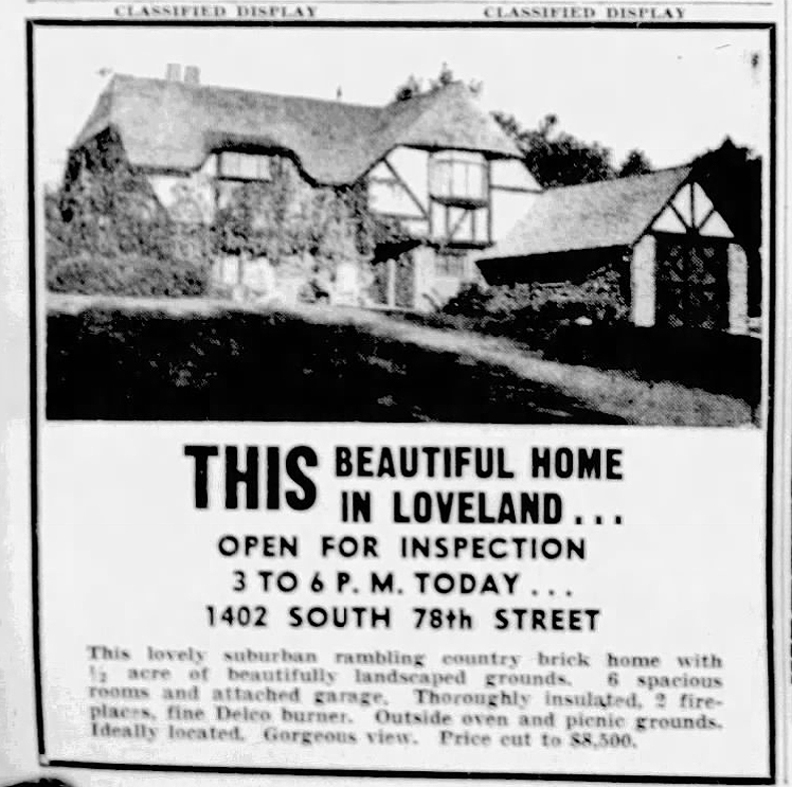
And then…..what we have all been waiting for. The historic photo of 1402 South 78th Street. OWH June 25, 1939. The Leydeckers decided to move. Was it 78th Street that drove the Mrs. bananas? Brick home 1/2 acre. 6 rooms and attached garage. “Thoroughly insulated, 2 fireplaces, fine Delco burner. Outside oven and picnic grounds.” It did look strikingly similar to the work of my architectural crush, Reinholdt Hennig.
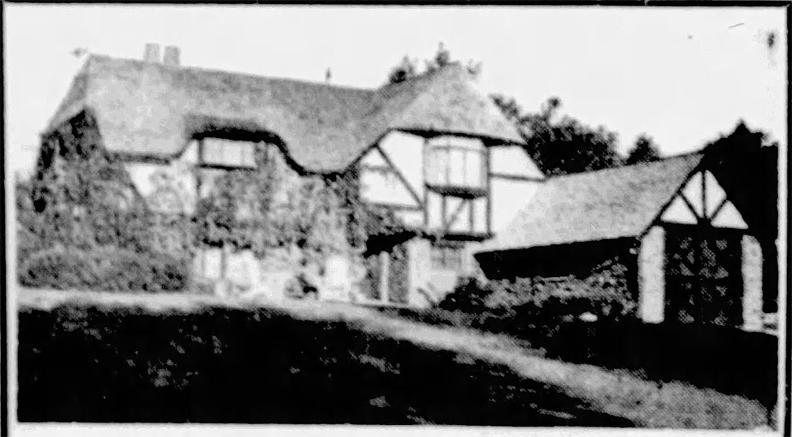

For comparison–the 1939 image with the 2017. The earlier house photo appeared to display a thatched roof of steam bent shingles. This created a wonderful European village effect especially with the eyebrow windows. I spy two chimney pots rising on the south end. As one can see in the 2017, there is an addition to the southern side with the garages added. Was the current library-family room functioning as an early garage? It certainly looks that way. My big question: how did those vines grow on the house within this 1.5 to 2 year time period and the shrubs too? Mr. Cassette advised that if the greenery was planted in the spring one year and the photo taken year and half or later, that it was possible for it to grow that much. but I had my doubts. The foliage meets the architecture made it look like a much older home. Deceiving photo all around. Also how did the photographer get this 1939 angle? It looks like the home is on a hill. A bright hill, at that. Was the land leveled at a later date or was I misperceiving shadows?
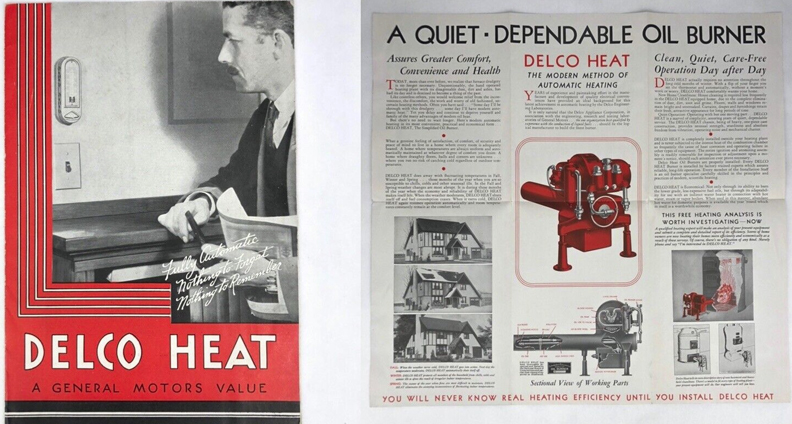
1402 South 78th Street’s “fine Delco burner” refers to the Frigidaire Delco Oil Burners, a product of General Motors, also known as “Delco-Heat.” The most modern method of automatic heating at the time. Image of the 1932 DELCO HEAT Foldout Brochure Poster AUTOMATIC OIL BURNER GM.
It was not shocking to find she sold in less than a month. The OWH real estate sales revealed that in July of 1939, the Leydeckers sold our 1402 South 78th Street darling to K. L. Willmarth and wife. The 1940 United States Federal Census logged the Leydeckers residing in Beverly Hills, Los Angeles, California. Son Ray Jr. was then 15 years of age. At the time of the 1942 World War II Draft Registration, Mr. Raymond Leydecker was 45 and the family had again moved to San Francisco. Raymond Sr. died in San Diego in 1965.
The Willmarth Expansion
The Willmarth family took up the keys for 1402 South 78th Street in July 1939. Kenneth Lisle Willmarth was born in 1889 in Chicago. He became known in Omaha as a commercial artist and local painter. At the time of his one man show at the Joslyn, Mr. Willmarth was said to be “one of Omaha’s leading commercial artists.” His wife, Isabell was also born in Illinois; they had children, Elizabeth and Kenneth Jr. Take notice that the Willmarth couple were infamous bird enthusiasts. Apparently they were known for having made 1402 South 78th Street an aviary. I believe that is, in part, why they expanded the 1402 parcel to include Lot 3 next-door. In December of 1939 the Willmarths cleverly acquired Lot 3 in Loveland, extending the 1402 South 78th Street property to the north.
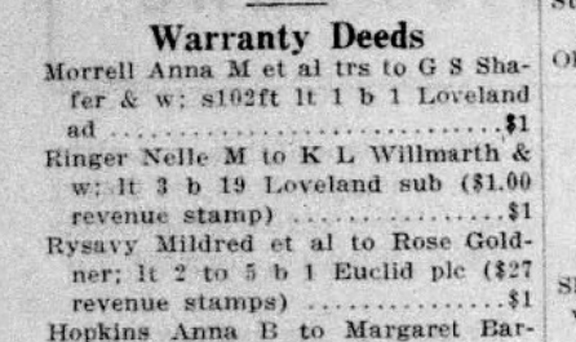
Daily Record Dec 1939. Nelle M. Ringer sold to K. L. Willmarth and wife. Lot 3 of Block 19 Loveland.
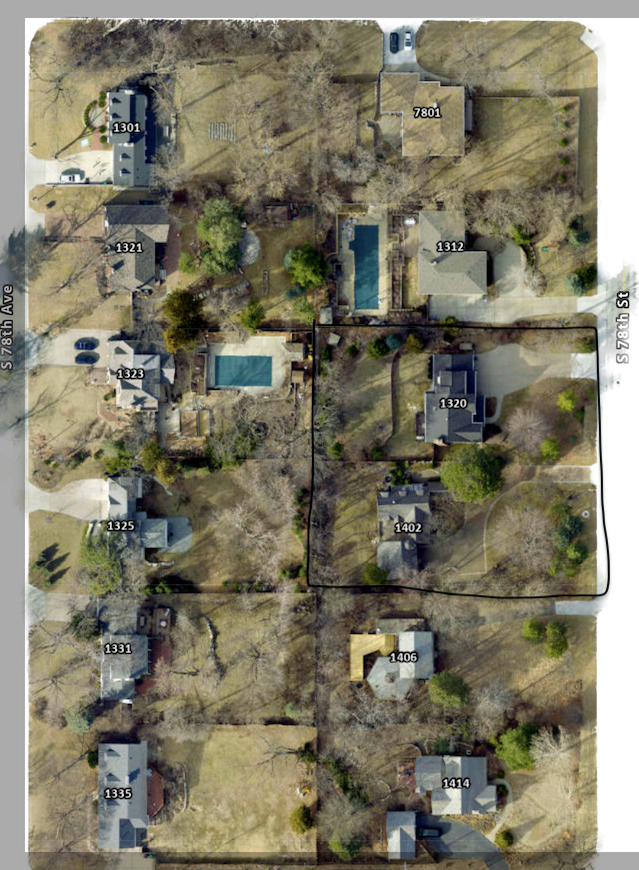
The merger of Lots 3 and 4 (outlined in black) would become a larger, even lovelier 1402 South 78th. 1302 South 78th didn’t have its own address at that time.
Now let us attend to this bird business before we move on.
By 1941 Kenneth and Isabell had turned an extra bedroom in the gorgeous 1402 South 78thStreet home into an aviary where they observed “the habits of countless varieties of finches, canaries and parakeets.” A scandalous news article of 1943 announced the couple had an adjacent property to their home where “they have a fully equipped aviary to house their 50 to 60 feathered pets.” Apparently they could not purchase the heating equipment for this other structure in a timely manner, so the birds were moved into the house proper.
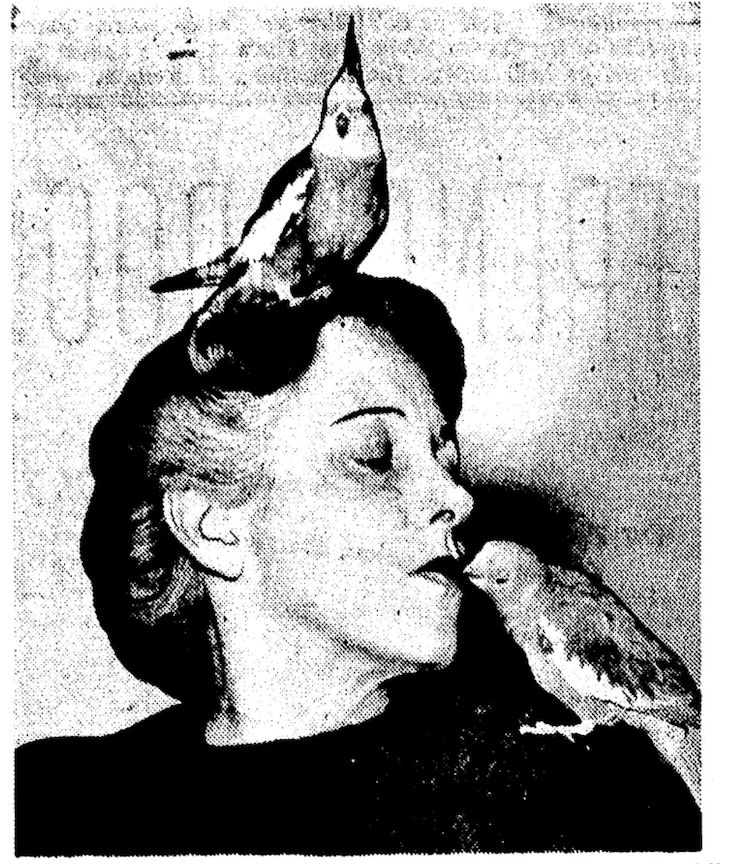
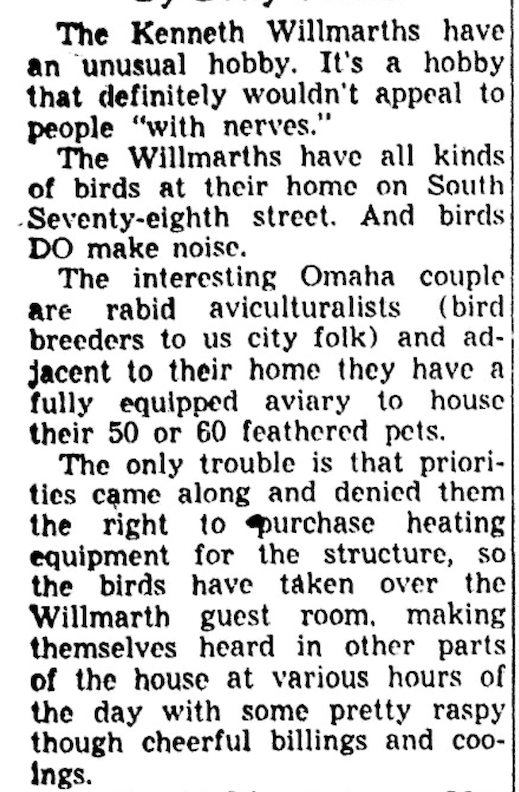
OWH archive. February of 1943. In Love with Mrs. Willmarth and this photo taken by Omaha photographer, John Savage.
The Cottage Lot
Poppleton to Woolworth, all along 78th Street was said to become a heavily wooded tract as time went on. Other details describe this street and surround as “the woods of Loveland.” Certainly the augmented 1402 South 78th Street was a dreamy, arboreous swath. Whether an extant structure was located on the northern Ringer property or subsequently built by the Willmarths, there was said to be a quaint little cottage on the Lot 3 adjunct parcel. I believe this little cottage was both what the Willmarths had referred to as their intended aviary and what Mr. Tanner had described as “small stable next door to the north, which was smaller than any home in the area.”
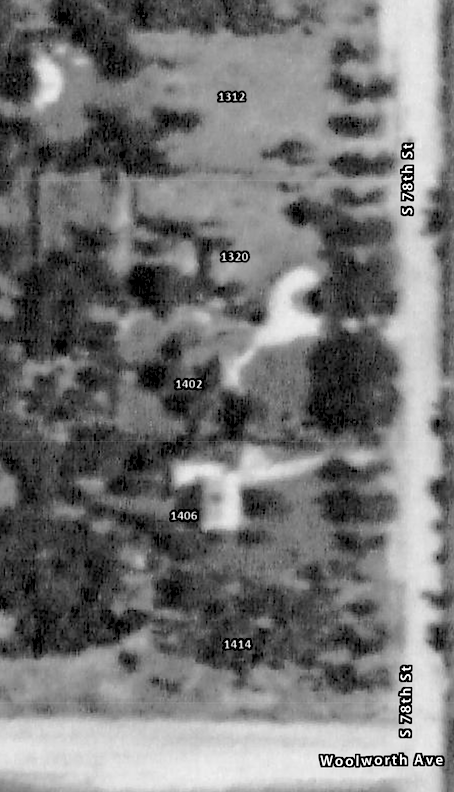
Image borrowed from DOGIS. This 1941 aerial, as foggy as it is, shows the Willmarths made a lovely curving drive off of 78th, that could turn left into the house proper at 1402, or glide to the right into what would become the 1320 property next door.
Over time this northern building was chronicled as a “Bachelor Haven,” “Loveland Cottage” a “cabin,” “cottage,” “the Doll House,” and “hideaway.” Initially the Willmarths would advertise it at the summer house to the main house. Over time it would be rented out as additional income for whomever owned 1402 South 78th. I was available to entertain any of these options at any time. I was in love with this idea. In the thick of the “wooded lot” there sat a four-room cottage, with two to three bedrooms dependent on who was describing it, with an outdoor brick barbeque and patio. Imagine wandering over to your other little Doll House in the woods as your family argued over what to watch on television in the main house. Yes, yes. This whole idea suited Miss Cassette rather well.
By 1943 the Willmarths sold lots 3 and 4 to F. J. Rueth. I have the history of homeowners upon request but I won’t continue to log them and their history here for brevity.
A Quick Walk Through the Years
Through the years of real estate marketing, 1402 South 78th Street was promoted as both English! And French!
Highlighted features were its Clinker Brick
Three bedrooms
Long living room with fireplace
Tile
Good Housekeeping Kitchen
Three patios
Summerhouse-Guest House
Thatched roof
Full acre
Tall, mature trees
Beautiful grounds
beamed ceiling in living and dining room
cathedral ceiling in family room
3 fireplaces (Did they mean with the additional Doll House guest accomodations?)
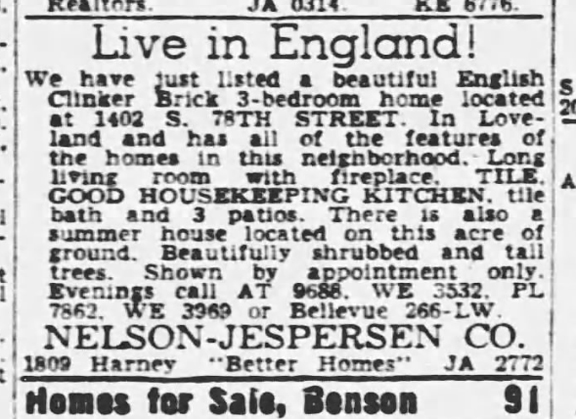
October 1948.
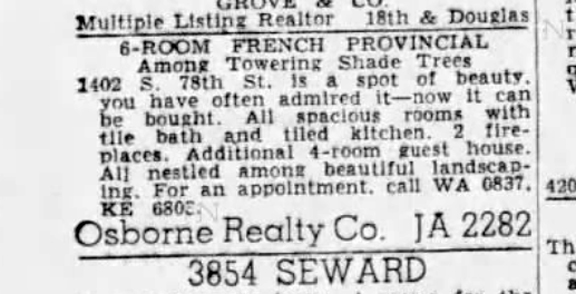
OWH. 1952.

OWH. 1959. In 1959 the small Doll House had earned her postal address at 1320 South 78th Street. Even though it was listed for sale, I do not believe this property was separated by deed from the 1402 main house property. Even in the 1960s, little 1320 was rented for just $80 a month. It didn’t rent out for much more in the early 1970s.
Observe by the 1975-1976 time frame our little Doll House was refashioned into a bathhouse and a new inground swimming pool was installed on the secluded lot.

OWH archives. 1979. The 1402 South 78th Street home was put up on the market in 1979 and that is where we come by our second coveted glimpse at a historic photo of today’s obsession. For sale at $179,000 or lease $850.00 a month. The main house was said to 2,200 sq ft and the guest house-bath house was 1,100 sq ft.
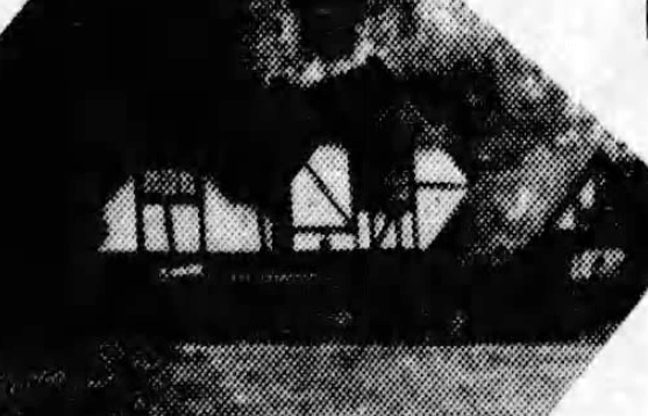
1979 magnified from the previous ad. Sad, little, tormented image as it was, our only chance to peer a bit deeper at Miss 1402 South 78th Street. It does look like it’s on fire or about to be hit by a major storm, no?

1939, is that you? Yes, there you are. It is impossible to see but I deliberated about the removal of the thatched roof from the 1979 image.
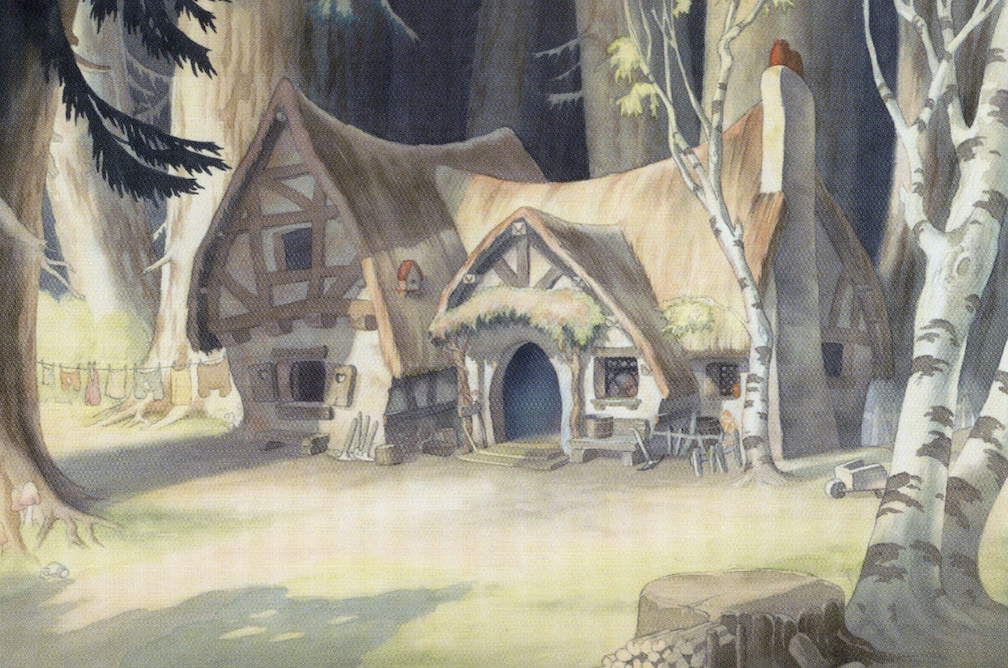
I had to add this one in just for my own fun. The Cottage of the Seven Dwarfs.
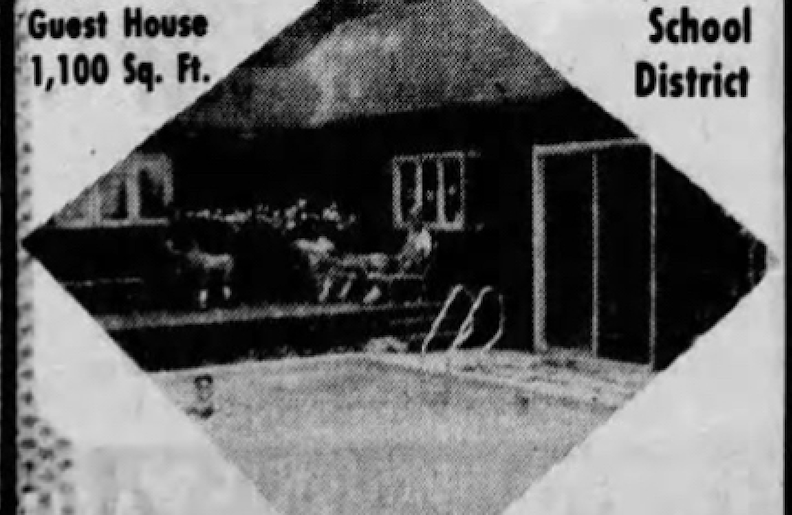
Very hard to get much detail–appears to be an L shaped building, with pool nestled in the angle, low profile, simple windows and sliding glass door. Quite possible stripped down from its rustic appearance in the 1970s and modernized with an additional wing added. I have no proof of that—just ideas from looking at this cloudy photo.
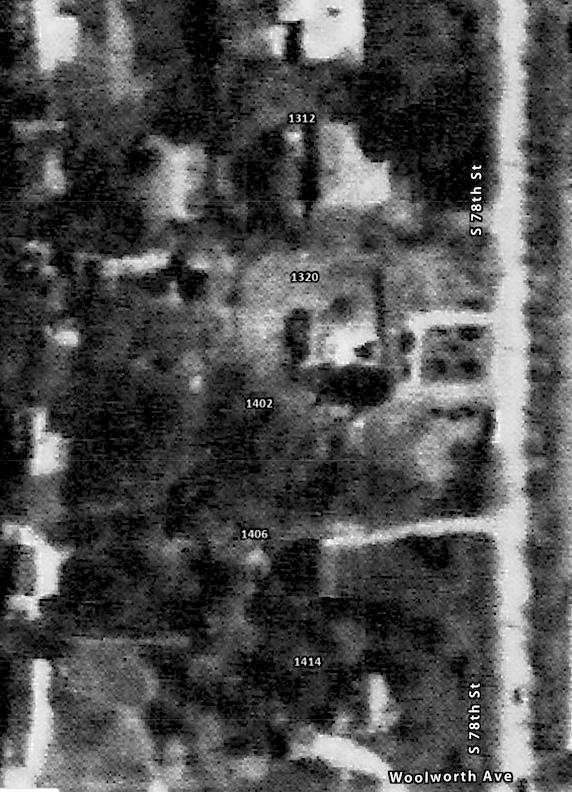
1982 aerial from DOGIS. There is more of a horseshoe drive observed, connecting both 1402 and 1320. If you squint, you can see the L shape roofline of the guest house enclosing the swimming pool, seen in the clearing from the trees. 1402 South 78th Street is completely undercover of the woods.
Secluded Loveland Wood is Divided
As previously mentioned, homeowner Mr. M, in the fall of 1986, made an addition to the 1402 South 78th Street home. The building permit record that I found noted inclusion of the garage, room addition and deck. The home now sits at 3,611 sq ft. Moreover in July of 1989, Mr. M sold Lot 3, the 1320 South 78th Street property for $35,000, essentially separating this parcel from the 1402 South 78th Street parcel. The price point was interestingly low for including a house and a pool, even for 1989. Did this signify that the bathhouse-guesthouse had possibly been razed or that the unground pool was excavated and filled in?
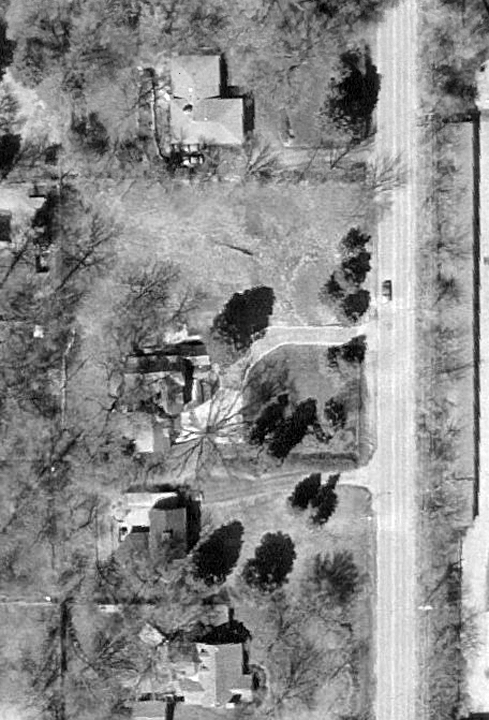
1993 aerial from the DOGIS website. The little cabin turned guesthouse and its pool had vanished.

And here we are having circled back to the current neighbor to the north. In June of 1993 Willard Construction began building the single-family dwelling at 1320 South 78 St. for $86,772. By January of 1994 there was an open house for the 2,674 sq ft property. It has been owned by the same family since it was first built.
The once joined Lots 3 and 4 have now remained two distinct parcels ever since the late 80s.

Kids, the plot is going to thicken. Or at least get more tangled. Ava says go freshen up your drink.
Part Two
The Hennig White Whale
As we have scoured, there have been no obvious traces of our architect Reinholdt Hennig or mentions of 1402 South 78th Street’s connection to his French Normandy series or whisper of the Windfall house, let alone the fact that this house was reputed to have origins back in France. For some in our group of skeptical sleuths, all of these missing pointers may imply there is truly no verifiable connection between 1402 South 78th Street and Hennig. We all know no one likes a tidier case than I, the one trying to piece together this murky puzzle. As hard as I tried to make a clear case, I could only present the clues I unearthed. Entanglements aside, after all these months I have come to realize there is an argument and grounds for this home being designed by Reinholdt Hennig. And even why it is that we can’t seem to find that information.
The evidence will show that Reinholdt Frederick Hennig’s breadth of architectural work is not well documented. For what it is worth, the Nebraska State Historical Society and other architectural sites do not include all of his designs, hence my difficulty in solving what I called the Hennig French Fairytale Cottage…ahem French Triplet series. All of his buildings are not logged for posterity. In complete Omaha fashion, those who own Hennig designed homes typically know of his name through their house pedigree papers or past owners’ word of mouth. Perhaps this is my call to all of you Hennig Obsessives, to share your Reinholdt Hennig designed addresses with me (us) so that we can begin to compile a formal, comprehensive list. The situation with 1402 South 78th, as you know, is that they do not have the architect’s plans or paperwork to prove its origins. The fact that 1402 South 78th Street was not written about or introduced to proper society means little in this case. It is still plausible that it is a true Hennig. Let me get back to my theory, after this brief history of Hennig. There were a few things I needed to inspect and straighten out, if only for myself.
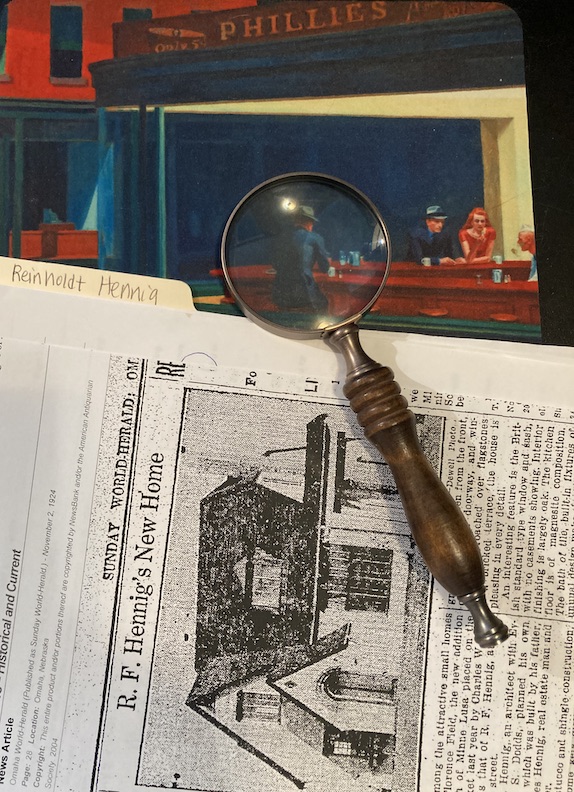
Hennig History
Father Charles Leonard Hennig, Omaha realtor and building contractor, was a native of Germany. Hennig Sr. claimed in early Omaha Bee interviews to arrive in the United States in 1862, at age 4. “He was one of the first pioneers in South Dakota, homesteaded near Humboldt in 1878.” He was a merchant in Spencer, South Dakota and in Creston, Iowa before moving to Omaha in 1912. Prior to this move, Charles Hennig married Anna Henrietta Woodrich; the couple had four children: Effie, Alma, Charles Leonard Jr. and Reinholdt. Reinholdt’s U.S. World War II draft card exposed he was born in Spencer, South Dakota in November of 1901.
At the time of the 1920 United States Federal Census, Reinholdt was 18 years old, was not yet employed and had no trade listed. His older brother Charles worked with their father, both logged as real estate agents. Consider that young Reinholdt was not of the age range to have served during World War I. I had not known or considered this myself back in 2016. I double checked the 1930 U. S. Federal Census where Reinholdt denied being a veteran when asked. Both of these clues helped clear up this earlier discrepancy in the French Normandy triplet lore. Reinholdt Hennig was not the American soldier who was rumored to have crawled to the French farmhouse during World War I.
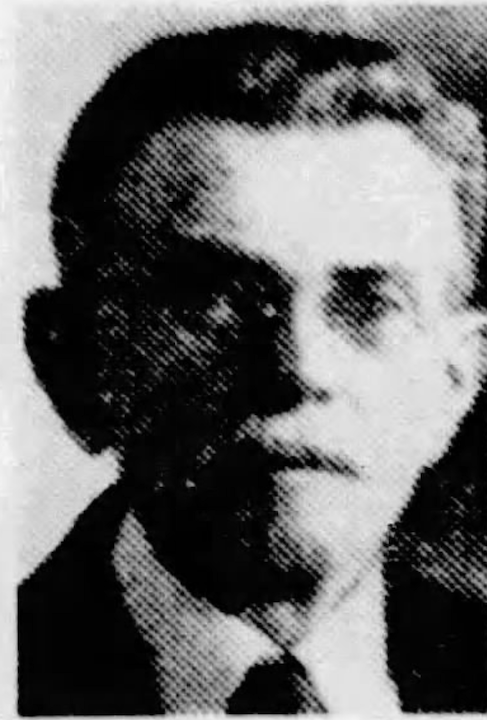
Charles Leonard Hennig, early realtor and builder.
In June of 1923, Reinholdt married local Omaha girl, Ruth Madden, when they were both 21 years of age. (Evening World-Herald and the Nebraska Marriage Index.) The couple would eventually have four children, Betty Clare, John Francis, Thomas Michael and Mary Ellen. (The Evening World-Herald reported Mary Ellen was born in 1942, but I believe must have died in infancy or at a young age.) Wife Ruth Madden Hennig’s father was H. C. Madden, a railroad mail clerk. Interestingly, in the early teens Mr. Madden began digging a tunnel from his 6101 Florence Boulevard home to his garden at the bottom of his hill, behind the house. He toiled at this passion piece in order to save precious time walking back and forth from his garden. Mr. Madden’s achievement is thought to be one of the first tunnels of Florence. His tunnel was later lined with concrete and had electric lights. It became a point of interest when local people were wanting to tie Florence tunnels to Prohibition times in the 1970s and 80s.
No Training?
Part of our Reinholdt Hennig’s speculative chronicle is that he “received no formal architecture degree but entered private practice in Omaha in 1924.”
I discovered Reinholdt worked as an assistant observer with the United States Weather Bureau in 1923, according to the city directory. 2429 Ida was home to the whole Hennig clan at that time–both father and two sons.
A month after Reinholdt married Ruth, he filed, what I believe to be, his first building permit—potentially his first completed architectural design. The following announcement proclaimed he was an architect with Everett S. Dodds. One could do no better than to apprentice under Everett Sherwood Dodds. This would have been an excellent exposure for a young man. Please review this impressive output from this consummate professional. Everett Sherwood Dodds History.
On that note, I scurried and spade to see if Hennig perhaps collaborated with Dodds on the 1402 South 78th Street or if Hennig worked under any other firm at the time of 1402’s build date. No luck.
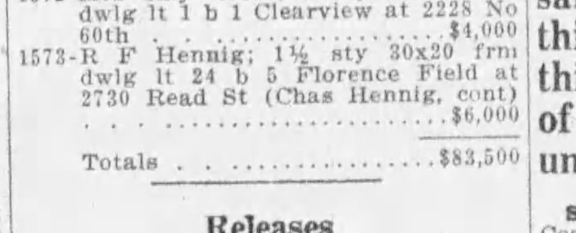
The Daily Record archives. August 1924. Building permit for “R. F. Hennig; 1 ½ story Florence Field at 2730 Read St (Chas Hennig, cont).
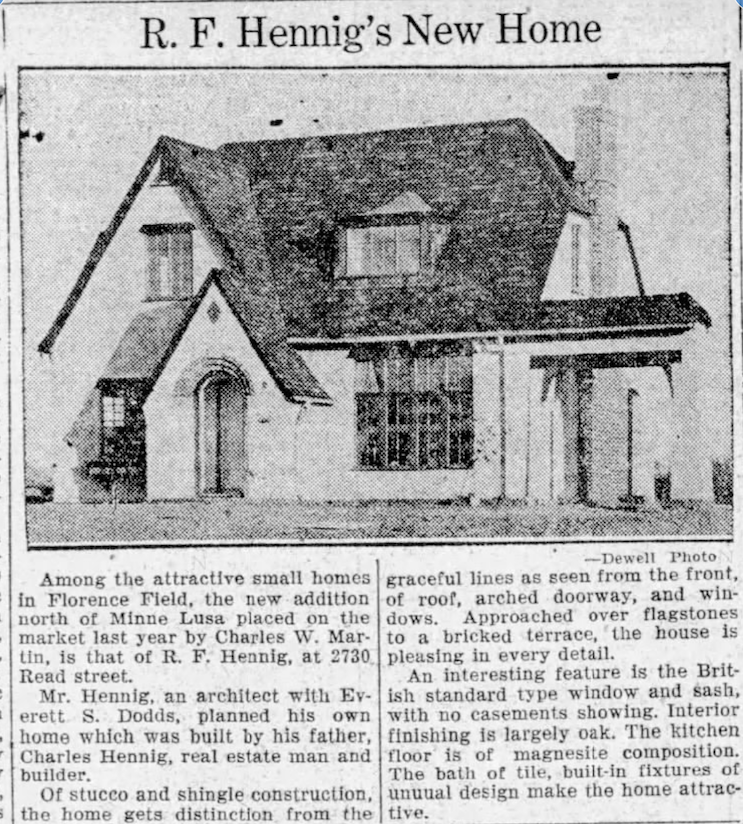
Omaha World-Herald archives. November 1924. “R. F. Hennig’s New Home” North of Minne Lusa. “Mr. Hennig, an architect with Everett S. Dodds, planned his own home which was built by his father, Charles Hennig, real estate man and builder.”
“An interesting feature is the British standard type window and sash, with no casements showing.”
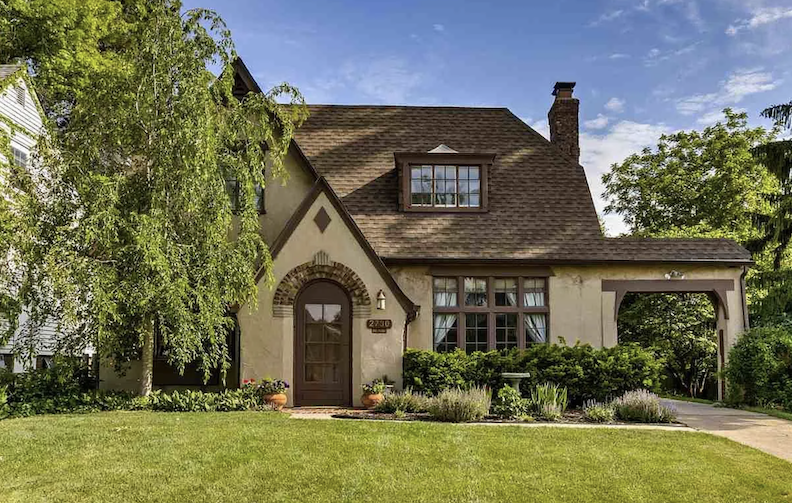
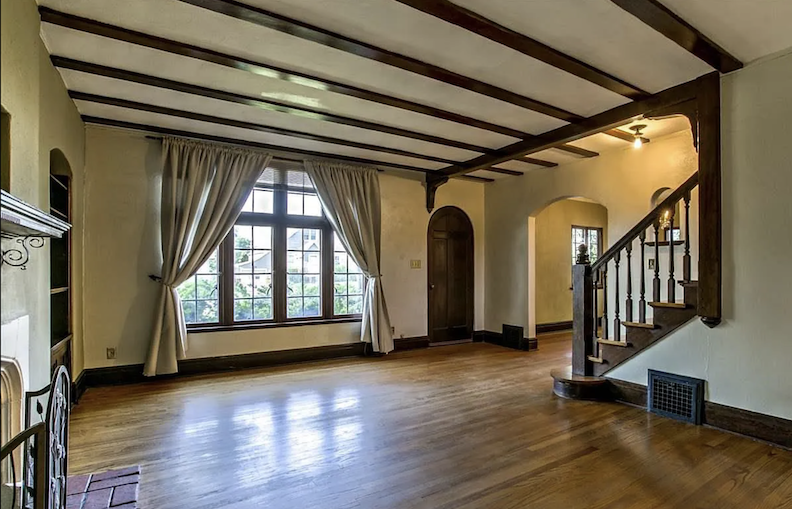
Here is Hennig’s lovely 2730 Read Street as it looks today. I am showing the interior to set the stage for what’s to come and give an ideal of his aesthetic.
As I’ve already mentioned Father Charles Hennig was a builder and realtor. By 1925, Charles Hennig was working under the firm Charles Hennig & Son. “Builders of Homes of Individuality.” Not the catchiest motto. I thought early on the “son”of this business was Reinholdt’s brother, Charles Jr. But what if it was our Reinholdt? All the more field experience for Reinholdt. His building contractor father didn’t retire until 1930. My point in all of this is that Reinholdt Hennig was raised up in the business of buildings–architectural design and construction. His formative years in a construction-focused family, as well as his apprenticeship with Dodds was certainly enough to launch an architectural career in the 1920s. So while I could find no formal education, like my predecessors, it helped me to understand Reinholdt Hennig didn’t just pick up some 1920s calipers and hang a shingle. As it turned out, Brother Charles L. Hennig, Jr., was a later coal man, having taken ownership of the Central Coal and Coke Company with Clifton Wood in 1938. Interestingly Charles, Sr. and Charles, Jr. continued to live together until Sr’s death in 1941.
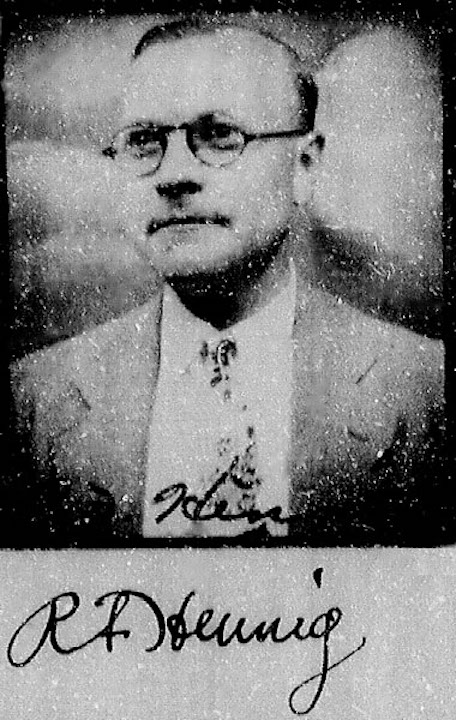
I just love this smoky, speckled photo. Reinholdt Frederick Hennig photograph borrowed from the Nebraska State Historical Society.
Architect Hennig created many “artistic” apartment buildings and homes in Omaha during his colorful, curious, reaching career, which I will enjoy outlining for our group a bit further on. My surprise came when I found of the many lawsuits (potentially a normal thing in this line of work?) involving frequent mechanics liens against Mr. Hennig. If you recall I had only just learned what a mechanics lien meant in the earlier examination of the Hoagland vs. Underwood case.
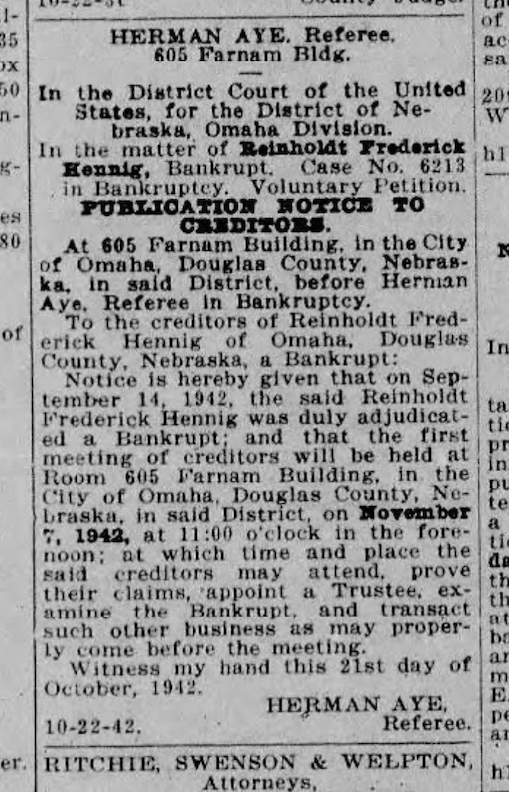
The Daily Record of October 1942 then announced Hennig’s dismal bankruptcy notice. I recognized the timeline here and that not alot of homes, let alone artistic European style cottages, were being built in these slim war years.
It seems that in the years to follow, our man Hennig secured a more dependable source of income, if not somewhat repetitious, as design and construction manager for Safeway grocery stores in Nebraska and Iowa. I found solid proof of this career transition dating to 1945, although it might have happened earlier. He must have given the grocery chain his all and found the challenge rewarding because in 1960, The Kearney Daily Hub reported R. F. Hennig was out in their neck of the woods overseeing the building of one of his many Safeway stores. They remarked that Hennig had been head of the Safeway Stores Omaha division construction department for 15 years. If anyone has an original Hennig Safeway design photo that they’d like to share for this article, I would be grateful to give you credit.
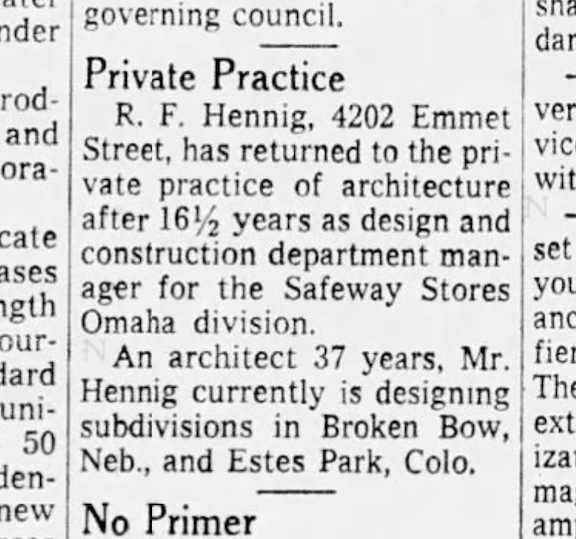
OWH archives, December of 1960. Announcement of Hennig’s triumphant return to his private practice of architecture. The creative wheels and whims were churning again. What glory awaited Omaha? The article shed light that this visionary was working on a residential project in Broken Bow.
I was saddened to learn Reinholdt Hennig died in 1961 in a motel room in Columbus, Nebraska. The Custer County Chief reported Hennig “had been working on the plans for a residential building development on the hill immediately south of Broken Bow.” It is rumored he died of a heart attack but I have no solid proof of this. His Evening World-Herald obituary of March 1961 reported Hennig “entered private practice last July after 16 ½ years as design and construction department manager for Safeway Stores Omaha division. He had been in the business 37 years.

Reinholdt Frederick Hennig’s simple flat grave marker. Find a Grave photo by KDQ. Architect Hennig is buried at Forest Lawn Memorial Park.
The Seen and Unseen Portfolio
The Seen File
Although a known Omaha architect in some circles, Reinholdt Hennig is not as prolific or respected as other local designers, possibly because of his lack of formal education. While his public and apartment buildings are fairly well documented, it is sometimes repeated in the archives that Hennig only completed thirteen house plans in Omaha. The formal list of buildings and houses typically includes the following, but this is not exhaustive:
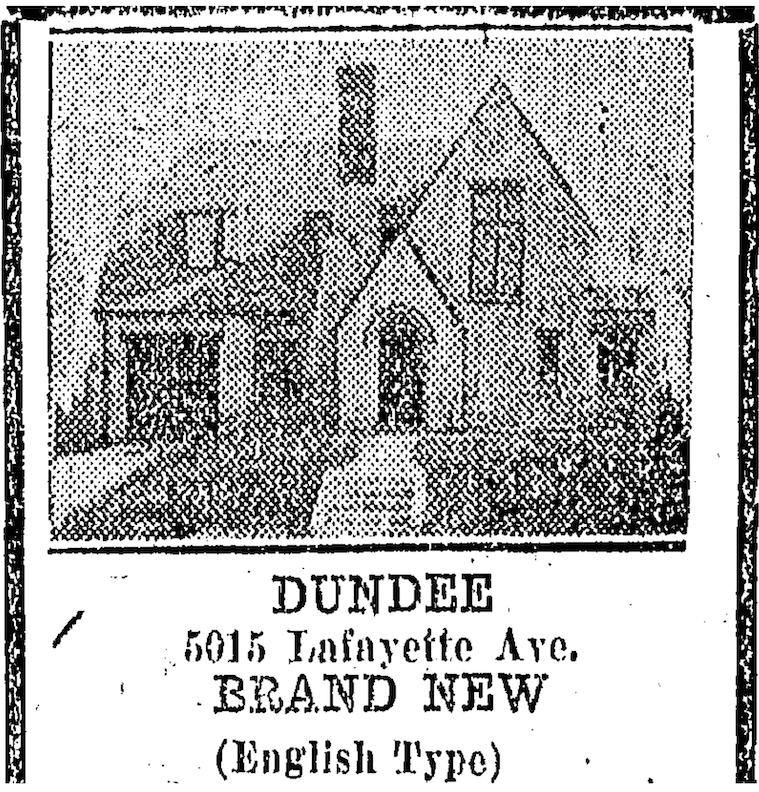
The 5015 Lafayette Avenue house historically labeled as being built in 1926, was actually completed by September of 1925, according to this OWH ad. And here is how she looks today. Aged to Perfection!
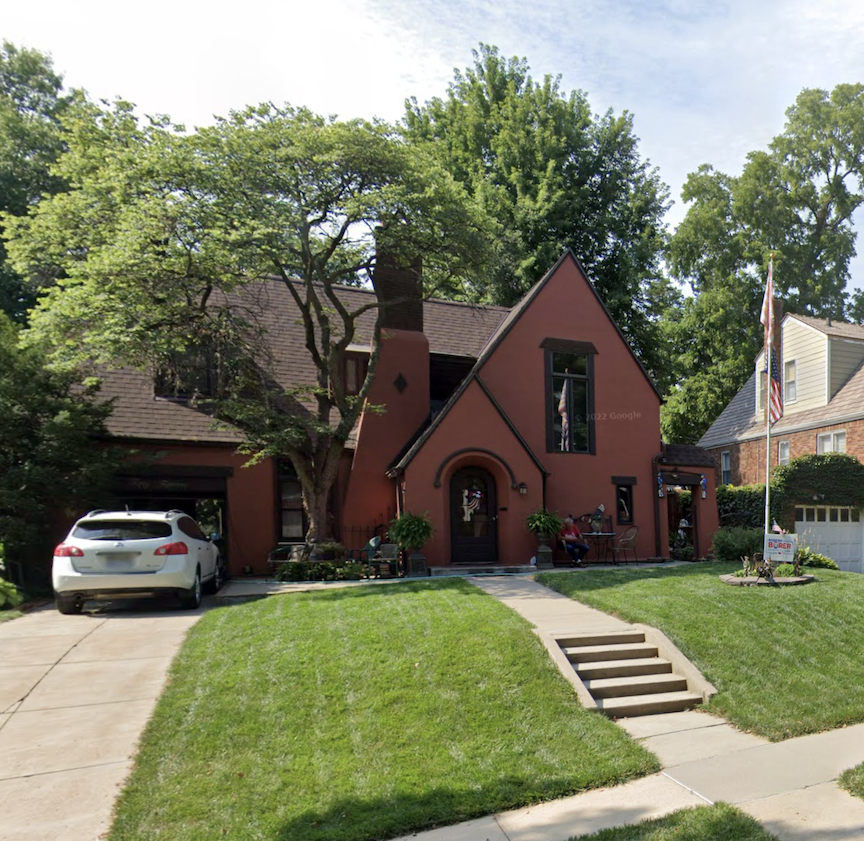
Hennig’s house at 715 J.E. George Blvd built in 1927. Written about and shown earlier.
The Scott Wilber house at 808 S 67th built in 1927. Written about and shown earlier.
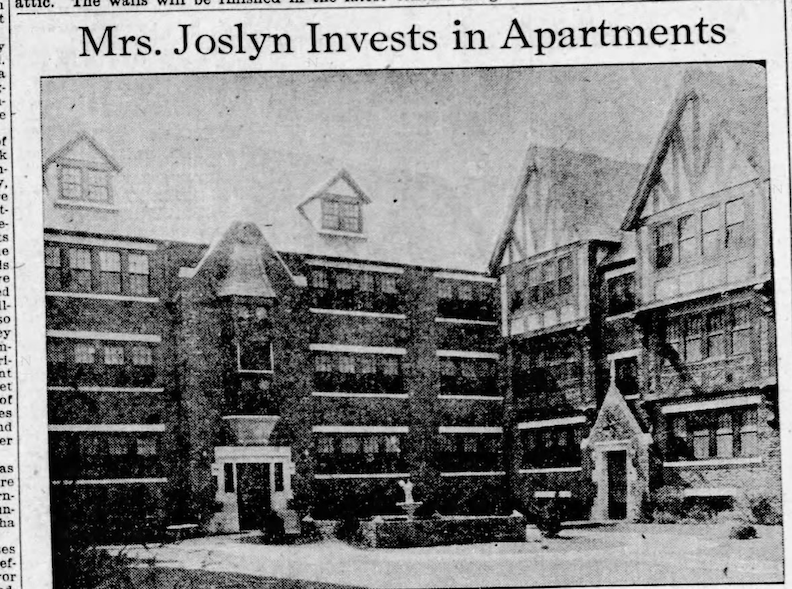
Buckingham Manor at 49th and Chicago. (1928) Rustic Clinker brick, varied colored slate roof.
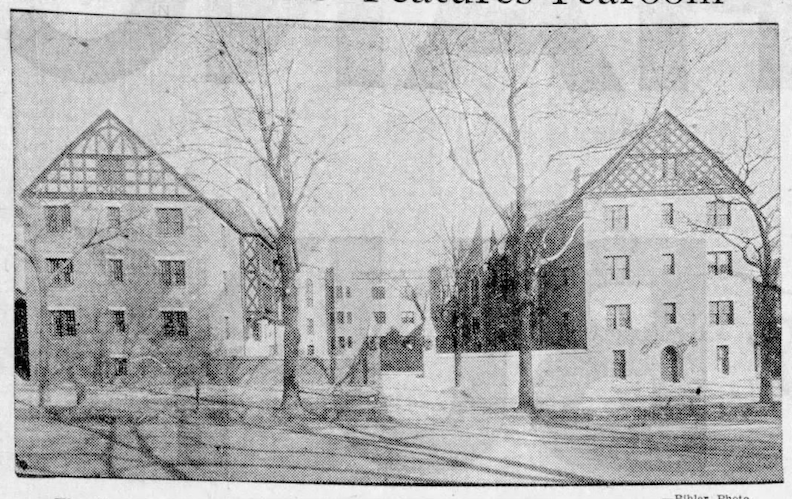
Tudor Arms Apartments (1929), 131 S 39th, featured a lovely tearoom from renters.
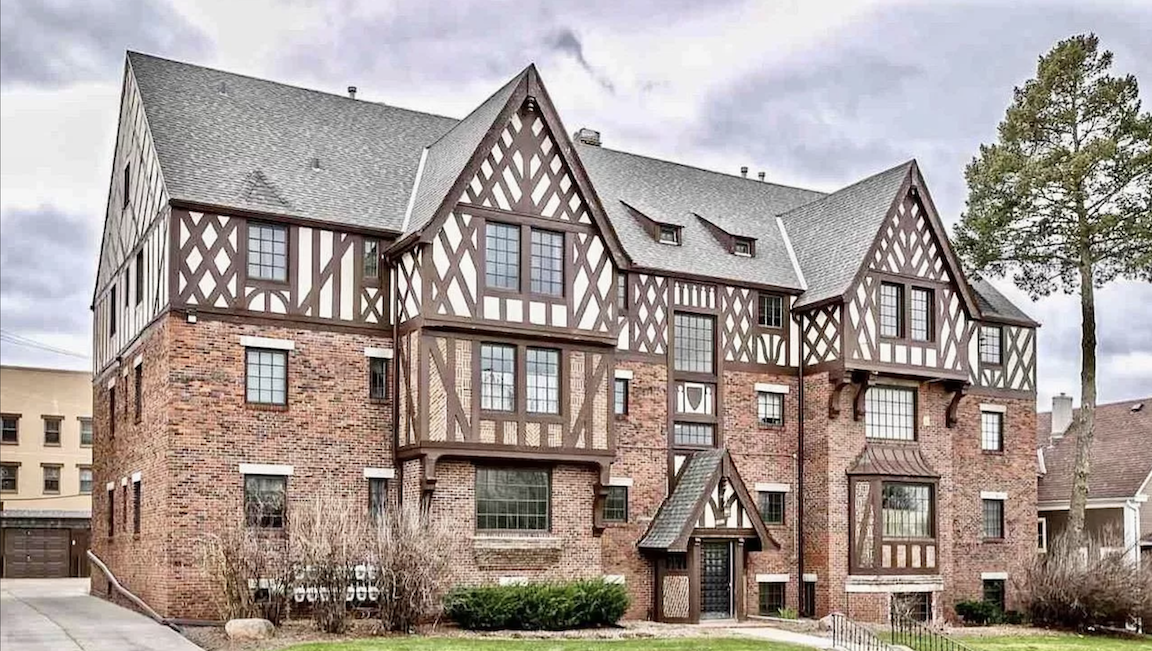
***Addendum of March 25, 2024. Samantha wrote in and let us know that her home, the Arlington Manor in Dundee, at 4907 Davenport is a Hennig. It was built in 1929. Thank you so much!
But it wasn’t all massive chimneys, stucco and heavy timber doors for Reinholdt Hennig. In 1933 he made a major shift, pushing himself and what others thought of his design capabilities. He had his baptism in modernism while drafting the model home for the Junior Chamber of Commerce.
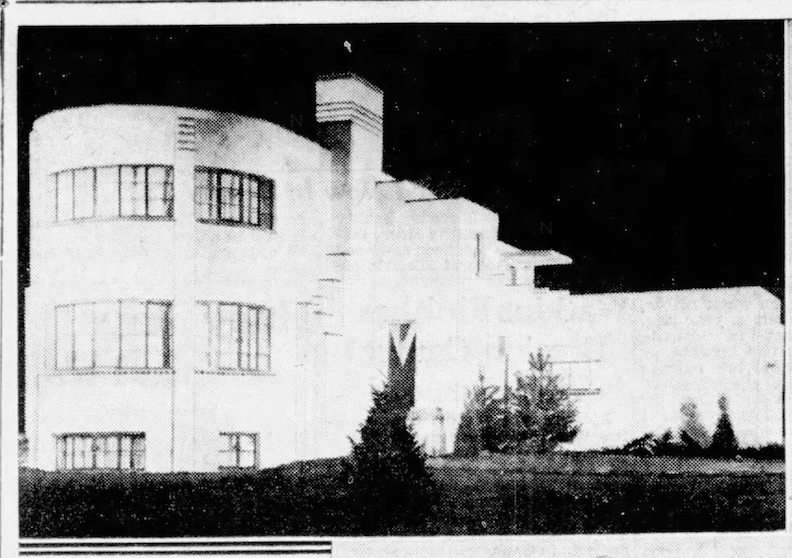
Built in 1933 at 2043 North 53rd Street, this structure gained Hennig much attention. His House of Tomorrow was a high point in his career.
In 1933 Hennig was named Architect for the Junior Chamber of Commerce model home. John J. Gillin, Jr. chairman of the board, insisted, “The new house will not be a freak. It will contain all modern improvements and the latest household applications of practical use, but it will not be an impractical futuristic dream.” I had to wonder if Gillin spoke in this manner because people were hesitant about a modern home or were they leary of Hennig. This project was soon after label, the “House of Tomorrow.” This became Hennig’s most well known, significant building commission.
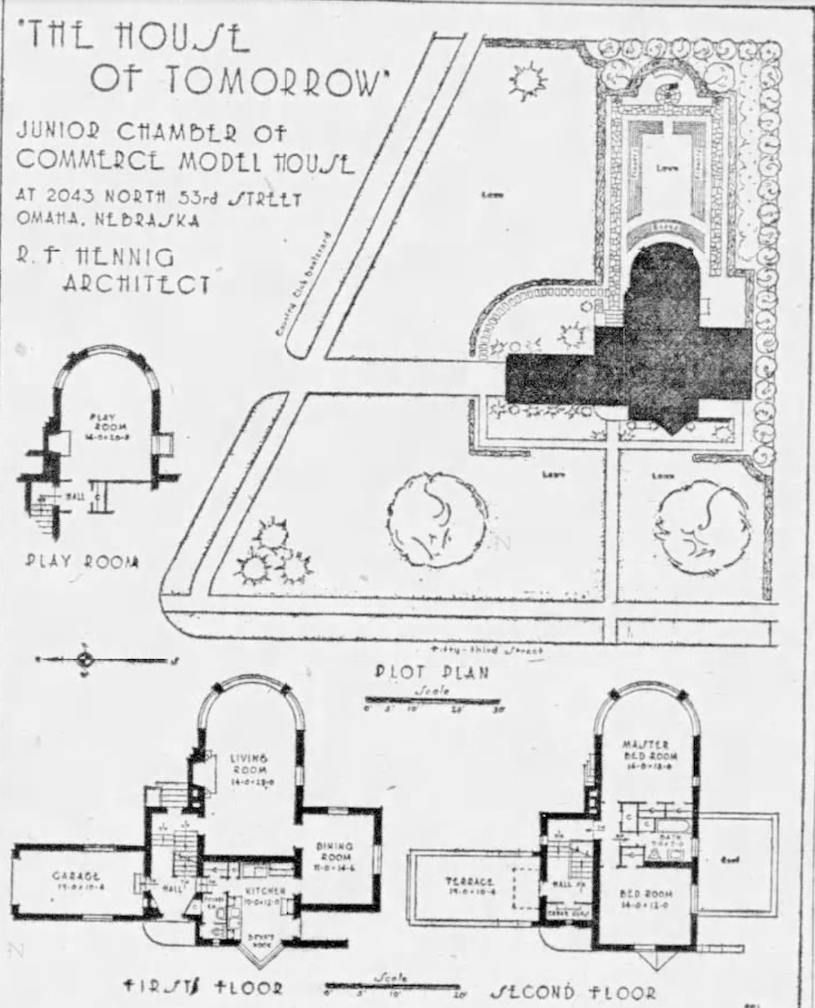
Another great example of the art deco hand and dreamy drafting.
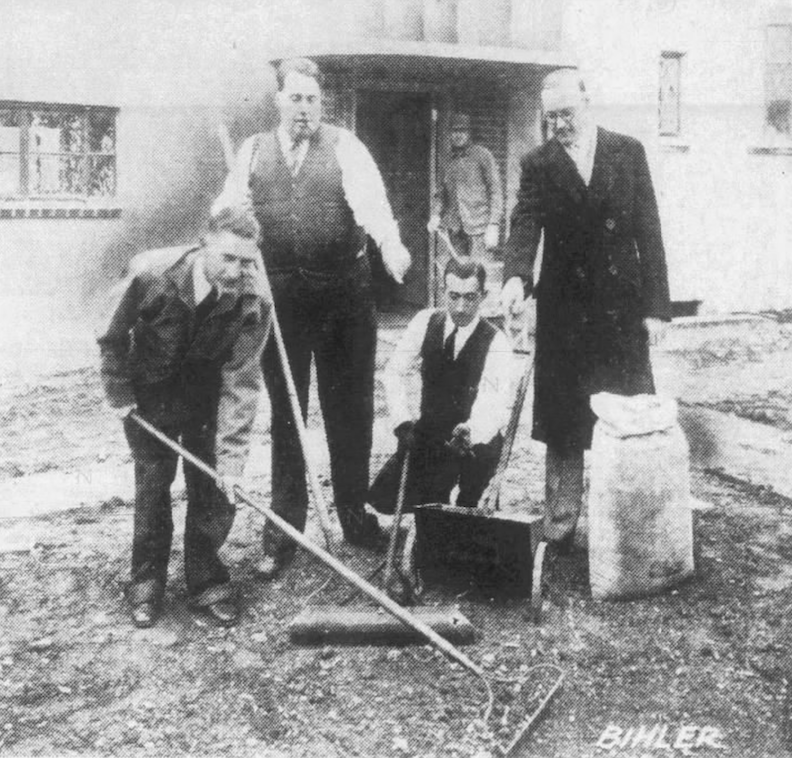
Hennig on a High. The Omaha Evening Bee-News November 1933. Prepping of the ground for the preview and housewarming of “the House of Tomorrow.” L-R: Junior Chamber President Dick Koch, Contractor Vic Peterson Jr, Charles Moorhead and R. F. Hennig.
His “House of Tomorrow,” Country Club Apartments (built in 1941, U-shaped Country Club Apartments build at 54th and Corby), the Frank Selby Apartments (built in 1942 at 830 S 37th , 3710 Marcy, 825 S 37th) and his Safeway grocery stores continued to define and move Hennig in a contemporary design path with emphasis on 1930s-50s modern innovation.
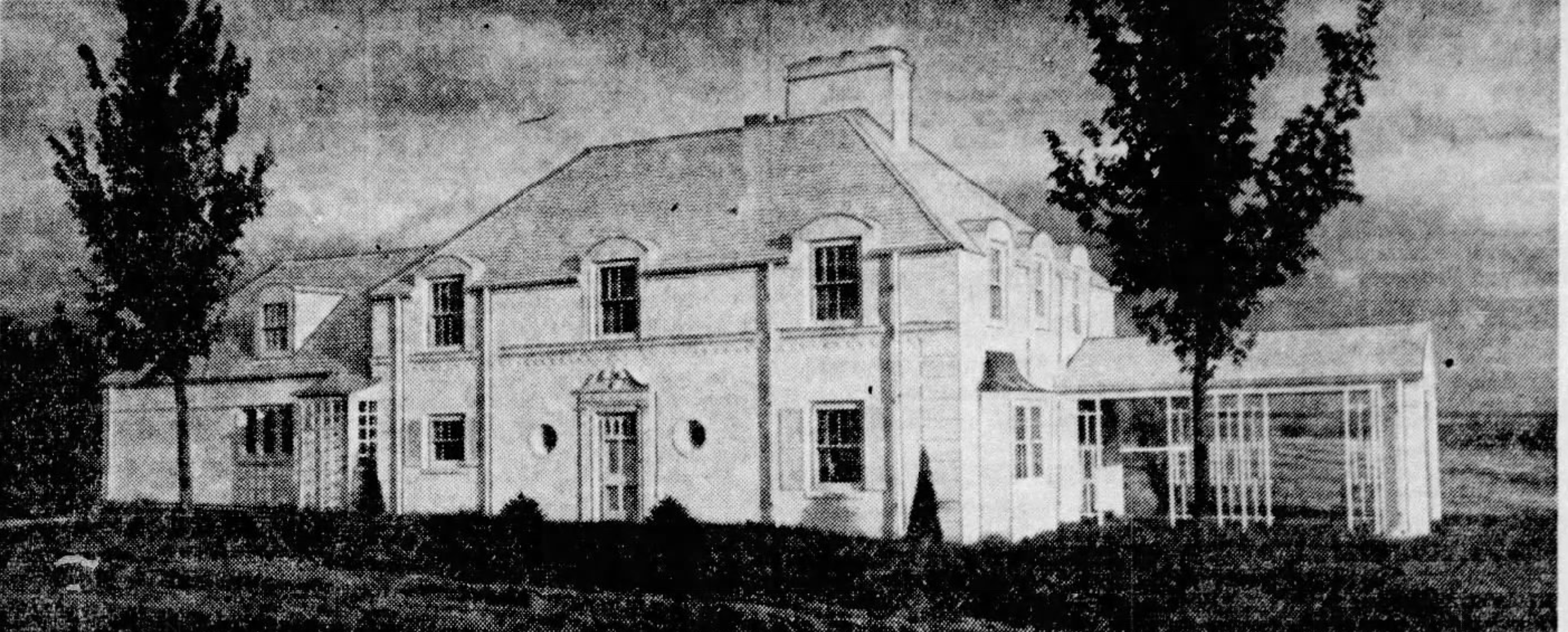
J. B. Low house (1937), 91st & Hickory. My goodness…..thank you, Mr. Hennig.
The Unseen File
My Hennig bent obsession continued as I forged on to find his undocumented houses, of which there were many. My belief that 1402 South 78th Street could be one of the untraced only grew. What follows are the Hennig homes not included on the formal Hennig list:
The O. H. Johnson house in Happy Hollow, “unique for its octagonal tower effect.” Address unknown.
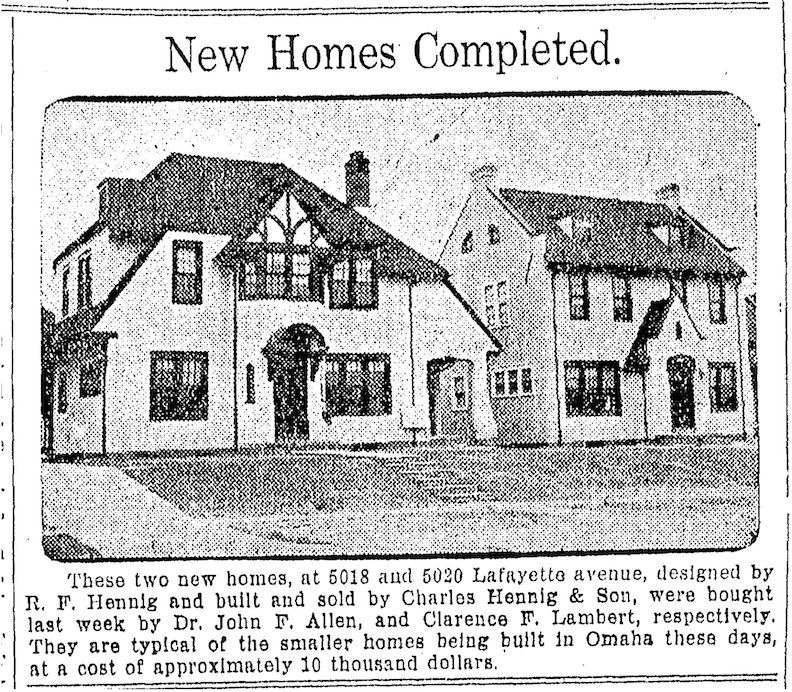
5018 and 5020 Lafayette Avenue were sister houses completed at the same time and advertised together in March of 1925, OWH.
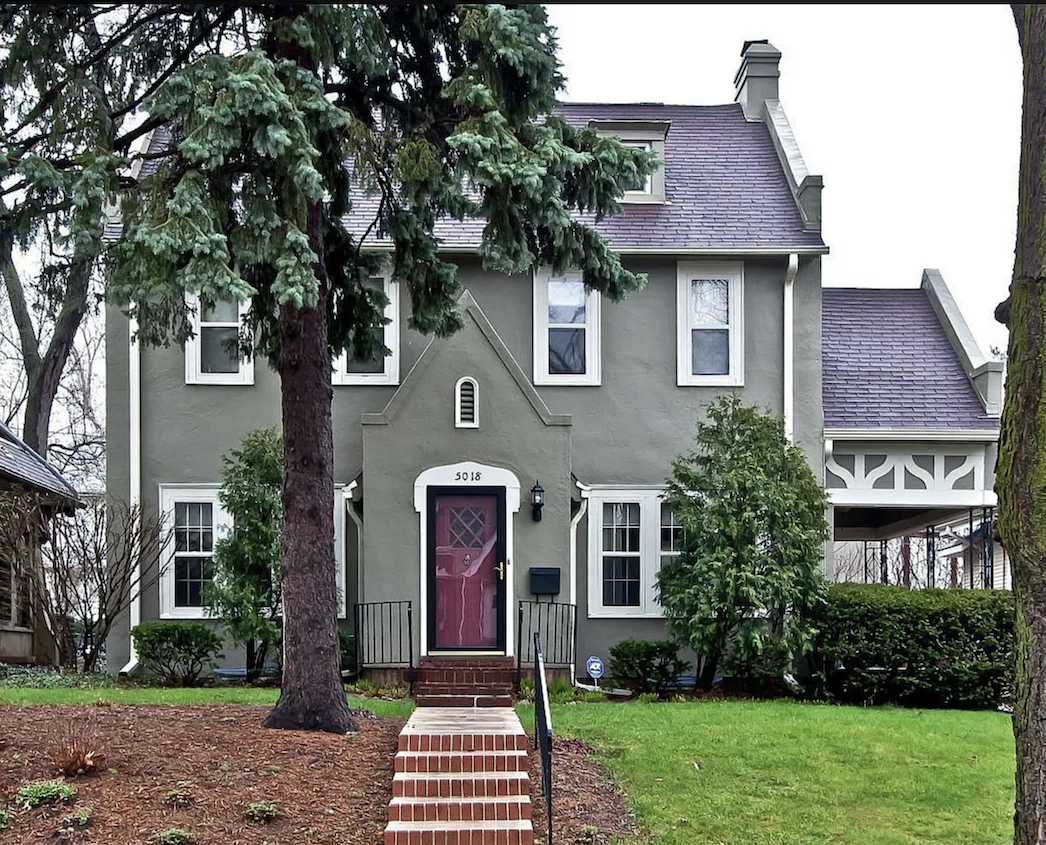
5018 Lafayette Avenue today.
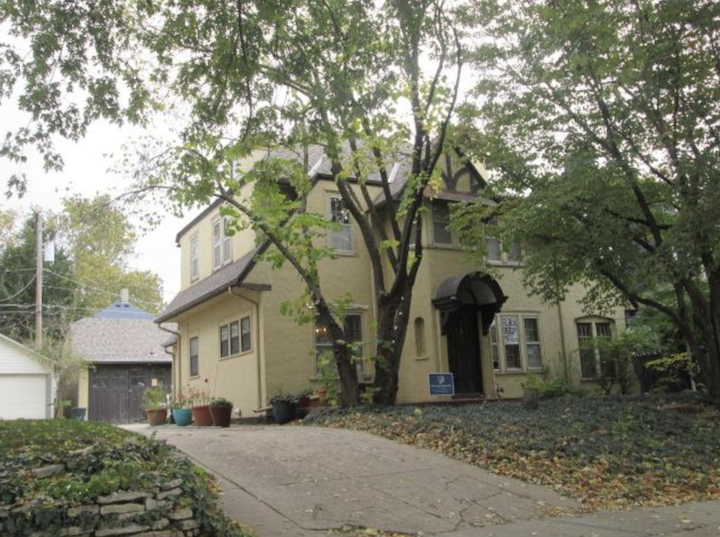
5020 Lafayette Avenue as she stands today.
1926 “Two other houses, both of American Colonial design are being built by Mattson & Smails in the Dundee district. R. F. Hennig is the architect.”
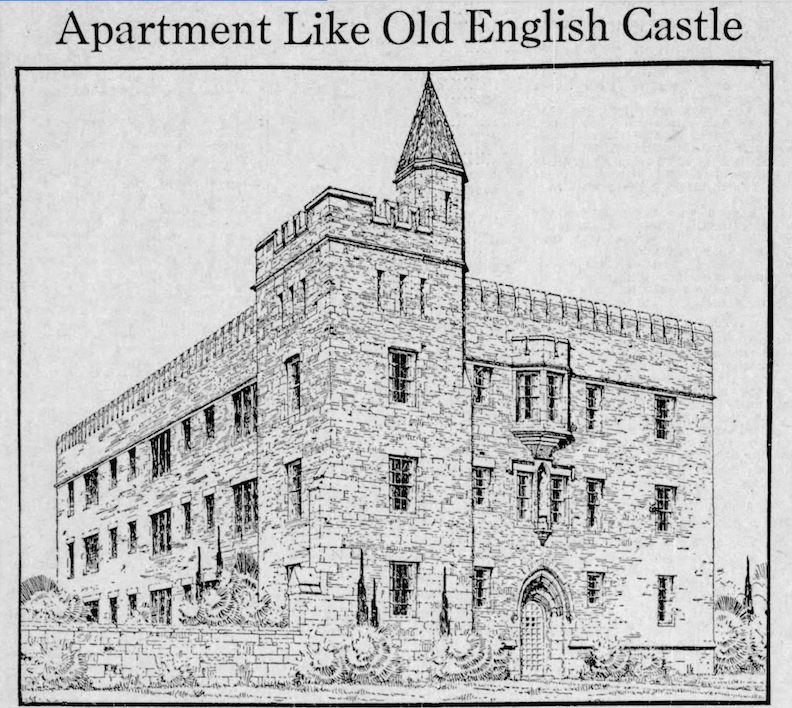
1929 large apartment complex on the southeast corner (later said to be the northeast corner) of 32nd and Dodge, since razed for the Mutual area or perhaps the Midtown Crossing plans.

2417 S. 105th Avenue was built in 1934—not documented. The house investigation that started my whole Hennig obsession.
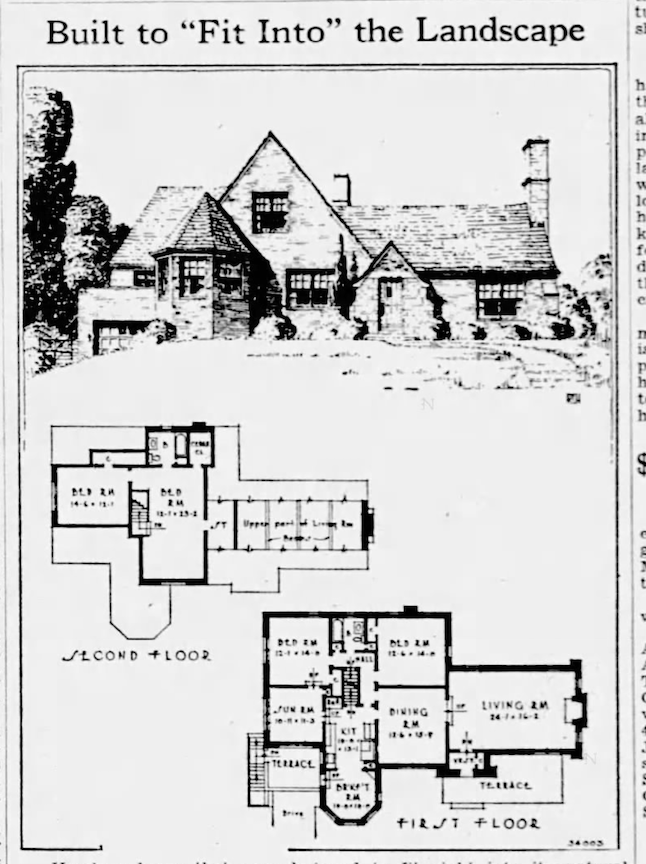
1934. Hennig built at 1402 South 44th Street for Bob C. Cooper, “Omaha rancher and cattle dealer.” At the time of Mr. Cooper’s tragic death in a horrific automobile accident in 1957, he was considered one of the nation’s biggest cattle feeders. The gracious home remains Absolutely Charming with interior photos very similar to our 1402 South 78th Street focus.
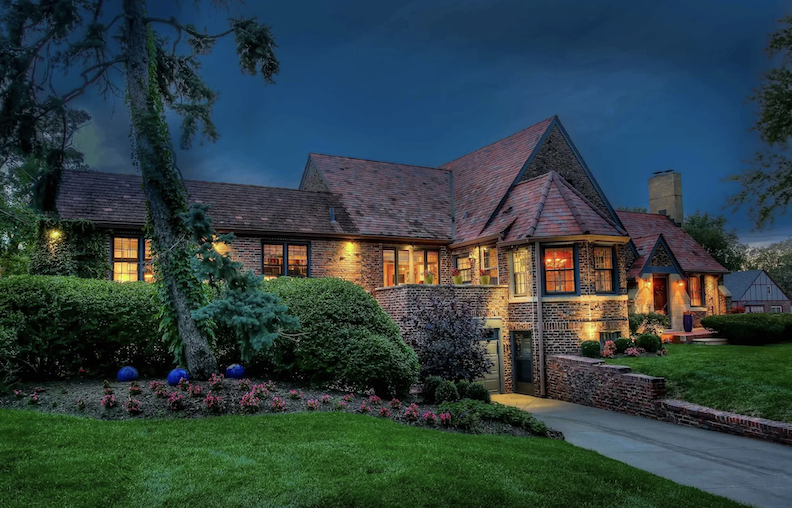
How Hennig’s 1402 South 44th Street sits today. Gorgeous!!
1934-1935 123 North 40th Street award winning home—nonextant. The Hennig family lived here for a while. Torn down to build a 1960s apartment building.

The William G. Murphy House at 10417 Rockbrook Road (Happy Hollow Road and Rockbrook Ave). Built in 1936. New England Saltbox designed by Hennig. “Early American type fireplace, located at the center of the house in the traditional manner will be of common brick over the opening with an enormous pine timber over the opening. Irregular common brick.”
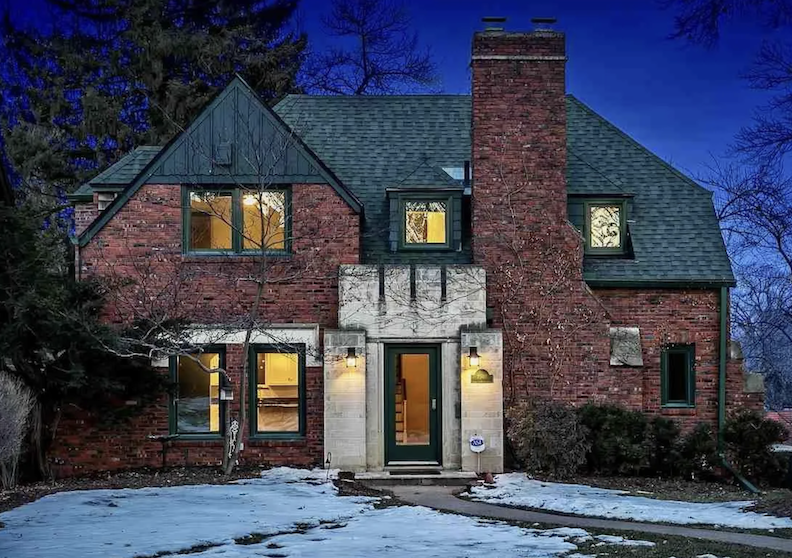
Hennig’s 2503 North 55th Street, built in 1936 is obsession worthy.
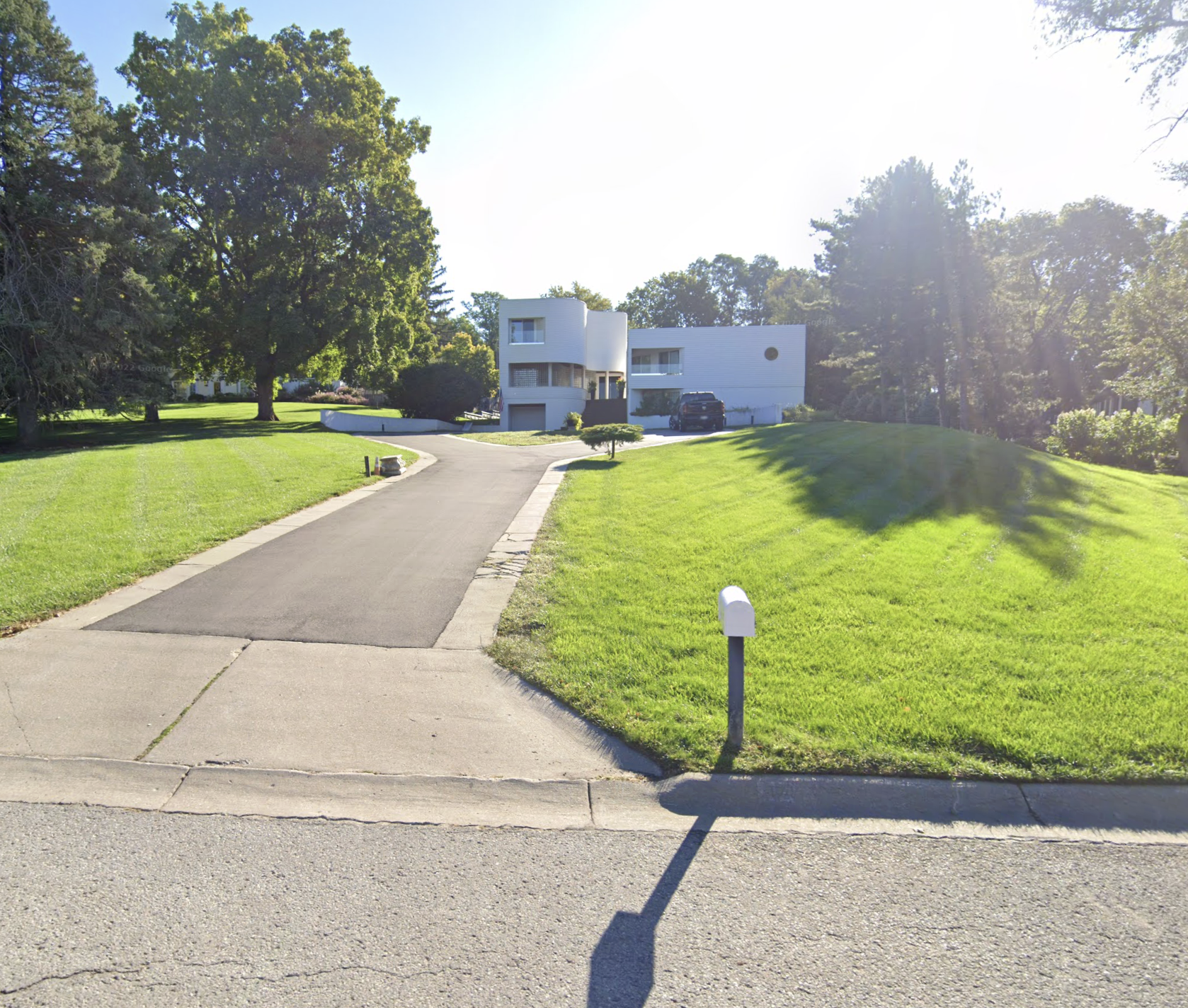
The Myron B. Hochstetler house at 419 Hackberry Road.

1940 brought the other “House of Tomorrow” on the J. E. Lange poultry farm north of Florence. Also designed and built by Hennig.
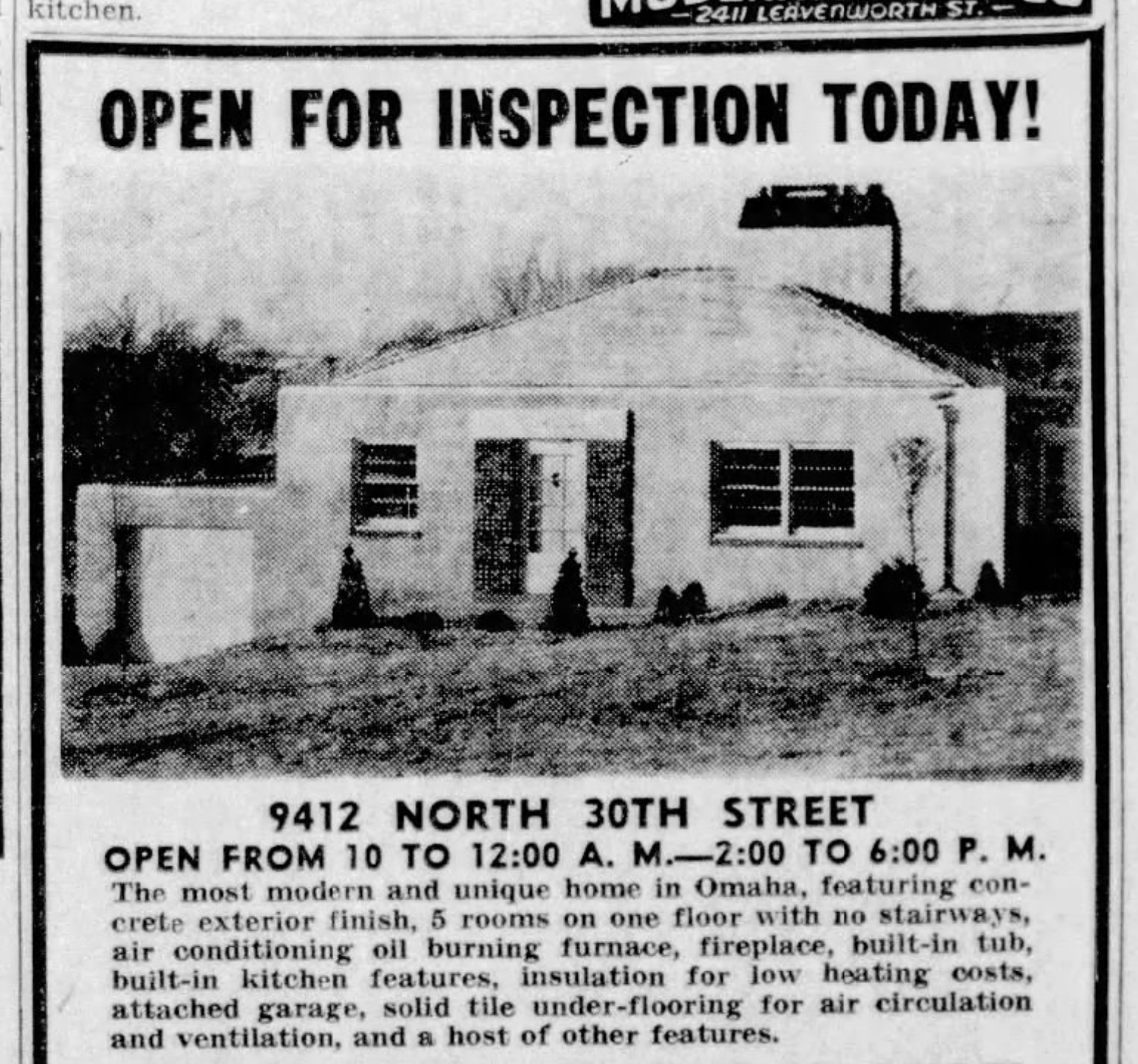
1938. The Mr. and Mrs. J. C. Plummer house at 9412 North 30th Street.
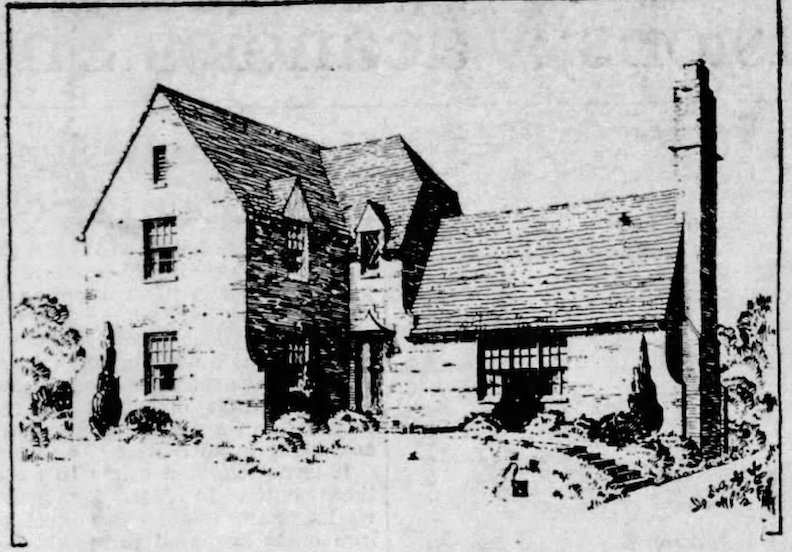
1936 A. B. Olson home at 308 South 53rd Street.
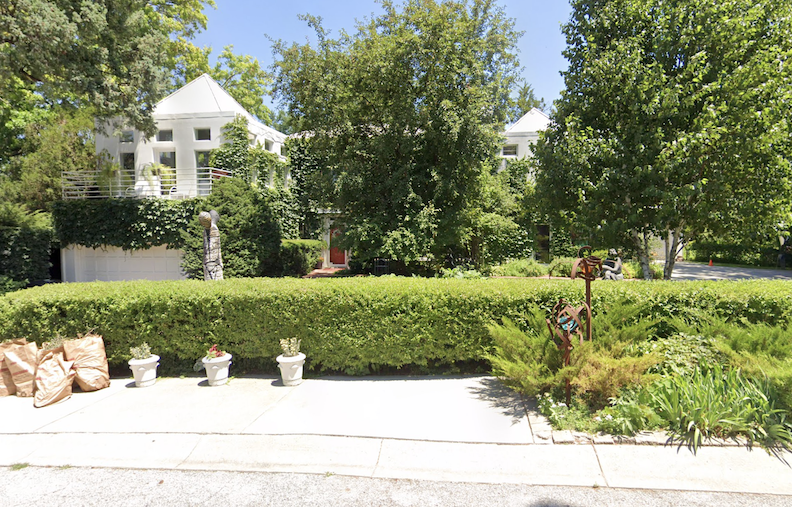
In 1936 Mr. Hennig’s Dr. Eugene Simmons residence at 607 North 65 Street was on display as a “demonstration home.”
1937 -The Robert Lasch home at 1599 Rockbrook Avenue.
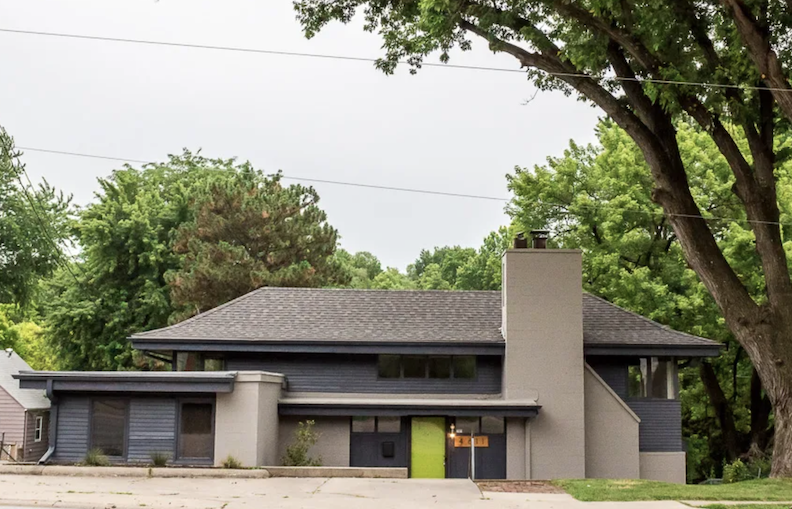
Purportedly 4611 Center Street is a Hennig, built in 1942.
The Red Herring
The American Revivalist Movement idealized the romantic French farmhouse and began sweeping the country. The 1920s and 1930s in little Omaha, Nebraska was no different with local architects emulating French country cottages and English Medieval-era village cottages. Similar to an English Tudor, the French Eclectic expressed decorative half-timbering, brick cladding, stucco, shingles, multipaned windows, country, plank-like doors with wrought iron hinges—all giving a sort of casual, asymmetrical presentation. This served to signal to passersby a piqued curiosity– are those the milkmaids quarters, where the cows sleep or is that a small grain silo? These eclectic mixes of European styles could be built in different sizes and price points. We were having a long distance romance with England and France. I believe I still am.
French Eclectic houses were rarely built before World War I and the ones that were built were of the more formal, symmetrical examples. French Eclectic mixed with English Tudor rose in popularity post World War I, then began falling from favor after World War II. Virginia Savage McAlester’s tome, A Field Guide to American Houses, suggested that “many Americans, among them both architects and builders, served in France during World War I and gained a firsthand familiarity with the broad spectrum of smaller French houses.” She further illuminated: “A number of photographic studies of modest French houses were published in the 1920s, giving a wide variety of model to draw from.” This is in part due to the mass reconstruction efforts of France’s war damaged historic villages. Savage McAlester went on to list the many award-winning American architects who made their bread and butter with their spin on the French house in the 1920s. “The attention and architectural awards given to high style French Eclectic houses made the style also desirable to local architects and builders during the 1930s.”
I began to consider that the 1980’s story told of Hennig– the architect traveling back to France with the critically wounded American soldier to acquire measurements and sketches of the French farmhouse might not even have occurred. Hennig possibly didn’t have to go to those lengths, if even a portion of what Virginia Savage McAlester detailed was true. Please know I am not disparaging my architectural crush’s legacy. His incredible body of work still stands the test of time. The most important piece is that we do not have Reinholdt Hennig on record having made these claims. In fact to the contrary, when interviewed about his designs, he did not even drive home the French factor.
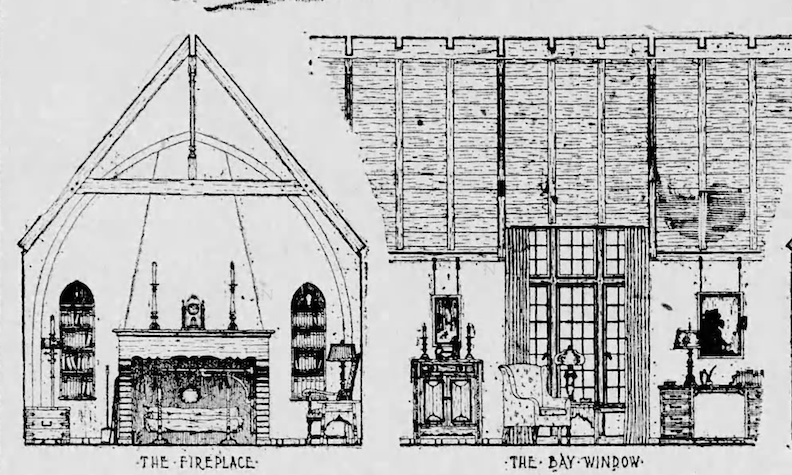
Hennig’s delightful 1927 sketches of his home at 715 J. E. George Boulevard. (Seen previously in the French Triplet photos.)
One such flag for me is the story of the magnificent 715 J. E. George Boulevard. This was supposedly the first of the French Fairytale Cottage triplets. If a soldier’s experience recovering in a French farmhouse inspired this architectural journey and was built for this client, why did Hennig build 715 J. E. George for himself, with no mention of travel or the commission? When recounting this home and his architect’s office that Hennig self reported to having built for himself in 1927, Hennig stated he hoped through using this medieval manner of construction, he could prove to locals that this style of craftsmanship costs no more than ordinary methods of building, and in fact, that he expected it to cost less. He wanted to show all woodwork, of heavy white pine timbers with no varnish of any kind. He believed the house demonstrated both French and English influence. All hardware made by a blacksmith and allowed to rust, “giving an antique effect.” Heavy planked floors, built-in bookcases, leaded glass windows, all beams and rafters exposed in the living rooms and main rooms, dining room has a flagstone floor.
In yet another article, this one from the World-Herald, October 12, 1969, the Hennig French trio storyline was a bit different. “The home is a replica of a French farmhouse of the early 17th Century, according to Mrs. Scott (homeowner). “ The Scott house was built in 1929 (My Omaha Obsession records show Hennig completed the house by 1927) by Reinholdt F. Hennig, an Omaha architect who died in 1961. Hennig built other houses in Omaha that were similar, ‘but this one was the first and the one he loved the most,’ Mrs. Hennig said. ‘We lived in the house for a year.’” She also illuminated that she didn’t think her husband intended the house to be strictly Norman or Old English. “It’s been considered everything. But I believe that Mr. Hennig considered the house a general European design.” She confirmed her husband was a “self-taught architect. He preferred European styles and studied many books about old-country architecture.” By the 1980’s the tale transitioned to him having traveled. Unless there are family members with specifics of this, I think that Mrs. Hennig’s earlier memory of her husband studying books of European style architecture along with Virginia Savage McAlester’s assertion might be closer to the actual history.
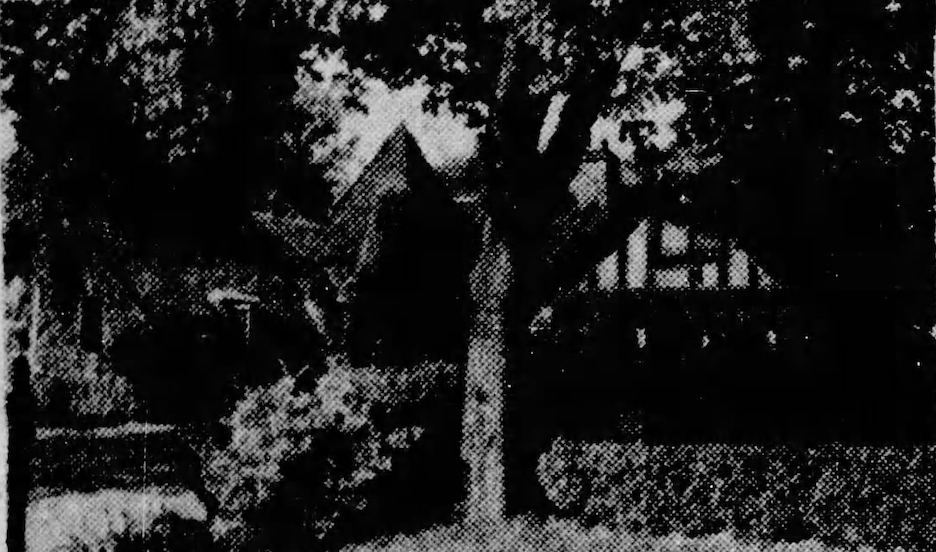
The incredible 808 South 67th Street as seen in 1945.
The description of the Henry “Scott” and May Wilber house at 808 South 67th Street, is mercilessly beautiful: Living room with fireplace at one end if of studio height, shingles laid irregularly, common brick exterior, chipped to give an antique appearance, few nails used, lantern above the door, “planked door, similar to doors leading in the old fashioned hayloft.” The dining room floor is of brick. In other rooms floors are of irregular slabs of varicolored marble. All interior woodwork is white pine. “Beams are exposed just like the Old English and French houses.” All work done by hand–the house contained no millwork. All fixtures and hardware were made to order at a blacksmith shop. It is interesting to consider that Scott Wilber was a building contractor. Not wanting to give up on the injured soldier story, I tried to research if Mr. Wilber had perhaps served our country in the First World War.
My Reinholdt Hennig Theory
Set back and nearly hidden by trees and shrubs on a winding road, built into the hill, I am willing to put money on Reinholdt Henning having designed 1402 South 78th Street. Was this beautiful home the missing quadruplet to the French Fairytale Cottage Triplets? I don’t believe so. I think she was their much younger, less idiosyncratic sister. Was there a fabled French farmhouse that Hennig sketched and designed from through the years after traveling with the American soldier? I think it was a great story but one that Hennig possibly never told. He most likely worked from books as we have learned many enamored and European-influenced American architects of the time did. Is the Windfall detail to the 1402 South 78th Street history real? It’s not looking good from my research.


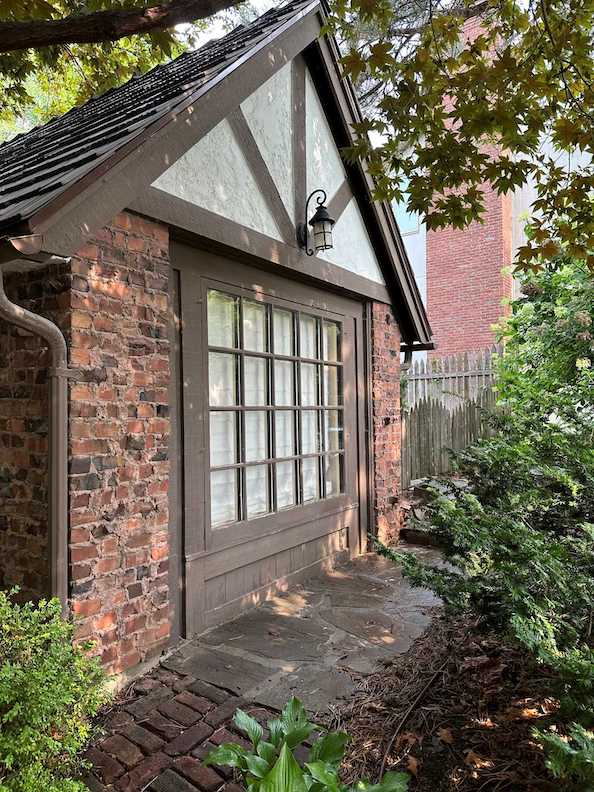
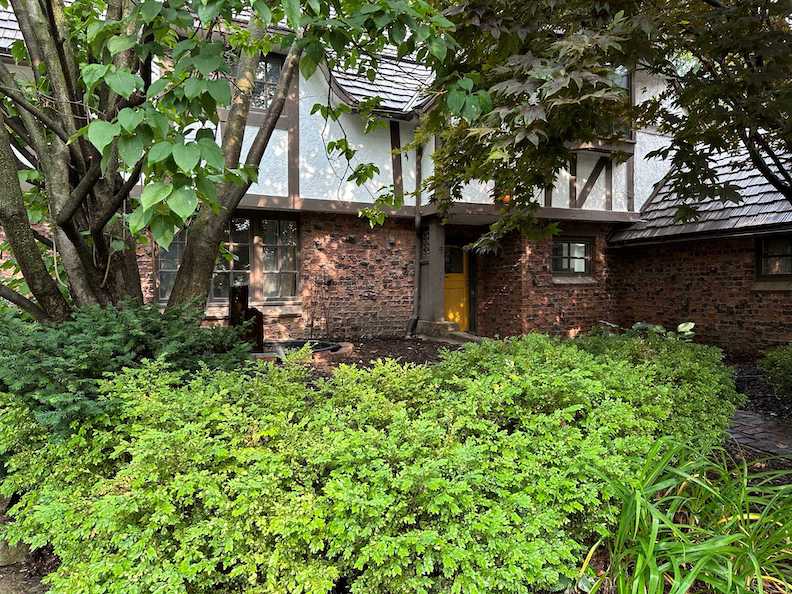
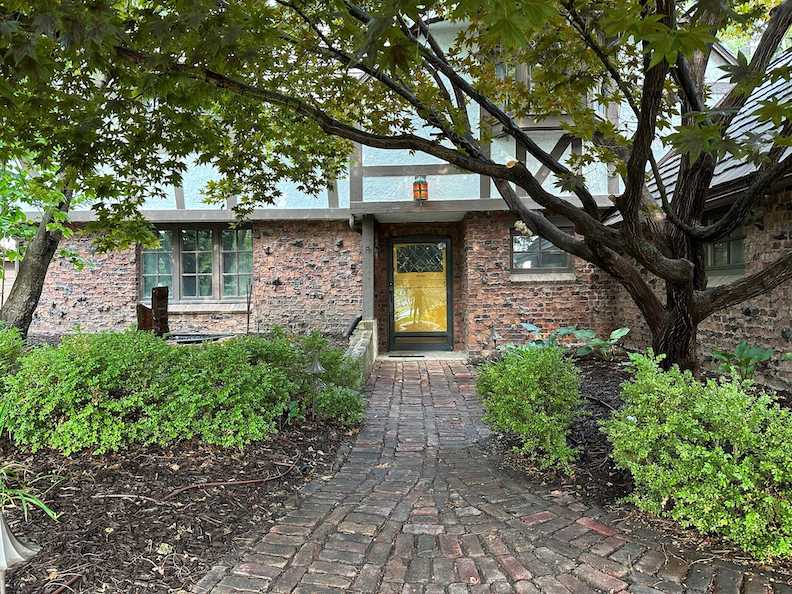
Exterior photographs of 1402 South 78th Street were taken by realtor Kirk Meisinger.
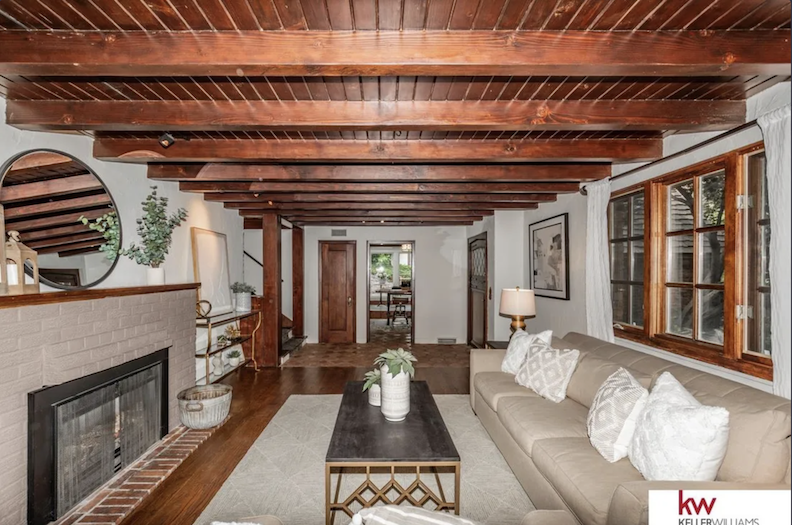
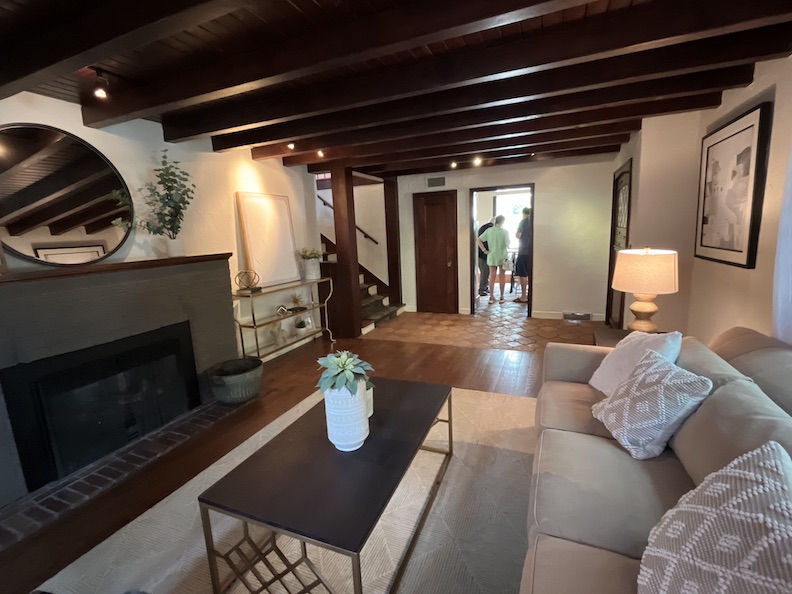
Scrumptious view of the living room taken by my friend, Matt Dillon, at the open house, July 23, 2023.
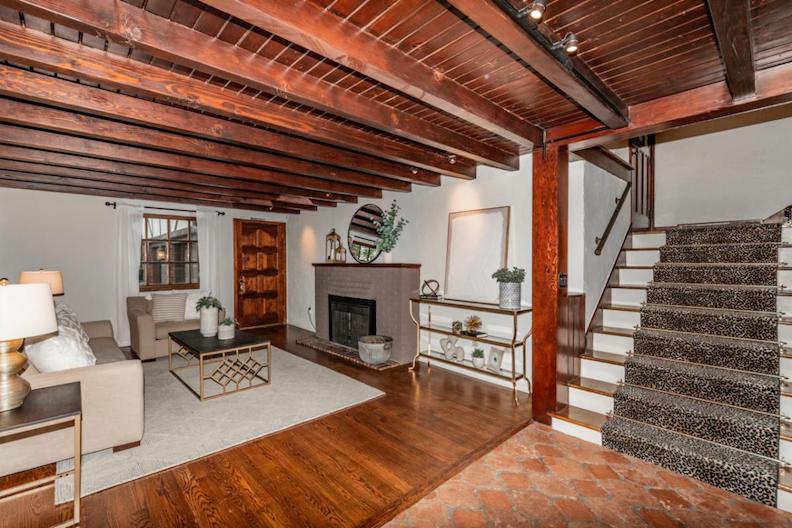
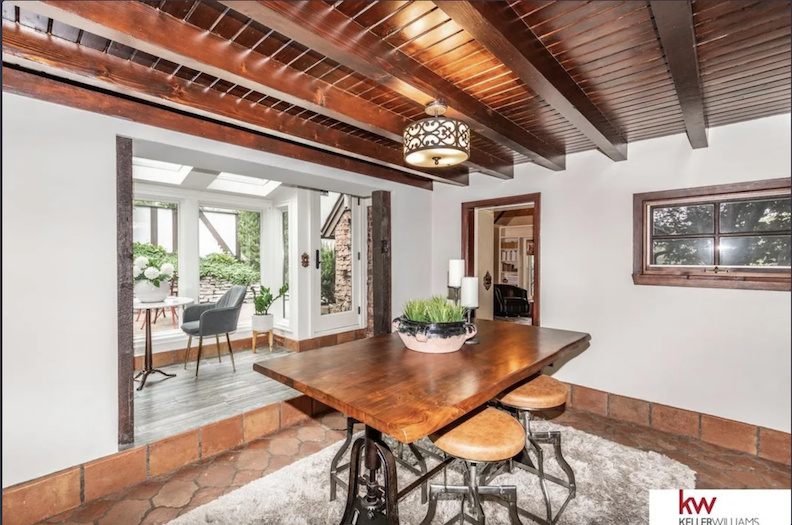
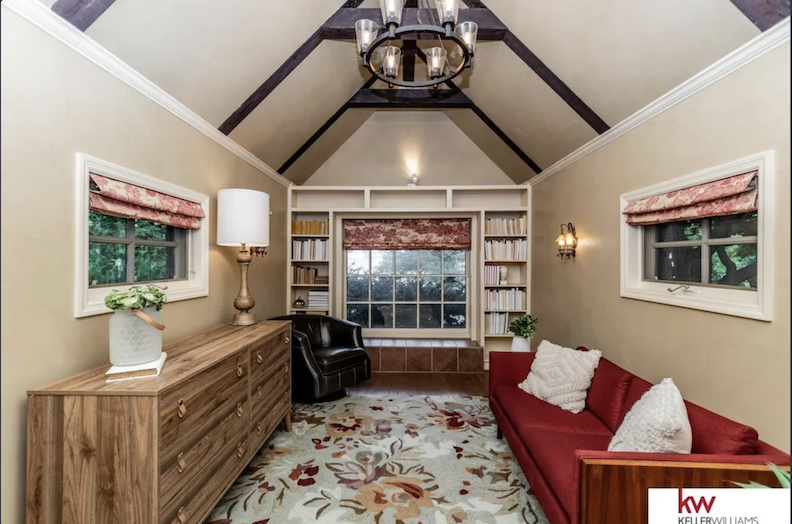
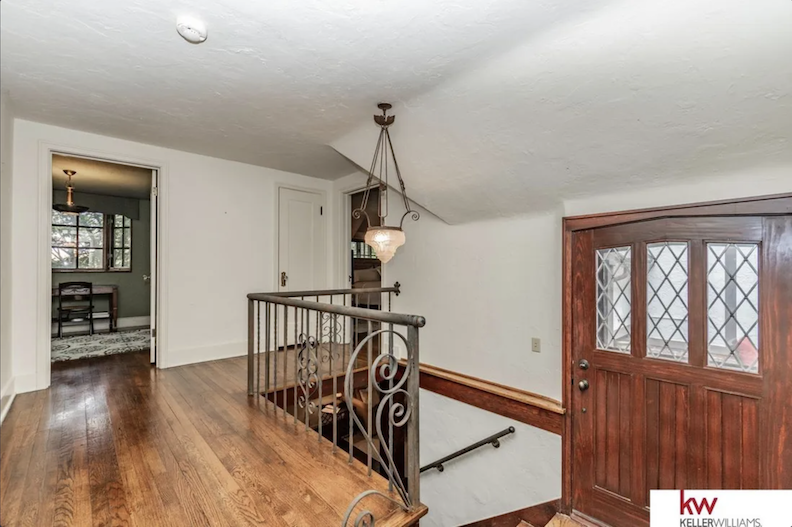
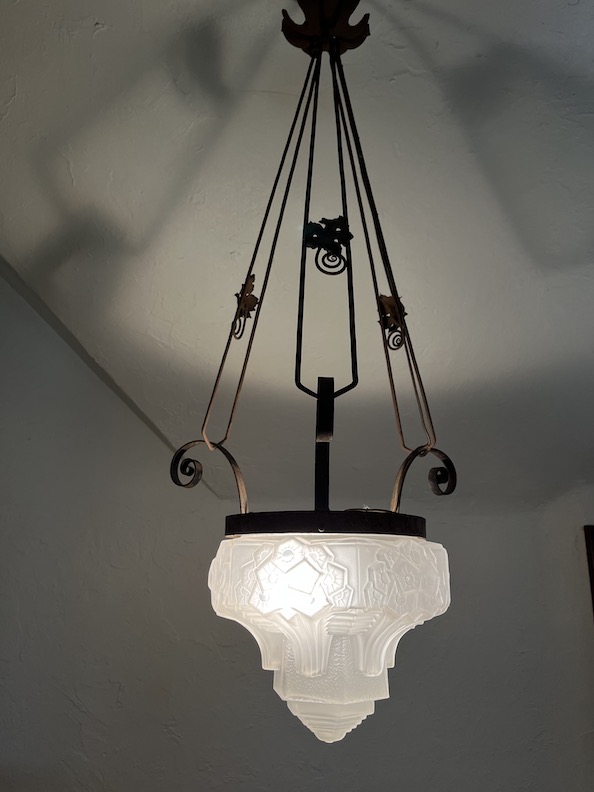
Detail of superb hall light taken by my friend, Matt Dillon, at the open house, July 23, 2023.
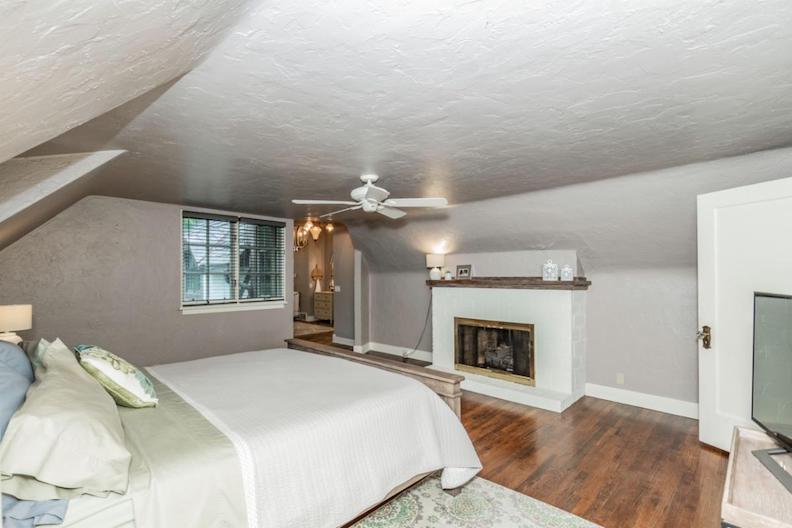
Beautiful new interior photos of 1402 South 78th Street.
Now let us compare these 1402 South 78th Street photos to other Hennig interior photos. I think the similarities are evident.
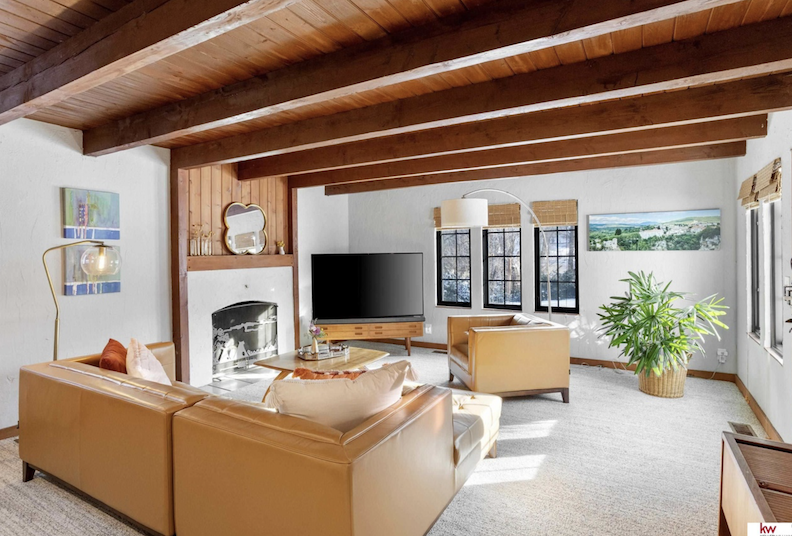
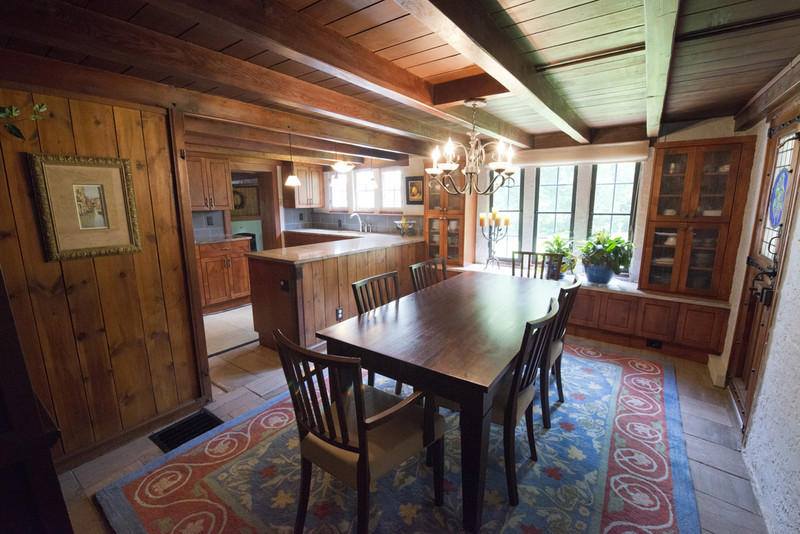
The beamed ceilings in Hennig’s 2417 South 105th Avenue living room and kitchenette are the exact same style as the living room and dining room of 1402 South 78th Street.
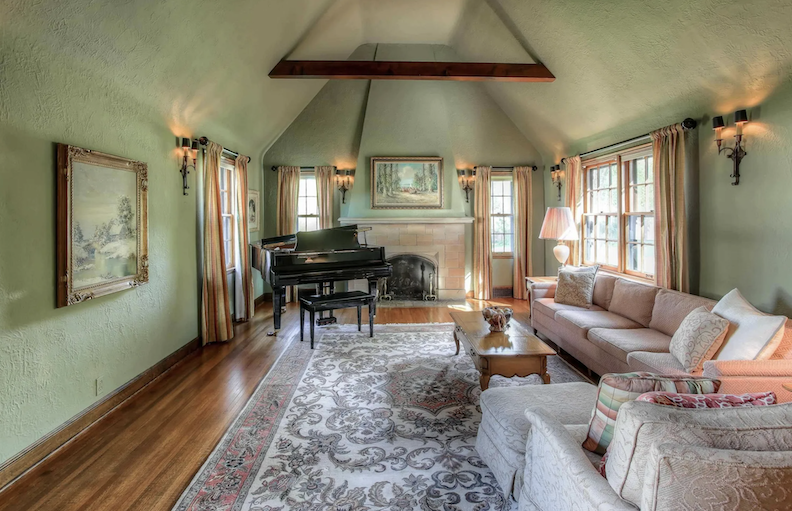
The living room in his 1402 South 44th Street home is quite similar to the library-family room of 1402 South 78th Street.
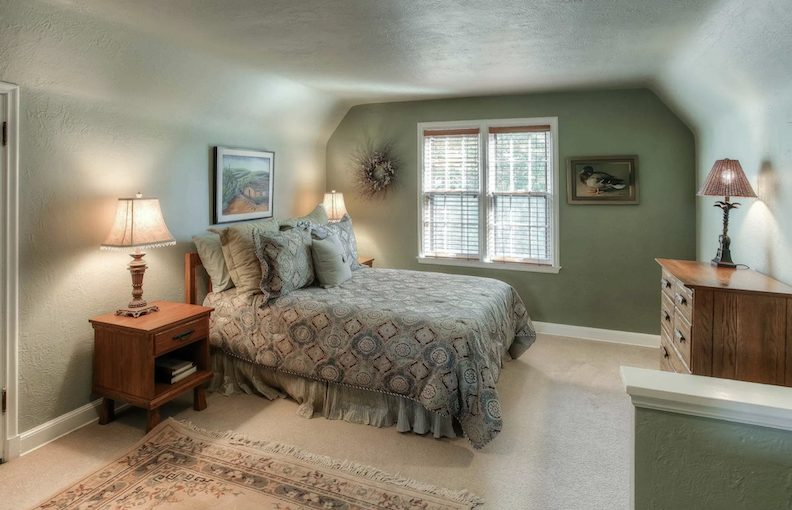
This cute bedroom in 1402 South 44th Street is very much in the style of his 1402 South 78th Street bedrooms.
This where you, my dear reader and group of rabid sleuths come in: If anyone has proof of Windfall by all means, please spill the tea. Do you know the history of 1402 South 78th Street? The 1402 Homeowners, Omaha architectural sleuths and I am open to anyone’s documents, rumors, historic photos, architectural archives, any bequeathed whispers or family shared “additions” to this mystery.
This has hands down been one of my all-time favorite spying missions. I thank you for joining me on this stake out. This investigation was fueled by coffee, Chris Isaak and Elvis Costello. It was inspired by the Mr. and Mrs. 1402 Homeowners (thank you for the original query and for trusting me), Miss Belle West, and of course, Mr. Reinholdt Hennig.
Take care,
Miss Cassette
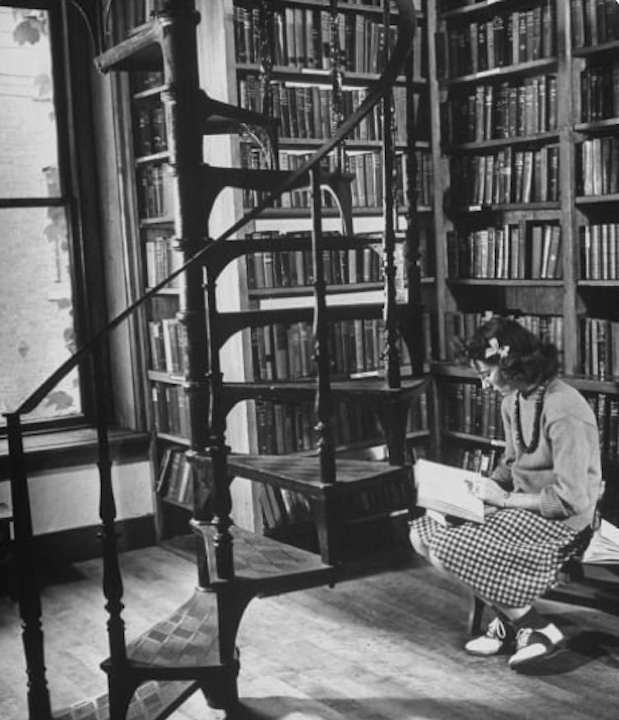
Attorney/broker Kirk Meisinger and his Meisinger Group will list 1402 South 78th Street this coming Friday. This beauty is for sale. Please contact him for your showing: (402-201-8311). I was not paid to conduct this investigation.
I welcome your feedback and contributions to the 1402 South 78th Street–Reinholdt Hennig article. Are you a past owner? Are you an architect or realtor who has the facts? Does you great auntie keep copious notes from the Loveland area? Also do you live in a Hennig and want to join forces? Don’t be shy–let us know about your Hennig and go on the record. Feel free to share thoughts in “Comments.” If you’d like, please share this article on social media, through email or texts to friends, and join the My Omaha Obsession FB page when you can. I hope you can find some enjoyment here. I am more than pleased to have you tiptoe about. By the time you head for home, I hope you have been fully Sherlocked and Satiated. Thank you, detective friends.
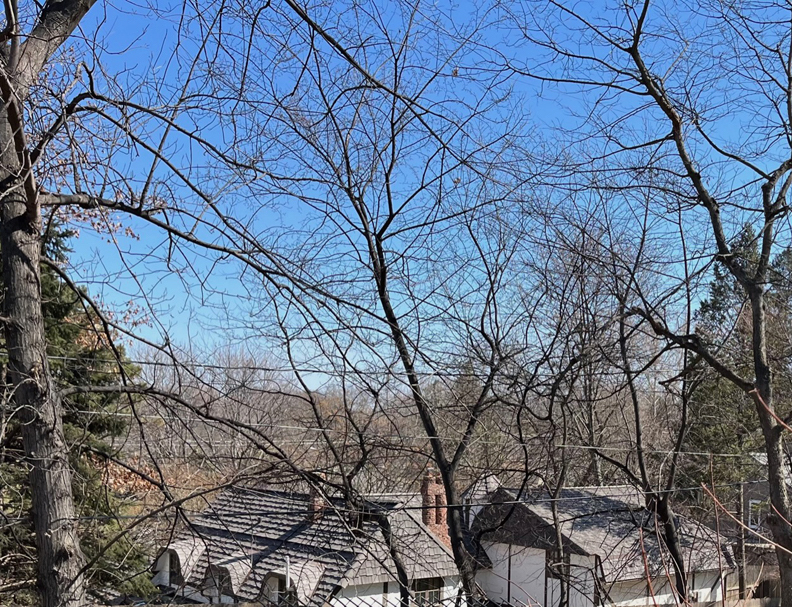
If you like what you see, you can keep up with my latest investigations by joining my email group. Click on “Contact” then look for “Sign me up for the Newsletter!” Enter your email address. It will then display “Thank you, your sign-up request was successful!” Make sure to check your email address to confirm. You will get sent email updates every time I have written a new article.
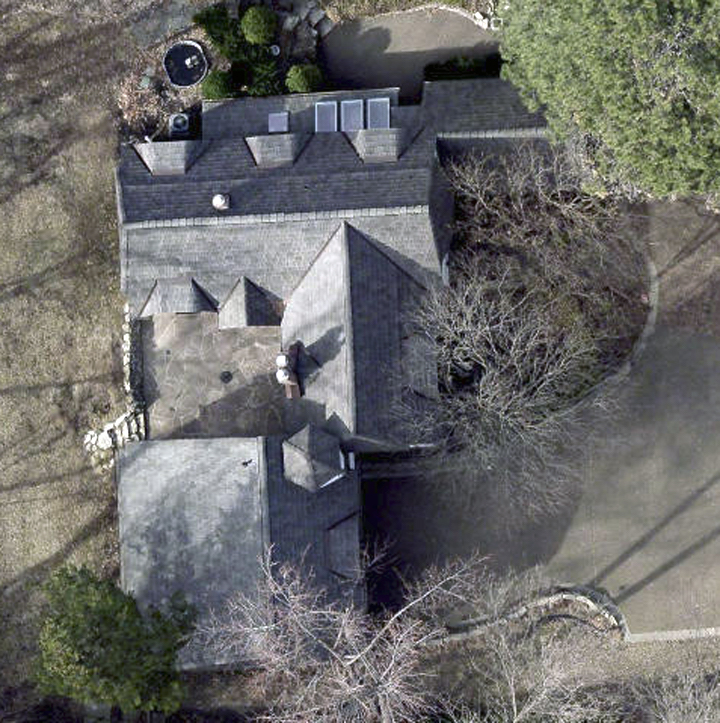
© Miss Cassette and myomahaobsession, 2023. Unauthorized use and/or duplication of this material without express and written permission from this site’s author and/or owner is strictly prohibited. Excerpts and links may be used, provided that full and clear credit is given to Miss Cassette and myomahaobsession with appropriate and specific direction to the original content.

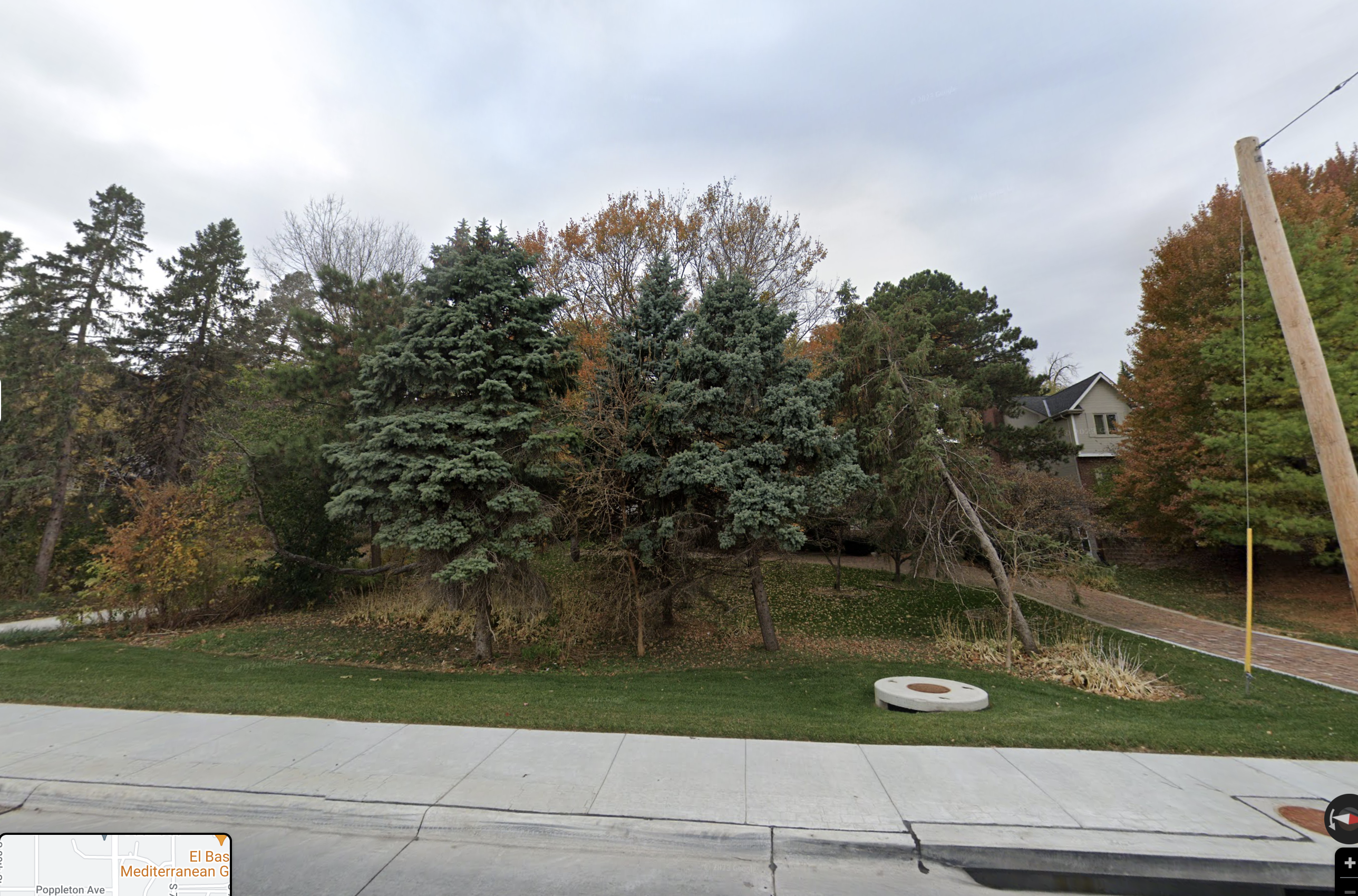
Google Map tells the tale. Hidden Glory. No one knows what is back here but us!
If you are looking for more architectural and Omaha history sleuthing fun, ask your local or big box bookseller for my book: My Omaha Obsession: Searching for the City. You can also order it through this website. Thank you.




Golly, that was some good sleuthing! I’m glad R.F. is getting some recognition. I was under the impression that it was Hennig who had the nickname “House-A-Day”, not F.A. Henninger?
My neighbor’s and my house are Hennig houses, built in 1924-5(?). They both have an all stucco exterior with different roof lines and front porches – but have the same floor plan. If Hennig were still alive today I would ask him why he designed the stairs to the second floor so narrow that even a twin size mattress barely fits up them? Thank goodness the main bedroom has a walk-out deck to hoist larger bedding (and furniture) into the house… I think this feature may illustrate his purported lack of formal training as an architect. 😉
Another Hennig house that may not get credit is 4611 Center St. It’s in one of those “if you blink you’ll miss it” locations. It has one of the most fascinating interiors and is currently owned and occupied by a local Omaha artist.
Hello! Yes it was absolutely “house a day Henninger” and I could’ve sworn you were the one to tell me that. Henninger contributed massively to Omaha and built many public buildings. Classic buildings. Solid buildings but I don’t obsess about him. Much more well-known. The Hennig houses are all unusual and include many mysteries inside. We do not have a Hennig house or a well-known architect. I believe our house was builder designed. But we have that same tiny staircase with very shallow steps. knee and ankle breaking. But I figured out it’s because it was an attic. Someone removed the door at the bottom of the stairs and tried to make it an open stairwell in the 90s. But like you, forget about getting a larger mattress up the stairs.
I will look for that center street house. I believe I know just the one you’re speaking of!
I stand corrected – twice. I had a quick check of the Nebraska State Historical Society’s entry on Henninger – and indeed he has the “house-a-day” nickname. I had mentioned to someone at a Restore Omaha Conference years ago that my house was a Hennig house, and they used that nickname in error – hence the similar last name throwing people off.
My house and my neighbor’s house have walk-up attics with the same width (but possibly steeper) staircases, and an original ad for the houses in the Omaha World Herald makes mention of the attics being capable of being made into living space. In the case of my house, it wouldn’t be terribly comfortable without some major remodeling, but my neighbor’s house has two front-facing dormers which let in light and create more space – and it in fact has been made livable (but dependent on separate heating and cooling). These houses have to me more of an English flavor to them rather than French – I use “Tudor eclectic” to describe mine and “Georgian” might be used to describe the neighbor’s.
I’m one of the lucky owners to have the original abstract for this house. Charles and Anna Hennig are listed as one time owners of the property (C.L. Hennig listed as Notary Public(!) and the building permit lists Chas Hennig & Son as owners, and R.F. Hennig as the Building Contractor.
As I understand, some city employee inadvertently threw a lot of abstracts away as they were deemed “obsolete” :-/
Amazing!! Very cool that you’ve got Charles and Anna’s name on that doc and very interesting that Reinholdt was listed as builder. So glad you saved those. We have ours also. Yes, early on in my adventures I was down at the city building and a woman let me know that many neighborhood developments’ house plans and building permits had been thrown away. Sad oversight. Reminds me of attitudes towards the library and archival materials. It is hard to impress upon some people the importance of keeping old originals and even harder to get some folks to learn how to care about things of which they see no intrinsic value to their life.
The 1402 S 78 story is your best one yet. Thanks so much for your diligent pursuit of the the history.
You don’t know how much this comment means to me. I have enjoyed every moment of it for months and I felt it was my best contribution to Omaha, even though it was frustrating. Thank you for the recognition.
Miss Cassette….I completely love this article! I have ‘pet’ houses that I visit occasionally. The three French Cottages are top of my long list. My Mother, an antiques dealer, was friends with another antiques dealer named Walt Cady. He told her that his father was a blacksmith and had done all the metal work in these three cottages.
Reading your latest & just wanted to tell you my former house, 1318 So. 78th Ave, lot was also sold by my grandfather & grandmother, Daniel & Cornelia Cary, to Nellie Ringer. When I got the title in 2000 saw sold to her in 1928. Cape cod style House was built in 1939. Ironically my grandfather built a cape cod house in 1939 on 600 So. 93rd afew house south of Harney. My Mom & Dad were married in house June 13, 1942. My grandparents lived there until her death in 1958. Janet Hollander Ferlic grew up in house. Lyn & John Ziegenbein raised their son in house.
I grew up in Omaha and have always had a great love of the city even though I moved away 37 years ago. Finding your website has been a great joy to me. I do wonder, if the Ringer’s bought lots 3 and 10 in Jan of 1932 and sold lot 3 to the Willmarth’s in December 1939, what land did the Ennis’ sell to the Lydecker’s in July 1932? Also, do you think Belle West is the one who purchased the property at auction? SO MANY QUESTIONS HERE!
I love this article and am rereading it now in the living room of 1402 s 78th St. We are still in the process of moving; with one foot in the (probably) Henig home in Loveland and the other in a Field Club Henninger home. I’m passionate about historic preservation and restoration, and your pictures of other Henig interiors will help me greatly as we restore this charming home.
Damn, Hennig with 2 n’s I meant.
I live at a Hennig property not listed here! The Arlington Manor in Dundee – 4907 Davenport. It is so fun to see the similarities in details of other properties both interior and exterior. I am proud to be in a Hennig home. Currently working on getting this registered as a historic building.
Thank you so much, Samantha! I will get this info added into the article and I will credit you. I appreciate it!